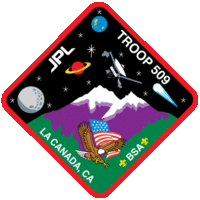Past High Adventure Outings
Sea Base 2024 |
|---|

Boys Crew front l-r: Kieran F., Max K., Evan C., Miles L., Winston W. back l-r: lead advisor Mr. Ron Chiu, Will K., Dr. Kristopher Kallin 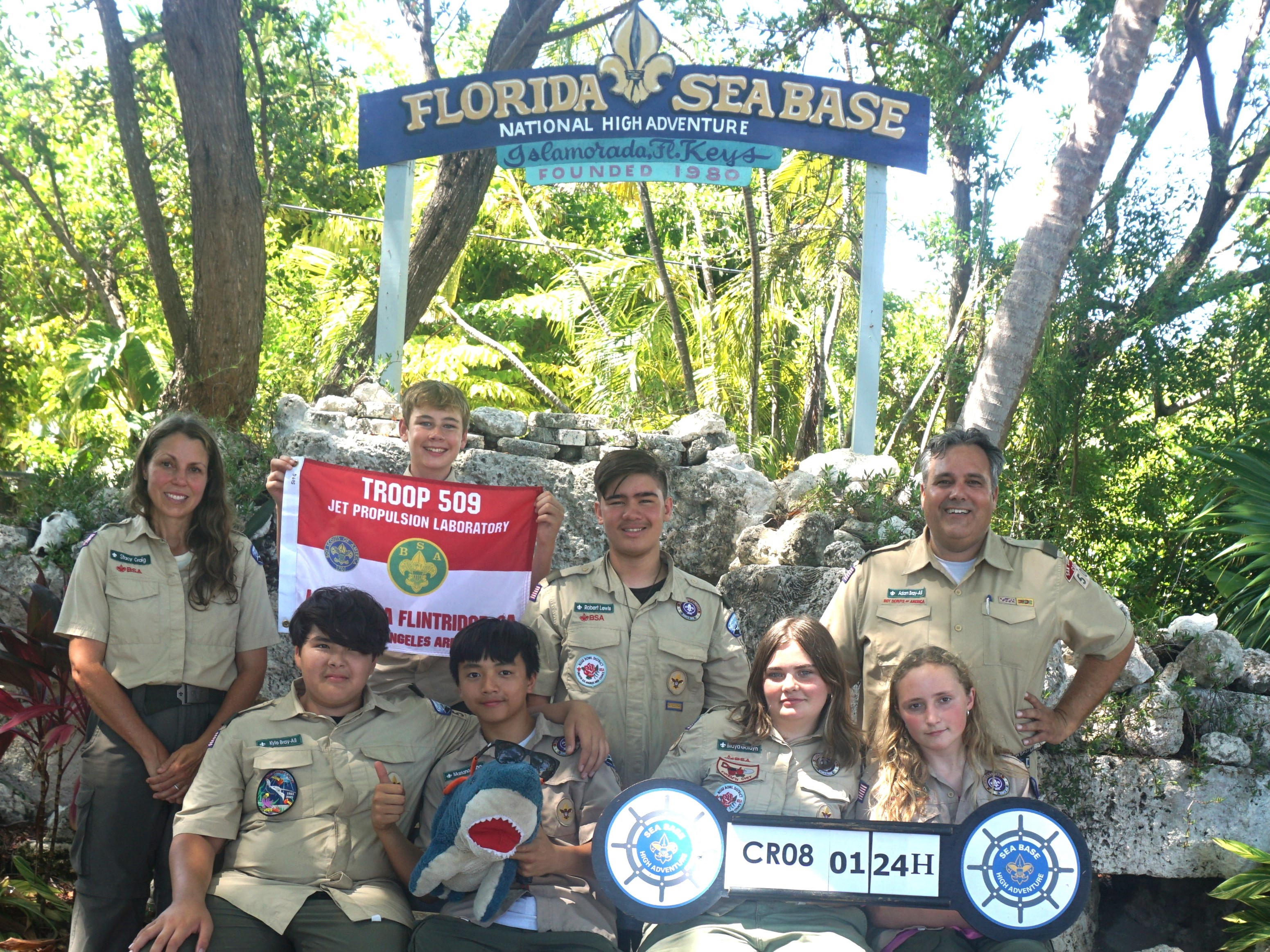
Coed Crew front l-r: Kyle B., Mariano L., Maya G., Addie C. back l-r: Mrs. Stacy Craig, Nick W., Robert L., lead advisor Mr. Adam Bray-Ali Jul. 31-Aug. 6, 2024 We were 12 scouts and 4 adults in two crews, both doing Coral Reef Sailing on 40' sailboats. We left Burbank on a 7 pm American Airlines flight to Phoenix, ate dinner in the Phoenix airport, then took a red-eye to Miami, arriving at 6 am. We took the MIA Mover to the nearby car rental center and picked up two 8-passenger minivans. We drove around Little Havana a bit and ate pastries for breakfast at Versailles Cuban Bakery. Then we drove to Everglades Alligator Farm in Homestead where we explored the Everglades on an airboat, saw an alligator show and held baby alligators. We drove to Tavernier for a pizza lunch, then on to Islamorada where we saw Hemingway's boat Pilar and fed tarpons at Robbie's. Sea Base was just a short distance away in Islamorada, which is about halfway down the Florida Keys. We arrived at Sea Base at 2 pm, and after snorkel check, boat loading and eating dinner, we departed on our boats. The all-boys crew sailed on the __ with captain __, adventure CR080124D. The coed crew sailed on the Wanderer with captain Chuck __, adventure CR080124-H. Both crews sailed five nights mostly in the Florida Keys National Marine Sanctuary, with a mid-week shore visit to __ in __. Among the places we snorkeled were __. We saw many different sea creatures, including __. Sometimes the two crews met up to snorkel and cook together, and also shared anchor watch duties. Temperatures were in the high 80s during the day and low 80s at night, with high humidity both day and night. It rained __ thunderstorms __. We did some fishing, successfully. On our shore visit we showered, visited a grocery store and barbecued steak for dinner. Each boat traveled about __ miles, mostly under sail. On our last day on the water we returned to Sea Base at 9 am, cleaned the boats, showered and changed into our class A uniforms, then left for the Miami airport. Our 2 pm flight on Southwest had layovers in St. Louis and Las Vegas, and we arrived back in Burbank at 9:30 pm. The cost was $__ ($1,200 to Sea Base, $365 for plane, $__ for rental vans and tolls, $60 for mask & snorkel, and $__ for the crew shirt, duffel bag, sheet sleeping bag, travel comfort kit, alligator park admission, pizza lunch, tarpon feeding, sunscreen, insect repellent, crew photos, patches and tips & troop t-shirts for captains). The trip was organized by Mr. Haxton. |
Summit 2024 |
|---|

l-r: Mr. Rob Pooley, Dr. Michelle Kolsi (Gregorian), Jack B., Cole Pooley, Robby Siegmeth, Will K., Nathaniel Llana, crew leader Oliver Barr, Sarineh G., Teddy Scharlotta, Izzy S., Alejandro Leyva, Ann Turner, Dr. Justin Boland, Ms. Jean Yang (Scharlotta), lead advisor Mr. Andrew Shapiro-Scharlotta Jul. 25-Aug. 1, 2024 We left Burbank on a 7 pm American Airlines flight to Phoenix, ate dinner in the Phoenix airport, then took a red-eye to Charlotte, NC, arriving at 6:30 am. We picked up our rented Chevy Suburban SUV and Toyota Sienna minivan and drove 215 miles to Beckley, WV, where we ate brunch at Cracker Barrel. We then drove the final 15 miles to Summit, arriving at 1 pm. After checking in and having our paperwork reviewed, we met our trip leader, Emilio Diaz, who assigned us to tent cabins. We were Adventure no. NR072624-BC. Later that afternoon we met around the tent cabins with the three other units joining us on the river, Troop 3 from Chico, CA, Crew 652 from Brecksville, OH (near Cleveland), and Crew 236 from Covington, KY (near Cincinnati), a total of 40 scouts and adults. The scouts elected Oliver Barr as the group's crew leader. The guides assisting the trip leader were Josh Malina, Alissa Schaefer and Christian Kincer. We were each issued two dry bags, 110 liter and 5 liter sizes, and instructed how to pack. We were also issued pop-up tents which were wet from much rain the previous week and we aired them out before our trip. We were advised to bring extra dry clothing as there was rain in the forecast. Anything we weren't taking on the river we stored in the rental vehicles. After dinner in the dining hall we went to Summit's activities area where we did mountain biking on a series of trails, and rode a zipline, then retired for the night. The next morning after breakfast we got on a bus for a two-hour ride to our starting location. We would be kayaking and rafting 51 miles on the New River as it passes through New River Gorge National Park & Preserve. The gorge is 1,000' deep with the river at the bottom. We would begin at Hinton just below Bluestone Dam, and end near Fayetteville. The first four days we would be in individual inflatable “ducky” kayaks, and the fifth day in 8-person whitewater rafts. Our 110 liter dry bags, along with tents, cooking gear and food, would be transported by truck on a gear trailer to each campsite. While we were on the river, the flow rate, controlled by the upstream dam, was typical for the season, varying between 2,600 and 3,900 cfs. Two weeks earlier, the flow rate had dropped to nearly half of normal, which resulted in those crews having to paddle an additional two hours each day. On our first day we initially did a series of river safety exercises, then paddled 11 miles to Meadow Creek and camped in a field next to the river. The second day we paddled 13 miles to Terry Beach, camping on a beach next to the river. At Terry Beach we did some conservation work by removing non-native bamboo next to the campsite. The third day we paddled 10 miles to Stone Cliff, camping high up a steep slope where there were platform tents. The fourth day we paddled 9 miles to a spot near Cunard, camping at River Run Park in a field a distance away from the river. At each campsite we unloaded the gear trailer and set up a kitchen, with the scouts cooking dinner and breakfast on propane stoves. During free time we played cards and checkers, and we ended the days with a campfire and the sharing of Roses, Thorns and Buds (aka highs, lows and horizon line). During these four days in kayaks we ran six Class II rapids and seven Class III rapids. At each rapid we formed a "ducky line" and followed the guides through as they showed us the approach that would maximize fun. At two of the rapids we also swam through the rapids. Between the rapids there were long stretches of quiet water where we occasionally stopped to swim and make ducky towers to jump from, all while wearing our PFDs and shoes. We also jumped into the river from Jump Rock, hiked through a tunnel and up a trail to a hidden waterfall, toured a ghost town at night, and at the closing campfire used branding irons to brand hats and other items. On the fifth day we switched to 8-person-plus-guide inflatable paddle rafts for the 8 miles of the Lower Gorge. The rafts and guides were from Ace Adventure. Our 16 troop members were on two of the five rafts, with guides Hunter and Etienne. The rapids in the Lower Gorge were larger and more numerous than the previous days, with two Class II rapids, seven Class III rapids and nine Class IV rapids. We ended the run under the iconic New River Gorge Bridge, the longest single-span arch bridge in the world when it opened in 1977 (3,030' long with a 1,700' main span and 876' tall -- for comparison, the arch bridge by Hoover Dam is 1,900' long with a 1,060' main span and 890' tall). A 30-minute bus ride brought us back to Summit in the early afternoon. We were able to ride on Alexander's Eagle Flight, a 3,200’-long zipline that reaches nearly 60 mph. Then we returned to our tent cabins for hot showers and fresh clothes. After dinner in the dining hall we finished packing, then pulled out several cots from our tent cabins to create a platform on which we read and played cards and checkers. Temperatures were in the mid-80s all week, usually partly cloudy. We had some rain and thunderstorms, but they were mostly at night. When it poured rain while we were kayaking it wasn't so bad since we were already wet from the river. After breakfast the last morning we stopped at Summit’s front gate for a group photo before dropping off the Pooleys for their Uber to the Charleston, WV, airport. The rest of us drove 230 miles back to Charlotte, and after returning the rental vehicles and going through security, we ate lunch at Potbelly Sandwich Shop near our gate. Our flight on American Airlines departed at 3 pm, and after a brief layover in Phoenix we landed in Burbank at 6:30 pm. The cost was $1,769 ($1,025 to Summit, $515 for the plane, $100 for rental cars, gas & tolls, and $129 for crew shirts, meals while traveling, tips to guides, photos, patches and miscellaneous). The trip was organized by Mr. Haxton. |
Sweden 2024 |
|---|

l-r: Oliver Barr, Patrick Thuss, Bug B., Ms. Melora Larson (Nash), Mrs. Gayle Hagegard, Maddie Ang, Mrs. Anna Bruck, Charles Freidenreich, Mr. Edmund Barr Jun. 28-Jul. 14, 2024 __ The cost was $__ ($__ for plane, $__ for __). The trip was organized by Mrs. Hagegard. |
Philmont 2024 |
|---|

l-r: Mrs. Stacy Craig, Thatcher C., Matthew H., Zackary A., ranger Willie Jackson, Louis C., Riot Renwick, Zee Bradford, crew leader Justin L., lead advisor Mr. Allen Lee Jun. 8-23, 2024 We left Union Station on the train at 6 pm and arrived at Raton, NM, the next day at 5:30 pm, one hour late. We sat at the rear of the last car, in seats that were wide with lots of legroom and pull-out foot rests for sleeping. At Raton, a Philmont bus picked us up and drove us 45 miles to Philmont's base camp at elevation 6,600'. We spent the night in platform tents, then the next morning we were assigned a ranger and spent the day picking up equipment and food and making other preparations. We ate meals in the dining hall, and attended the opening campfire. After a second night in platform tents, we started hiking the next day. We were on itinerary 32, which totaled 98 miles over 11 days with 18,188' of elevation gain in a counterclockwise loop starting in Philmont's north country and ending at base camp. A Philmont bus took us to Six Mile trailhead. Our ranger stayed with us the first two days on the trail. Our campsites were McBride Canyon (dry), Metcalf Station, Sioux (dry), Pueblano, Maxwell (2 nights), Black Jacks, Harlan, Hunting Lodge (dry) and Ponderosa Park (dry). We picked up food at Ponil, Baldy Town and Cimarroncito. We summited the tallest peak at Philmont, Baldy Mtn. (12,441'), starting our hike at midnight to arrive at the summit in time to watch the sunrise. We also summited Shaefers Peak and Tooth of Time. On our last day we hiked 12 miles into base camp, with lunch on top of Tooth of Time. Our activities included rock climbing, horseback riding, challenge activities, loading shotgun shells, shotgun shooting, black powder rifle shooting, viewing a T. rex track, viewing petroglyphs, spear throwing, roping, branding, chuckwagon dinner, cantina show with root beer, and campfire shows. We hiked two days with a burro we named One-Eyed Willie. We weren't able to climb spar poles because of rain. Our conservation project was trail construction near Sioux. We had a sister crew on our same itinerary, Troop 88 from Gilbert, Arizona. The wildlife we saw included a bear, a rattlesnake, a toad, wild turkeys, elk, deer and many chipmunks. We had rain on three days. We came across some patches of snow. We washed our clothes once, but as soon as we hung them up to dry it started raining for the next three hours. We were able to shower at Baldy Town. Our favorite dinner was the curry chicken & rice. The staffed camps had pull-up bars and one of our scouts broke the record at each camp. During our time at Philmont we met up with three Troop 509 alums who were working at Philmont for the summer: Bradley Bell working in the dining hall, Mathilda Barr working as a horseman leading Cavalcade (horseback) treks, and Eric Miles working in the campfire program at base camp. Back at base camp we returned our equipment, took much-needed hot showers, ate dinner in the dining hall and attended the closing campfire. The next morning we visited the nearby National Scouting Museum, and then a Philmont bus took us to Raton for the 10:30 am train. The train, coming from Chicago, was an hour and a half late, and we arrived at Union Station the next day at 10:15 am, a little over two hours late. A four-minute video about the trip can be seen HERE. The cost was $1,850 ($1,575 to Philmont, $200 for the train and bus, and $75 for the crew shirt, maps, fuel, patches, extra overnight & meals, and miscellaneous). The trip was organized by Mr. Haxton. |
Northern Tier 2023 |
|---|

Boys Crew front l-r: Robby Siegmeth, Cole Pooley, crew leader Joshua Yang middle l-r: Paul E., Dashiell Anthony, Liam G. back l-r: lead advisor Mr. Steven Ellis, interpreter Matthew O'Brien, Mr. Tom Siegmeth 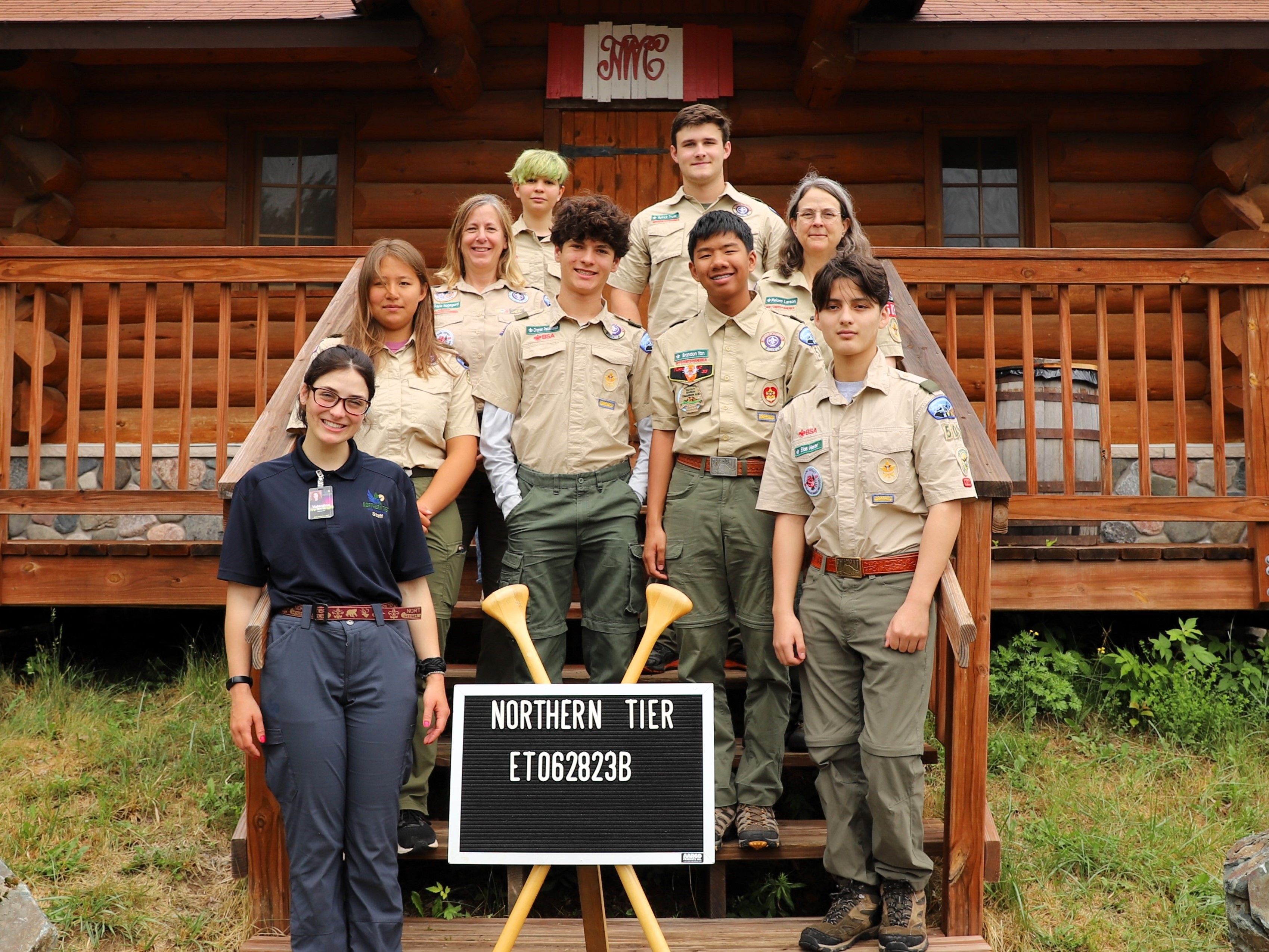
Coed Crew front l-r: interpreter Valentine Chenus, Elias Meyer second row l-r: Maddy Fraund, Charles Freidenreich, crew leader Brandon Yan third row l-r: lead advisor Ms. Gayle Hagegard, Ms. Melora Larson (Nash) back l-r: Bug B., Patrick Thuss Jun. 27-Jul. 8, 2023 We flew from Burbank to Minneapolis via Denver on Southwest Airlines, leaving at 8:30 am and arriving at Minneapolis a half-hour late at 5:45 pm. Two charter vans with a trailer picked us up at the Minneapolis airport and drove us 200 miles to Camp Chicagami near Eveleth, Minn., with a stop for dinner at __ in __, Minn. At Camp Chicagami we stayed in __. The next morning after breakfast with the campers, local youth grades 3-6, the vans drove us to Soudan underground iron ore mine near __, Minn., where we took an above-ground tour because the elevator is under a years-long renovation. We then drove to Ely, Minn., where we bought lunch at __ and ate in a nearby park. After lunch the vans drove us another half-hour to Northern Tier, arriving at 1 pm. We spent 10 nights at Northern Tier, the first and last at base camp at Moose Lake, and the other 8 nights camping at a different lake every night. We were two crews, each consisting of 6 scouts, 2 adults and an interpreter (guide) in three canoes. We remained the entire time in the Boundary Waters Canoe Area Wilderness. We had lightweight Kevlar canoes, but even at 45 lbs they were plenty heavy and awkward to carry, especially when going uphill and downhill over logs and boulders. Those who fished caught walleye, pike and smallmouth bass. Besides fishing, we also went swimming a couple of times, but while wearing our boots and life jackets, per rules. Northern Tier provided the tents, backpacks, cooking equipment and food. The boy crew headed west from base camp in a clockwise loop that reached as far as __. The return was on lakes along the U.S.-Canadian border. We traveled a total of 127 miles through __ lakes, with our longest day __ miles. Our route was especially challenging along the Beartrap River, which was narrow and shallow and often devolved into shallow marshes, with crossings of several beaver dams and slogs through waist-deep mud that threatened to suck off our boots. Our longest portage was a little over a mile - brutal. The coed crew headed east from base camp in a __ loop that reached as far as __. We traveled a total of 85 miles through __ lakes, with our longest day __ miles. The morning of the last day the charter vans picked us up at Northern Tier and drove us 4.5 hours back to the Minneapolis airport. Our flight was delayed two hours so we didn't leave until 6:20 pm, then after a change of planes in Denver, we arrived at Burbank an hour late at 10:45 pm. The cost was $1,897 ($1,150 to Northern Tier, $485 for plane, $192 for van, $16 for camp and breakfast, and $54 for crew shirt, maps, patches and other expenses. The trip was organized by Mr. Haxton. |
Sea Base 2023 |
|---|
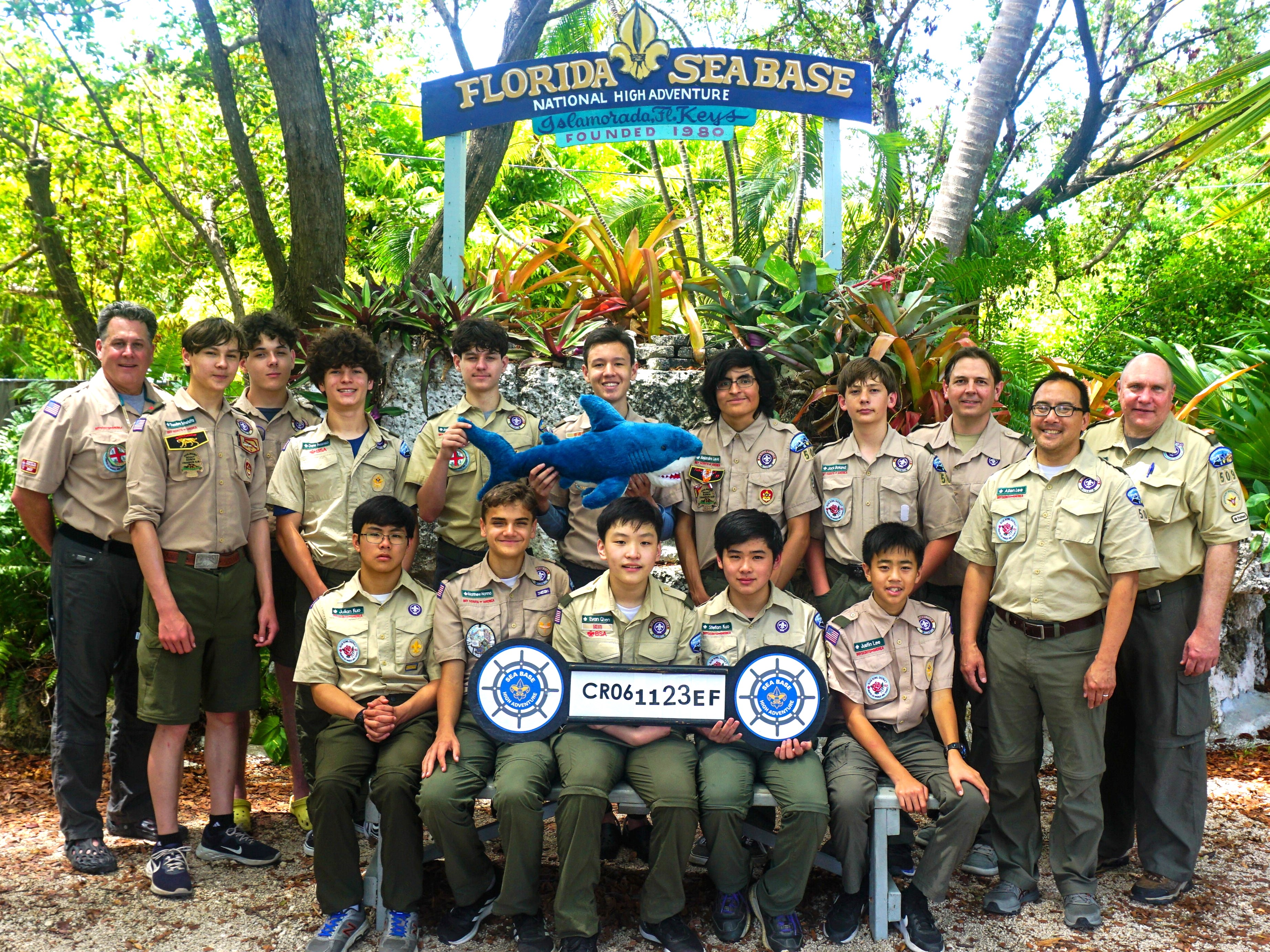
front l-r: Julian K., Matthew H., Evan C., Stefan K., crew leader Justin L. back l-r: Mr. Scott Mencken, crew leader Teddy Scharlotta, Nate Mencken, Charles Freidenreich, Josh Mencken, Bradley Bell, Alejandro Leyva, Jack B., Dr. Justin Boland, lead advisor Mr. Allen Lee, lead advisor Mr. Andrew Shapiro-Scharlotta Jun. 10-16, 2023 We were 12 scouts and 4 adults in two crews, both doing Coral Reef Sailing on 40' sailboats. We took a red-eye from LAX to Miami on American Airlines, leaving at midnight and arriving at 8 am. We took the MIA Mover to the nearby car rental center and picked up two 8-passenger minivans. We drove to Everglades Alligator Farm in Homestead where we explored the Everglades on an airboat, saw an alligator show and held baby alligators. We drove to Tavernier for a pizza lunch, then on to Sea Base in Islamorada, about halfway down the Florida Keys, arriving at 2 pm. Following snorkel check, loading the boats and eating dinner, we departed on our boats. The younger crew (Jack, Evan, Matthew, Julian, Stefan, Justin, Dr. Boland and Mr. Lee) sailed on the Island Rose with captain Steve Bitner, adventure CR061123-E. The older crew (Bradley, Charles, Alejandro, Josh, Nate, Teddy, Mr. Mencken and Mr. Shapiro-Scharlotta) sailed on the Music with captain Feather Lee, adventure CR061123-F. The two captains are married to each other. Captain Feather also captained the troop's crew last summer, but on a different boat. We sailed five nights mostly in the Florida Keys National Marine Sanctuary, with a mid-week shore visit to Banana Bay Resort in Marathon. Among the places we snorkeled were Shands Key, Rachel Key, Coffins Patch, Sombrero Reef and Vaca Key. We saw many different sea creatures, including barracuda and spiny lobsters. Sometimes the two crews met up to snorkel and cook together, and also shared anchor watch duties. Temperatures were in the mid-80s both day and night, but the high humidity made it feel like mid-90s. One night while we were sleeping on the decks there was a sudden rain that soaked us all. We did some fishing, successfully. The younger crew's bait cooler once fell off the deck and they had to turn around to retrieve it. On our shore visit we showered, visited a grocery store and barbecued steak for dinner. Each boat traveled about 95 miles, mostly under sail. On our last day on the water we returned to Sea Base in the morning, cleaned the boats, showered and changed into our class A uniforms. The younger crew ate lunch at Sea Base, while the older crew drove to a fast-food restaurant and then to nearby Robbie's where they fed the tarpons. It was a two-and-a-half-hour drive to Miami International. Our 5:40 pm nonstop to LAX arrived at 8:15 pm. The cost was $1,906 ($1,150 to Sea Base, $433 for plane, $103 for rental vans and tolls, $59 for mask & snorkel, and $161 for the crew shirt, duffel bag, sheet sleeping bag, travel comfort kit, alligator park admission, pizza lunch, tarpon feeding, sunscreen, insect repellent, crew photos, patches and tips & troop t-shirts for captains). The trip was organized by Mr. Haxton. |
Sea Base 2022 |
|---|
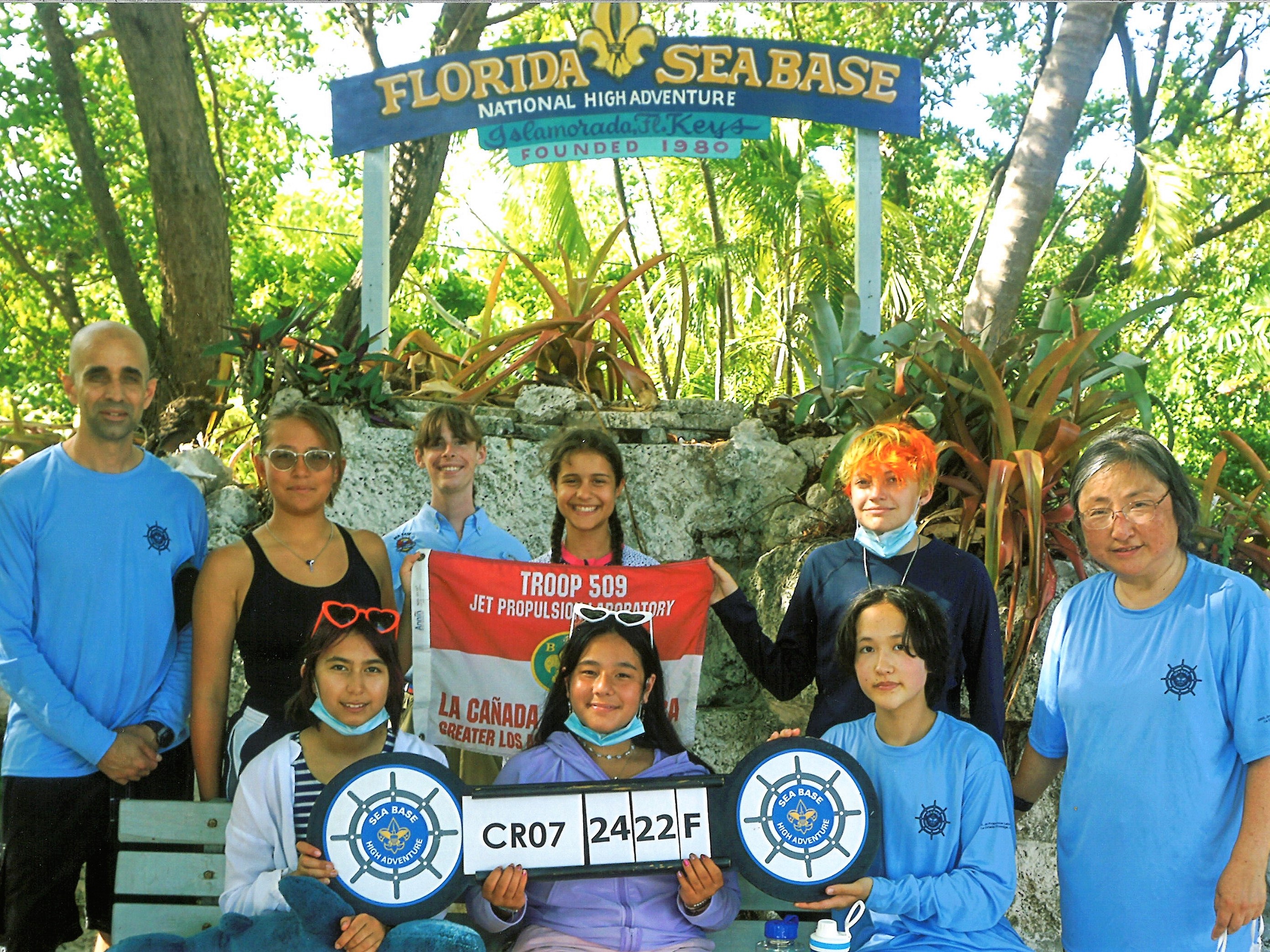
front l-r: Zee B., Jax M., co-crew leader Ann Turner, Ms. Grace Joung (Turner) back l-r: lead advisor Dr. John McArthur, Maddy Fraund, assistant Tex, co-crew leader Sienna D., Riot Renwick Jul. 23-30, 2022 We took a red-eye from LAX to Miami on American Airlines, leaving at 9:40 pm and arriving at 6 am. We picked up two rental cars, then drove a short distance to eat breakfast at First Watch, which we chose for its vegan options. We then drove to Everglades Alligator Farm where we explored the Everglades on an airboat, watched two reptile shows, and held a baby alligator. Lunch was in Homestead at the Robert Is Here fruit stand, where we consumed fruit, nuts, smoothies and milk shakes, and also did some petting at its animal farm. We had only 50 more miles to go to Sea Base in Islamorada, about halfway down the Florida Keys, but it took us three hours due to heavy traffic, so we didn't arrive at Sea Base until 3 pm. We had to rush through orientation, swim tests, paperwork check and dinner, but still succeeded in departing while it was still light. Our 41' Morgan sailboat was named the Bahama Rogue (misspelled on the hull as Bahama Rouge), captained by Feather Lee, adventure CR072422-F. We sailed five nights in the Florida Keys National Marine Sanctuary, with a mid-week shore visit to Bahia Honda State Park. We did lots of amazing snorkeling, and saw many varieties of fish, coral and other sea creatures like sea horses and sea slugs. We were there during the annual two-day lobster sport season, and had fun catching lobsters, although they all escaped our nets before we could get them out of the water - just as well since we weren't planning to eat them. Some of us slept on the deck, but most slept below-deck, except during bad weather when we all squeezed below-deck. We had several brief daytime thunderstorms, during which we stayed below-deck. At night we took turns on anchor watch, in which two at a time stayed awake for two-hour periods from 10 pm to 6 am watching to make sure the boat didn't float away from its anchor, and other boats didn't collide with us. To make up for the lost sleep, we took naps during the day. The food we ate on the boat was selected and cooked by us, taking turns doing the cooking and clean-up. At Bahia Honda we flew a kite, went for a run, swam, took showers, and barbecued our dinner by the beach. That evening we watched a movie on the boat. On our last day on the water, we returned to Sea Base in the afternoon and spent the rest of the day unpacking, doing laundry, repacking, playing games and chatting. After showers, we put on the Hawaiian shirts we brought and had a farewell luau on the beach. We slept that night in an air conditioned tent assigned just to us, which was really comfortable after all the heat and humidity of the past week. The next morning, after a hot breakfast in the cafeteria, we left in our rental cars around 10 am. We first visited the History of Diving Museum in Islamorada, then we went to the post office intending to mail a coconut, but without success since we hadn't brought a coconut with us and the post office doesn't sell them. We had fun at Robbie's in Islamorada feeding the tarpons. After a late lunch at Mom and Daughter Juice Bar in Tavernier, where we had empenadas, sandwiches, smoothies and key lime pie, we left at 3 pm for Miami International, turned in our rental cars, and took a 7:45 pm American Airlines nonstop flight to LAX, arriving at 9:45 pm. A six-minute video about the trip can be seen HERE. The cost was $1,710 ($1,025 to Sea Base, $462 for plane, $118 for rental cars, and $105 for the crew shirt, alligator park and diving museum admissions, breakfast, lunch, sunscreen, crew photos, patches and tip for captain). Scouts provided their own mask & snorkel, and Sea Base provided fins. The trip was organized by Dr. McArthur. |
Northern Tier 2022 |
|---|
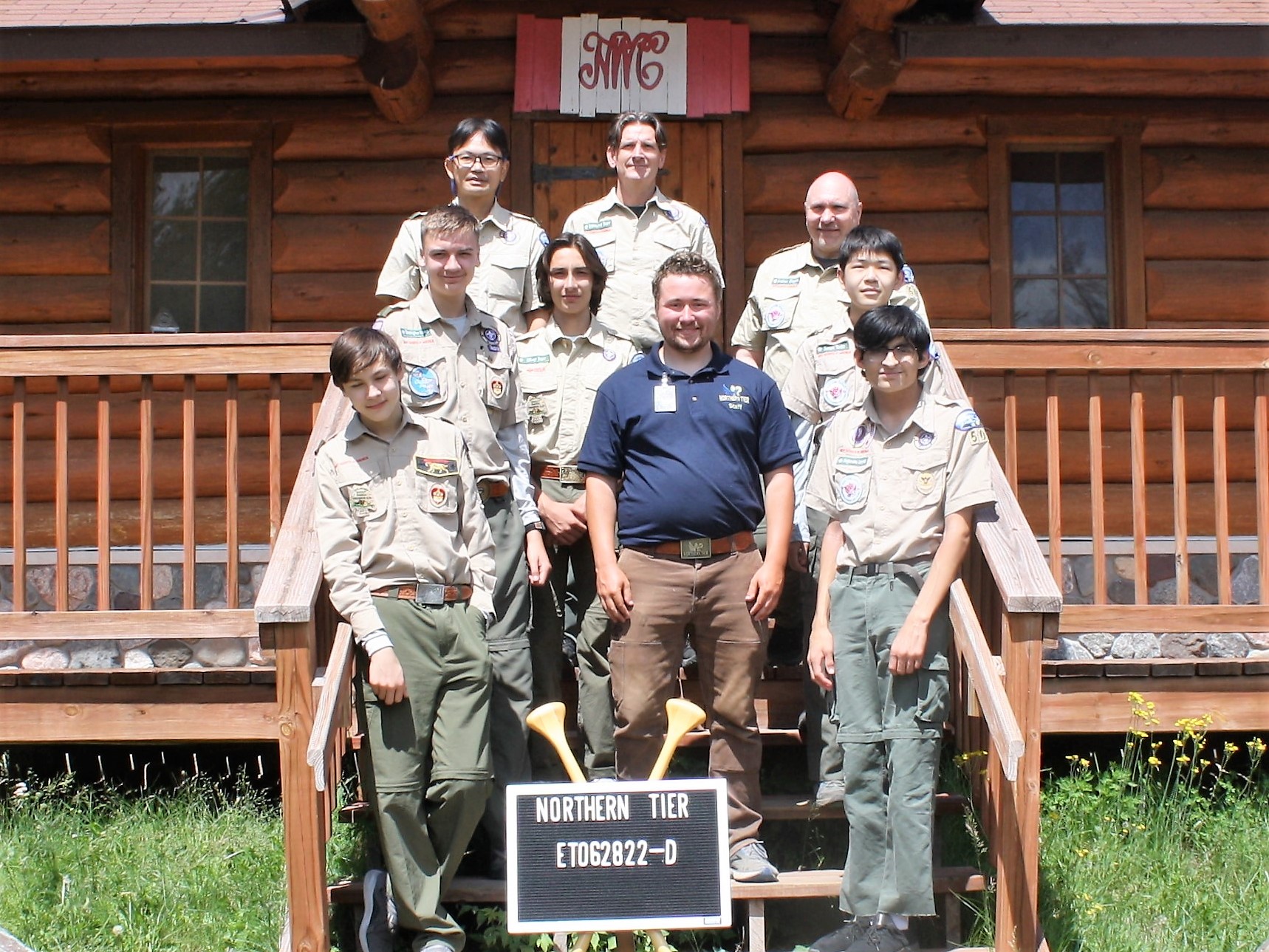
Younger Crew front l-r: Teddy Scharlotta, Christopher Hanna, Oliver Barr, interpreter Alec Sanchagrin, Sean Toda, crew leader Alejandro Leyva back l-r: Mr. Risaku Toda, Mr. Edmund Barr, Mr. Andrew Shapiro-Scharlotta 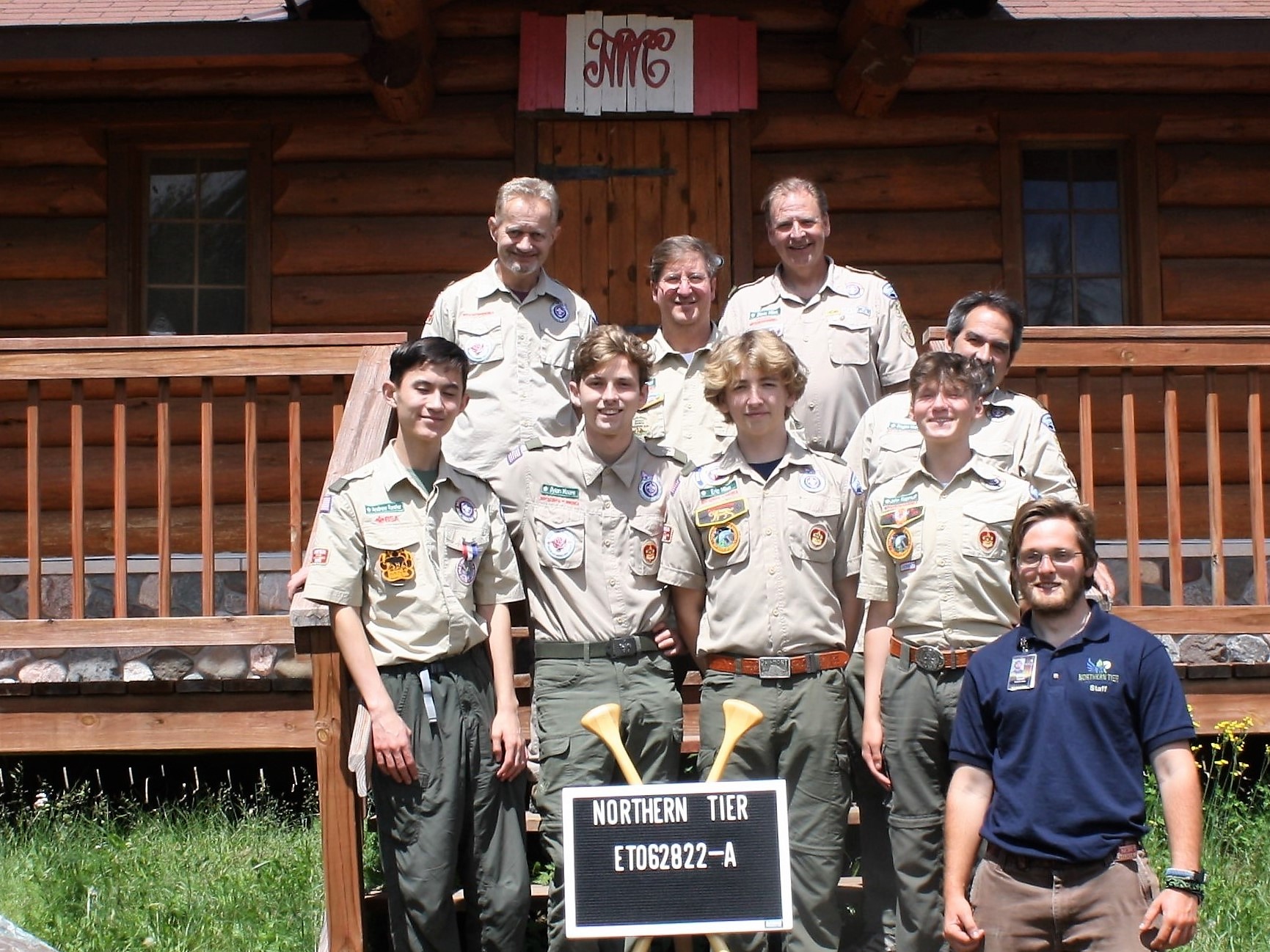
Older Crew front l-r: Andrew Forster, Dylan Moore, crew leader Eric Miles, John Klapmust, interpreter Chris Carnell back l-r: Mr. David Forster, Mr. John Klapmust, Mr. Steve Miles, Mr. Doug Moore Jun. 27-Jul. 8, 2022 We flew from Burbank to Minneapolis via Phoenix on American Airlines, leaving at 10 am and arriving in Minneapolis at 5:30 pm. We met our contact and took the local metro to the nearby Scout House at Ft. Snelling where we spent the night. The camp offered us a fun evening of archery, ropes course and rock wall climbing. The next morning a charter van picked us up and drove us 275 miles, 4.5 hours, to Northern Tier, near Ely, Minn. Before being allowed to enter, we all passed a medical screening for virus symptoms and exposure, including temperature checks. We spent 10 nights at Northern Tier, the first and last at base camp at Moose Lake, and the other 8 nights camping at a different lake every night. We were two crews, each consisting of 8 scouters and an interpreter (guide) in three canoes. The canoes were lightweight Kevlar, but even at 45 lbs they were plenty heavy and awkward to carry, especially when going uphill and downhill over logs and boulders. Both crews remained in the Boundary Waters Canoe Area Wilderness on the U.S. side of the border. Northern Tier provided the tents, backpacks, cooking equipment and food. We were not required to wear masks. The younger crew (grade 9) traveled east from base camp in a clockwise loop that reached as far as Saganaga Lake. We traveled a total of 102.5 miles through 50 lakes. Our longest day was 17.5 miles, and our longest portage was 0.75 miles. During some portages along the border, we stepped onto Canadian soil. It was windy on the second afternoon so we used our dining tarp as a makeshift sail and the wind carried us six miles. Others saw us sailing at high speed and applauded. In Saganaga Lake, wind picked up again and a big waive of water partially swamped one canoe. We avoided sinking by using Nalgene bottles to scoop water out of the canoe. On the fifth day we took a 12.5 mile detour through nine likes to travel between Gabimichigami Lake and Little Saganaga Lake. On the Fourth of July, we raised the American flag and the troop flag on a canoe, and at our campsite.We saw bald eagles, petroglyphs, beaver dams and a waterfall. The older crew (grades 11 & 12) traveled west from base camp in a clockwise loop that reached as far as the northern side of Irving Island in Lac La Croix, and returned on lakes along the U.S.-Canadian border. We traveled over 100 miles through 33 lakes and named bays, with our longest day 22 miles. Our route was especially challenging along the Beartrap River, which was narrow and shallow and often devolved into shallow marshes, with crossings of dozens of beaver dams and slogs through waist-deep mud that threatened to suck off our boots. Our longest portage was a little over a mile - brutal. Some of the portages were on Canadian soil or right on the border, including the legendary Prairie Portage, for thousands of years the area's most-crossed portage. We caught a total of 18 fish - 3 walleye, 4 pike, 10 smallmouth bass and 1 rock bass. Besides fishing, we found a submerged locomotive, swam to Canada, viewed 4 huge waterfalls, spent 6 hours windbound, climbed Warrior Hill, perused the legendary pictographs of Lac La Croix and Crooked Lake, and camped for the 4th of July at historic Table Rock where the Voyageurs celebrated Thanksgiving. The morning of the last day, a charter bus picked up us and two other crews and returned us to the Minneapolis airport. Delays in our flight caused 14 of us to switch to another American Airlines flight, changing planes in Dallas and landing in Burbank at 9 pm. There wasn't room on the plane for the other two in the crew, who took a United Airlines flight to LAX, arriving at 10:30 pm. But their bags didn't arrive with them, and it was nearly a week before they were reunited with their bags. The cost was $2,263 ($1,050 to Northern Tier, $712 for plane, $439 for van, scout camp and three meals, and $63 for crew shirt, maps, patches and other expenses.) The trip was organized by Mr. Klapmust. |
Philmont 2022 |
|---|

Younger Crew l-r: crew leader Maximus Kanounji, Nathaniel Llana, Matthew Choi, Mr. Patrick Choi, Noah Gullo-Ingram, Charles Freidenreich, ranger Gavin McCabe, Mr. Scott Mencken, Brandon Yan, Josh Mencken, Jason Kim, Joshua Yang 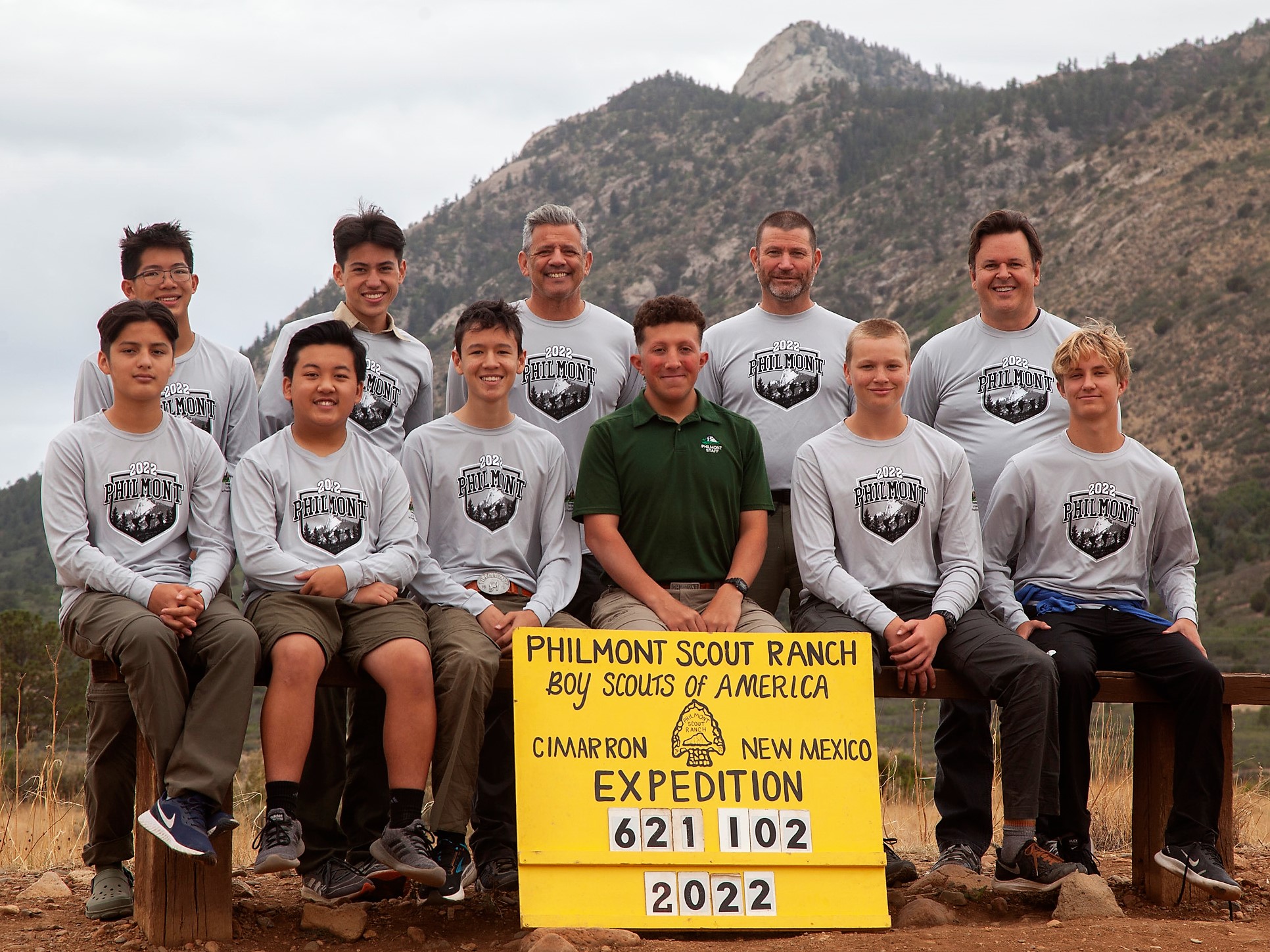
Older Crew front l-r: Elias Meyer, Bradley Choi, Bradley Bell, ranger Larry Abbiati, crew leader Walker Andrews, Cole Pooley back l-r: Brandon Yan, Ronan Furlong, Mr. Kevin Furlong, lead advisor Mr. Tom Andrews, Mr. Mike Bell Jun. 19-Jul. 5, 2022 We left Union Station on the train at 6 pm and arrived at Raton, NM, the next day at 9:30 pm, five hours late. The seats were wide with lots of legroom and pull-out foot rests for sleeping. The scouts spent much of the time in the observation car playing cards and group games on their phones. At Raton, a Philmont bus picked us up and drove us 45 miles to Philmont's base camp at elevation 6,600'. We had all been vaccinated for Covid-19, so we satisfied Philmont's virus protocols. Face masks were required only when indoors. We spent the night in platform tents, then the next morning each crew was assigned a ranger, and spent the day picking up tents, equipment and food and making other preparations. We ate meals in the dining hall. After a second night in platform tents, we started hiking the next day. The younger crew (grades 8 & 9) was on itinerary 14, which totaled 58 miles over 11 days with 10,528' of elevation gain in a counterclockwise loop in Philmont's north country. A Philmont bus took us to Six Mile trailhead. Our ranger stayed with us the first two days on the trail. Our campsites were House Canyon (dry), Indian Writings, Horse Canyon (dry), Ponil, Pueblano, Ute Meadows (2 nights), Head of Dean, Santa Claus and Cimarroncita. We picked up food at Ponil, Baldy Town and Cimarroncita. We summited the tallest peak at Philmont, Baldy Mtn. (12,441'). Our activities included horseback riding, archery with 3-D targets, challenge activities, loading shotgun shells, shotgun shooting, laser shooting, viewing petroglyphs, blacksmithing, railroad handcar, tomahawk throwing, roping, branding, chuckwagon dinner, cantina show with root beer, and campfire shows. We hiked two days with a burro we named Edwardo. Our conservation project was forest thinning near Baldy Skyline. We had a sister crew from Houston, Texas, on the same itinerary. We had a lot of rain during our first week, less the second week. On our last day, a Philmont bus picked us up at Ute Park trailhead and brought us back to base camp. The older crew (grades 10 & 9) was on itinerary 28, which totaled 75 miles over 11 days with 12,155' of elevation gain in a clockwise loop through Philmont's south country, including about 24 hours outside of Philmont's property. A Philmont bus took us to Zastrow trailhead. Our ranger stayed with us the first two days on the trail. Our campsites were Backache Springs, Crater Lake, Phillips Junction, Daves Lake, Garcia Cow, Crooked Creek, Mt. Phillips (dry), Sawmill, Cyphers Mine and Clarks Fork. We picked up food at Phillips Junction and Sawmill. We summited Mt. Phillips (11,740'), Comanche Peak, Shaefers Peak and Tooth of Time. Our activities included spar pole climbing, horseback riding, archery with 3-D targets, loading rifle cartridges, rifle shooting, challenge activities, lodge tour, cabin tour, mine tour, wildlife conservation, arrowheads, sweat lodge, tomahawk throwing, fur trade, gold panning, chuckwagon dinner and campfire shows. Our conservation project was trail reconstruction near Crater Lake. We didn't have a sister crew on the same itinerary. We had a lot of rain during our first week, less the second week. On our last day we hiked 12.8 miles into base camp from Clarks Fork, with lunch on top of Tooth of Time. Back at base camp, after taking much-needed showers, we ordered and ate pizza and toured Villa Philmonte and the National Scouting Museum, then attended the closing campfire. We learned our train back to L.A. had been canceled due to it having been in a crash and derailment in Missouri while we were on the trail, so we would instead be leaving a day later. The weekly newspaper back home wrote about this experience. During our extra day in base camp we went into Cimarron and ate burritos there, and some also visted the Kit Carson Museum at Philmont. The next day a Philmont bus took us to Raton for the 10:30 am train, but the train, coming from Chicago, was 1 hour and 40 minutes late. We arrived back to Union Station the next day at 10:20 am, 2 hours and 20 minutes late. We missed the Fourth of July celebrations, having been on the train in the desert between Gallup, N.M., and Winslow, Ariz., during the time when fireworks shows were being held elsewhere. The cost was $1,516 ($1,295 to Philmont, $117 for the train and bus, and $104 for the crew shirt, maps, fuel, patches, extra meals and miscellaneous). The trip was organized by Mr. Haxton. |
Sea Base 2021 |
|---|

Coral Reef Sailing front l-r: Elias Meyer, Noah Gullo-Ingram, Oliver Barr back l-r: Mr. Adam Bray-Ali, Walker Andrews, crew leader Ken Bray-Ali, Neil Byram, lead advisor Mr. Tom Andrews 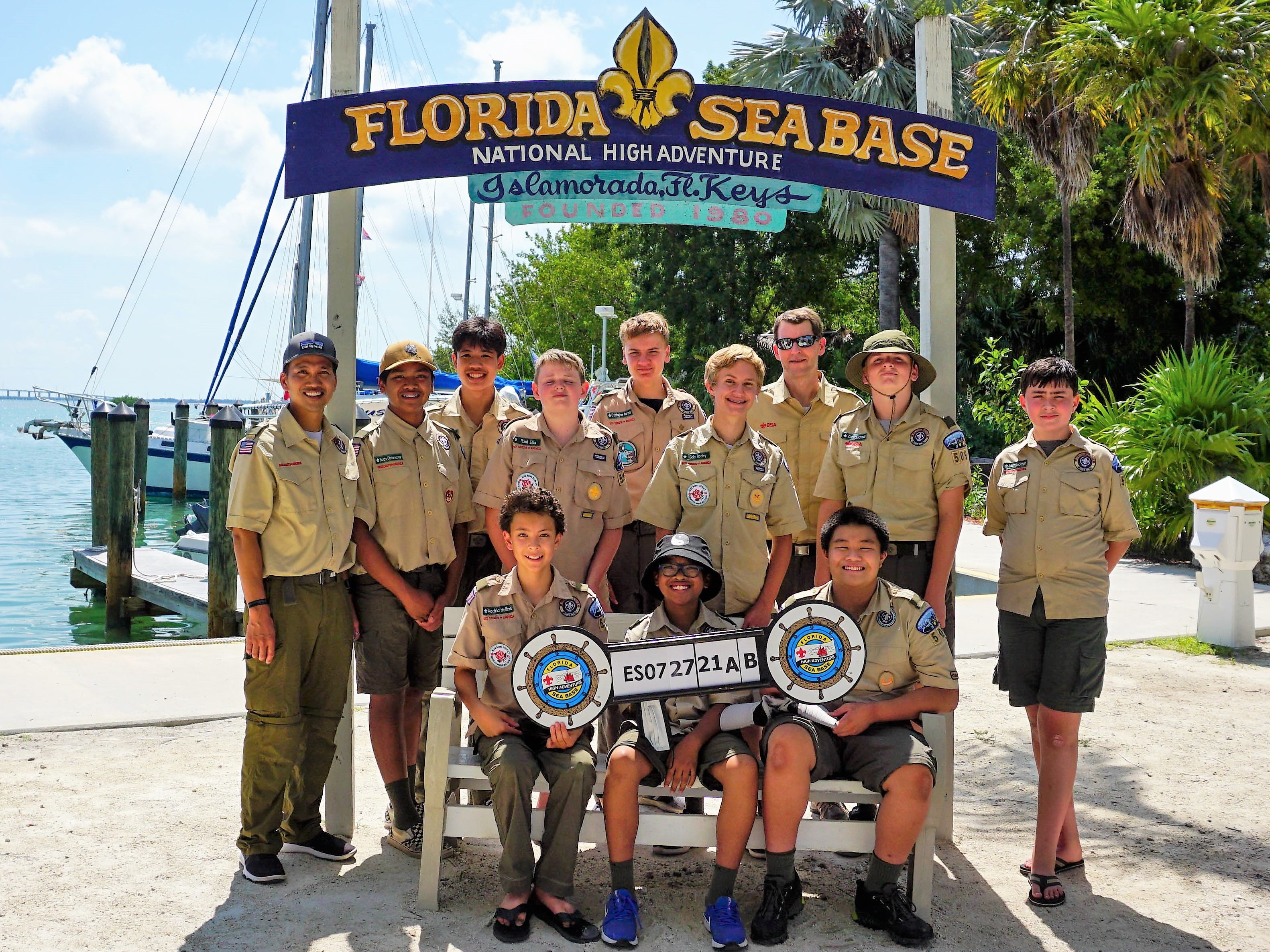
STEM Eco Sailing front l-r: Aedric H., Dylan O., Joshua Yang back l-r: lead advisor Mr. John Obsenares, crew leader Noah Obsenares, Bruce Wiles, Paul E., Christopher Hanna, Cole Pooley, Mr. Rob Pooley, Connor J., Liam G. Jul. 26-Aug. 2, 2021 We were 16 scouts and 4 adults in two crews. One crew of 8 did Coral Reef Sailing on a 40' sailboat, and the other crew of 12 did STEM Eco Sailing on two 40' sailboats. We took a red-eye from LAX to Miami on American Airlines, leaving at 11:30 pm and arriving at 7:45 am. A charter bus drove us to Everglades Alligator Farm, where we explored the Everglades on an airboat and got close to alligators. We then drove to Tavernier to pick up pizza, stopped at Robbie's to feed the tarpons, and at 2:30 pm arrived at Sea Base in Islamorada, about halfway down the Florida Keys, and ate our pizza lunch. Following orientation, swim tests, paperwork check and dinner, we loaded our boats and departed. The Coral Reef Sailing crew sailed on the Comfort Zone II with captain Ron Jordan, adventure CR072721-A. We sailed five nights in the Florida Keys National Marine Sanctuary, with a mid-week shore visit to Marathon. We did lots of snorkeling near various coral reefs, plus we fished and caught spiny lobsters during the two-day lobster sport season. We took turns cooking on the boat, and we slept on the deck. The STEM Eco Sailing crew sailed on the Wyvern with captain Connie Rosenthal, and on the Wolfman Pac with captain Nate Lehmkuhl, and was accompanied by first mate Adam Winchenbach, adventure ES072721-A. We sailed five nights, mostly in John Pennekamp State Park, with a mid-week shore visit to the park's visitor center. Each morning the two boats rafted together and Adam taught us about marine biology, and then we snorkeled with Adam much of the rest of the day to observe what he had talked about. We took turns cooking on the boats, and we slept on the decks. On the last day on the water, both crews returned to Sea Base around noon, then spent the afternoon paddle boarding and kayaking. That evening, after showers, we wore our Hawaiian shirts and had a farewell luau. It was nice to sleep in air conditioned dorms after the constant heat and humidity we had experienced (fortunately, no rain). The next morning, after a hot breakfast, a charter bus picked us up and drove us to Miami International, where we took a 1 pm flight to Burbank via Phoenix, arriving at 5 pm. The cost was $1,857 ($1,095 to Sea Base, $467 for plane, $87 for charter bus, $45 for mask & snorkel, and $163 for the crew shirt, duffel bag, sheet sleeping bag, travel comfort kit, alligator park admission, pizza lunch, tarpon feeding, sunscreen, crew photos, patches and tips for captains and first mate). The trip was organized by Mr. Haxton. |
Summit 2021 |
|---|
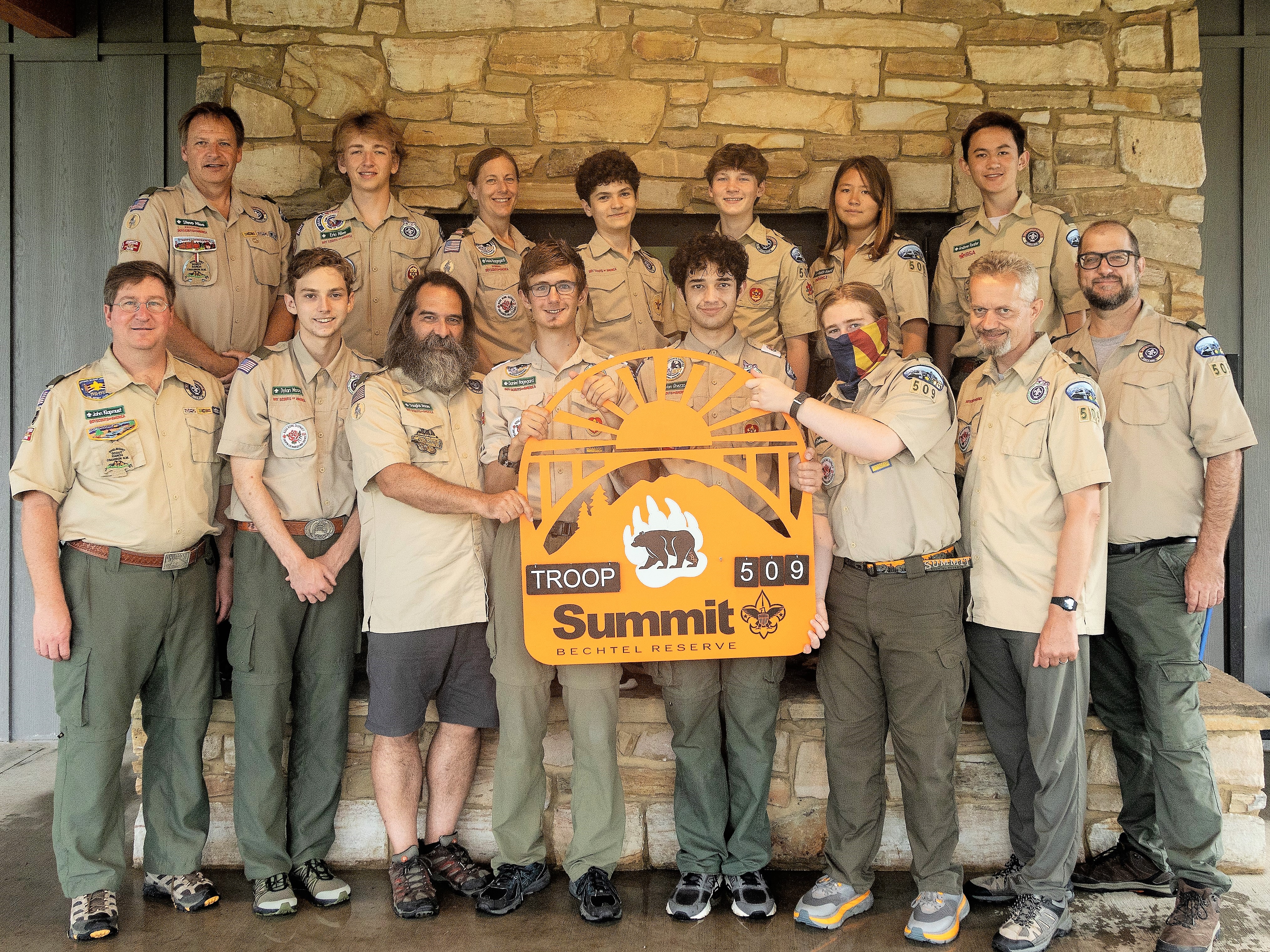
Expedition 717-E-RT front l-r: Mr. John Klapmust, crew leader Dylan Moore, Mr. Doug Moore, Daniel Hagegard, Dylan Ghezzo, Dashiell Anthony, Mr. David Forster, Mr. Paul Ghezzo back l-r: Mr. Steve Miles, Eric Miles, Ms. Gayle Hagegard, Charles Freidenreich, John Klapmust, Maddy Fraund, Andrew Forster Jul. 15-23, 2021 We took a red-eye from LAX to Charlotte, NC, arriving at 8 am, a day before our trek was to start. We picked up our luggage and rental vehicles (two minivans and a car) and made our way to the Waffle House for breakfast. We drove 210 miles to Lewisburg, WV, the site of a Civil War battle. We took a tour of the Greenbrier Historical Society's museum and then a walking tour of the town. We explored the nearby Lost World Caverns, and after a pizza dinner drove 70 miles to Summit and tumbled into our platform tents exhausted. The next morning after breakfast in the dining hall we walked a mile to view Summit’s Sustainability Treehouse. Then we walked across the CONSOL Energy bridge, a suspension bridge about 100' above the forest floor. While on the bridge there was a lightning warning, so we headed back to our campsite. After lunch we met our guides and did a shakedown. Our trip leader was Charles Saunders, and the other guides were Karla Vazquez, Preston Nold and Skyler McGregor. Karla was thrilled to have a coed crew, her first of the summer. Later in the afternoon we drove to the range where we were scheduled to do archery and axe throwing, but just as we arrived there was a torrential downpour. After a few minutes under a large tent we gave up and drove back to the dining hall to wait out the storm. Our vehicles made several trips to shuttle other crews back who had walked to the range. After breakfast the next day we met our river companions, Troop 39 from Chicago. We all climbed onto a bus for the two-hour ride to the start of our trek on the New River in New River National Park & Preserve. Each of us was assigned an inflatable “duckie” kayak, and our gear went onto a large gear raft. A truck brought food and additional gear to the campsites. For four days we kayaked about 5-6 hours a day, averaging about 10 miles per day. Some parts of the river had long stretches of quiet water where we could hop out and swim, while other areas had groups of rapids. At each rapid we formed a “duckie line” and followed the guides through as they approached from the angle designed to maximize the fun. A few people fell out at various rapids but everyone had fun. Some highlights were hiking through a tunnel and up a trail to a hidden waterfall, building a duckie tower and jumping from it, jumping from a large boulder along the shore, touring a ghost town at night, and having our departure from a lunch delayed while three copperhead snakes swam around our half-beached kayaks. The first night we slept in a field adjacent to a public campground, the second night was a sandy beach along the river, the third night was platform tents on a steep slope by the river, and the last night was in a field away from the river. On the final morning on the river we traded our duckies for traditional whitewater rafts, with the adults in one raft and the scouts in the other two. The rapids were much larger this final day and one of the scout rafts flipped in the final rapid. We finished just downstream of the iconic New River Gorge Bridge, once the longest single-span arch bridge in the world. We rode a bus back to Summit and got changed quickly before driving to the Big Zip, a 3,200’-long zipline that reaches speeds of 50+ mph. Then we headed back to our campsite at Summit for much-needed showers and relaxion. After dinner we drove over to the activities area where several activities were open, including a COPES rope course, laser gun shooting, a BMX bike course and a skateboard park. The next day, since our flight wasn't until 7 pm, we spent the morning relaxing in base camp. After an early lunch we drove 180 miles to Fort Dobbs State Historical Site in North Carolina and took a short tour of this re-created frontier fort where colonial soldiers protected settlers from Indian attacks. From there we drove 50 miles to the Charlotte airport and later landed at LAX at 10 pm. A three-minute video about the trip can be seen HERE. The cost was $1,655 ($970 to Summit, $360 for the plane, $245 for vehicles & gas, and $80 for crew shirts, tour activities, crew photos, patches and miscellaneous). The trip was organized by Ms. Hagegard. |
Philmont 2021 |
|---|
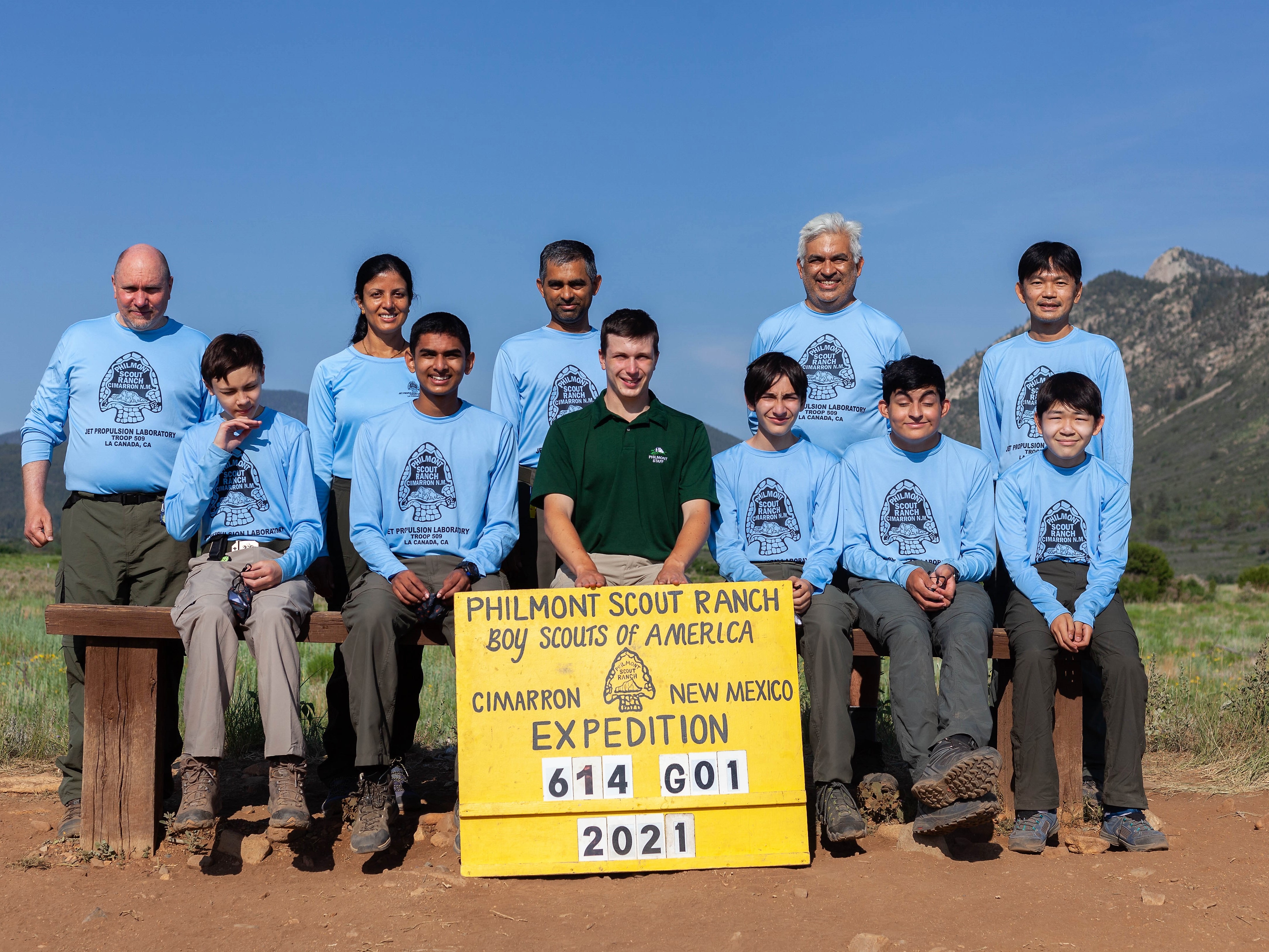
Younger Crew front l-r: Teddy Scharlotta, crew leader Sanjith Cherumandanda, ranger Zach Rauchbach, Oliver Barr, Alejandro Leyva, Sean Toda back l-r: lead advisor Mr. Andrew Shapiro-Scharlotta, Mrs. Sonia Cherumandanda, Mr. Subbaiah Cherumandanda, Mr. Victor Leyva, Mr. Risaku Toda 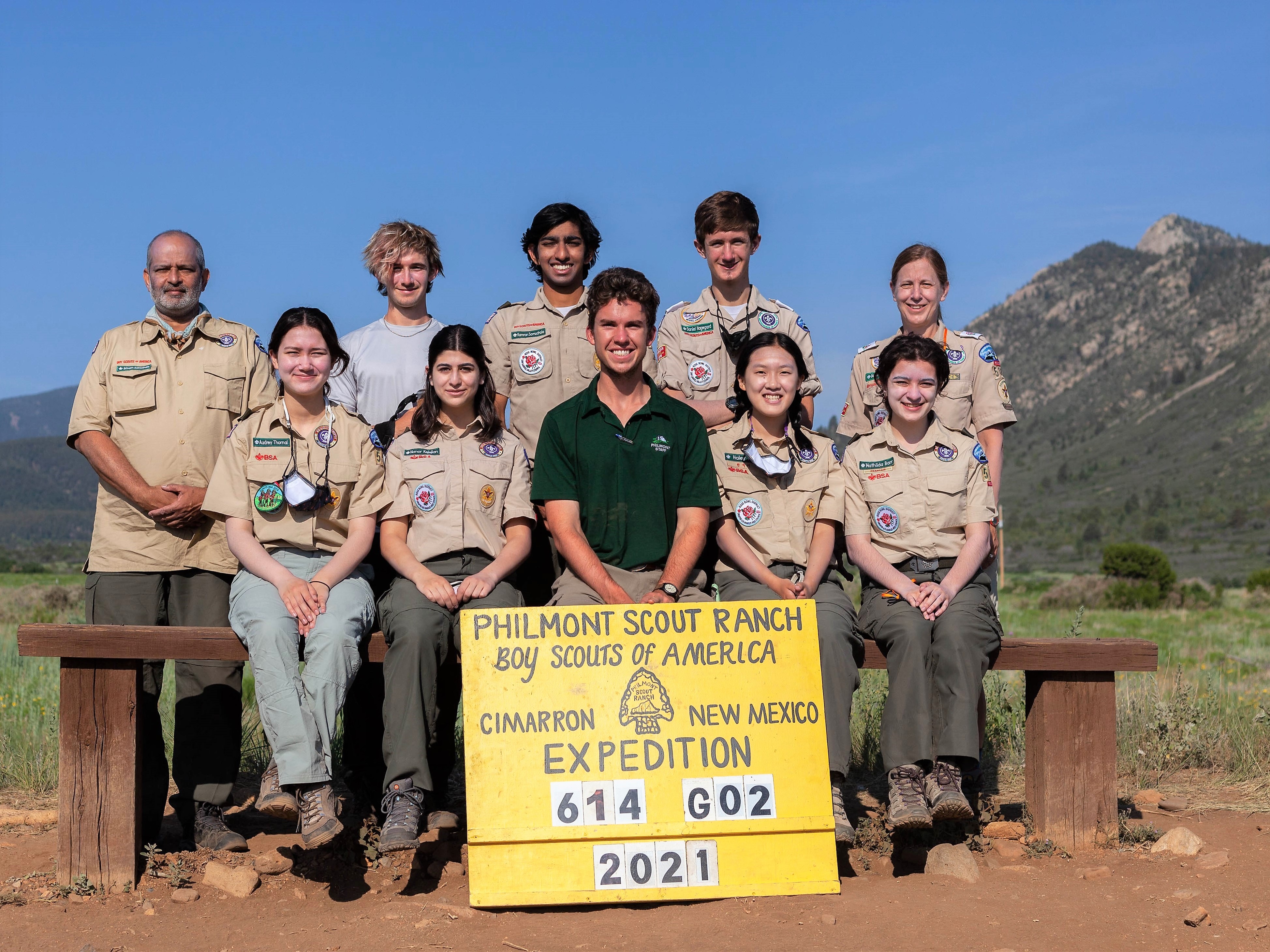
Older Crew front l-r: Audrey Thornal, Nanor Kejejian, ranger Brennan Ruth, Haley Kim, Mathilda Barr back l-r: Dr. Srinath Samudrala, Jeremy Holmes, Kamran Samudrala, crew leader Daniel Hagegard, lead advisor Ms. Gayle Hagegard Jun. 12-27, 2021 Wearing masks, we left Union Station at 6 pm and arrived 22 hours later in Raton, NM. The train seats were wide with lots of legroom and pull-out foot rests for sleeping. The scouts spent much of the time in the observation car playing cards, Yahtzee and group games on their phones. At Raton, a Philmont bus picked us up and drove us 45 miles to Philmont's base camp at elevation 6,600'. We had all been vaccinated for Covid-19, so we satisfied Philmont's virus protocols. In base camp everyone had to wear a face mask. We spent the night in platform tents, then the next morning each crew was assigned a ranger, and spent the day picking up tents, equipment and food and making other preparations. We ate meals at picnic tables next to our platform tents, consisting of prepackaged food picked up from the cafeteria in milk crates. After a second night in platform tents, we started hiking. We didn't wear face masks on the trail and in camps, unless we were around someone not in our crew. The younger crew (grades 8 & 9) was on itinerary 6, which totaled 64 miles over 11 days with 10,521' of elevation gain in a counterclockwise loop in Philmont's north country. A Philmont bus took us to our trailhead at Six Mile Gate. Our ranger stayed with us the first two days on the trail. Our campsites were McBride (dry), Metcalf Station, Dan Beard, Dean Skyline (dry), Santa Claus, Black Horse Creek, Maxwell, Baldy Skyline, Pueblano and Ponil. We picked up food at Ponil and Baldy Town. We summited the tallest peak at Philmont, Baldy Mtn. (12,441'). Our activities included spar pole climbing, horseback riding, challenge activities, revolver shooting, loading shotgun shells, shotgun shooting, viewing petroglyphs, blacksmithing, railroad handcar, tomahawk throwing, fur trading, rail ties, roping, branding, chuckwagon dinner, cantina show and campfire shows. We hiked three days with a burro we named Burrito. Our conservation project was forest thinning near Baldy Skyline. We had a sister crew from Austin, TX, on the same itinerary. The weather was pretty hot, with short periods of light rain a couple of days. At our campsite in Pueblano we had a brief daylight visit from a bear. On our last day, a Philmont bus picked us up at Ponil turnaround and brought us back to base camp. An 8-minute video about the crew's trek is HERE. The older crew (grades 10-12) was on itinerary 25, which totaled 70 miles over 11 days with 13,049' of elevation gain in a clockwise loop through Philmont's south country. The itinerary was unusual in that we didn't start by getting bussed to our trailhead, but instead hiked out of base camp. At the end of our trek we hiked back into base camp. Our ranger stayed with us the first two days on the trail. Our campsites were Magpie (dry), Carson Meadows, Fish Camp, Apache Springs, Wild Horse, Comanche Peak (dry, 11,100'), Sawmill, Cyphers Mine, Clarks Fork and Tooth Ridge (dry). We picked up food at Apache Springs, Sawmill and Cimarroncito. We summited Mt. Phillips (11,740'), Comanche Peak, Shaefers Peak and Tooth of Time. Our activities included archery with 3-D targets, loading rifle cartridges, rifle shooting, challenge activities, lodge tour, cabin tour, mine tour, wildlife conservation, arrowheads, sweat lodge, tomahawk throwing, fur trade, gold panning, chuckwagon dinner and campfire shows. Our conservation project was forest thinning near Apache Springs. We didn't have a sister crew on the same itinerary. We had very little rain, except one evening when we were eating dinner a thunderstorm hit and we had to take lightning position. Another day, we had fog so thick our visibility was only 100 feet. A four-minute video about the trip can be seen HERE. Back at base camp we again wore masks, and after taking much-needed showers, we ordered and ate pizza and toured Villa Philmonte and the National Scouting Museum, then after dinner attended the closing campfire. That night the wind was so fierce in base camp that some of the platform tents were blown off their platforms. The next morning a Philmont bus took us to Raton for a 10:30 am train. However, the train, coming from Chicago, was six hours late so we used the time to explore Raton, including the city's museum. We wore masks on the train, and arrived back to Union Station the next day at 2 pm, six hours late. The cost was $1,456 ($1,115 to Philmont, $260 for the train and bus, and $81 for the crew shirt, maps, fuel, patches and miscellaneous). The trip was organized by Mr. Haxton. |
Northern Tier 2020 |
|---|
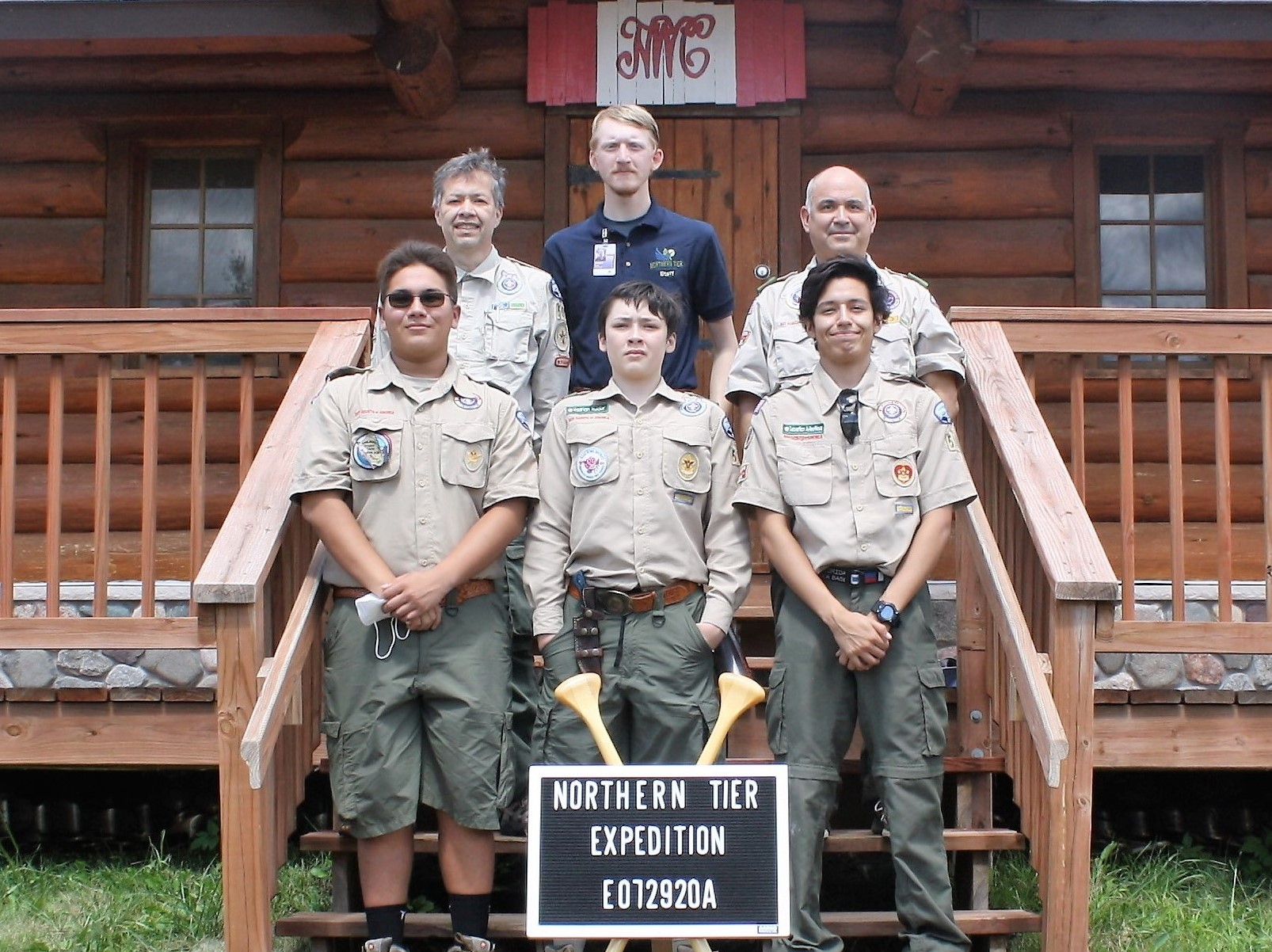
Crew E072920-A front l-r: crew leader Ken Bray-Ali, Hadrian Huidor, Sebastian Aviles-Maya back l-r: lead advisor Mr. Sergio Huidor, interpreter Adam Lux, Mr. Gil Aviles 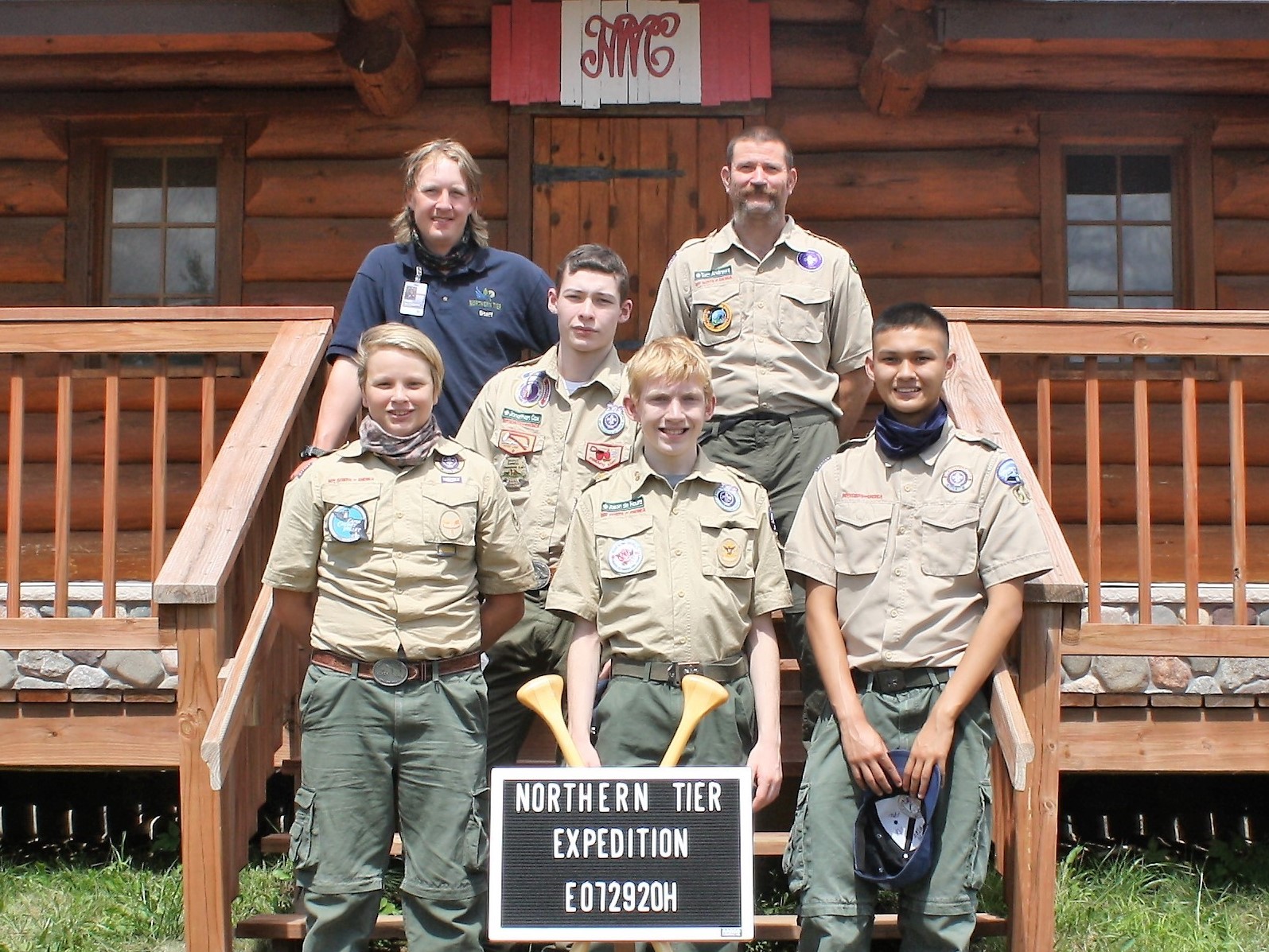
Crew E072920-H front l-r: Walker Andrews, crew leader Jason de Moura, Matthew Fan back l-r: interpreter Heath Haggerty, Jonathan Cox, lead advisor Mr. Tom Andrews Jul. 28-Aug. 8, 2020 We flew from Burbank to Minneapolis via Denver on Southwest Airlines, leaving at 10 am wearing face masks, face shields and gloves. The Burbank airport was eerily empty and our flight was only a third full, allowing us to sit together in the back with a comfortable distance from other passengers. We were careful to wipe down our seats before settling in and to keep our masks and shields on during the flight. Everyone we met was fully masked, which made us feel fairly safe during both flights. We removed our PPE only for lunch at the Denver airport, then replaced it with new PPE. Two charter vans with a trailer picked us up at the Minneapolis airport and drove us 210 miles to Biwabik, Minn., with a stop for dinner at Village Inn restaurant in Wyoming, Minn., where we ate at tables in the parking lot. In Biwabik, we stayed in a hostel occupied exclusively by us. We played air hockey, pool and other games before getting in our sleeping bags on bunk beds. The next morning the vans drove us to the Rouchleau open pit iron ore mine near Virginia, Minn., where we walked over the mine on a bridge, at 205 ft the highest bridge in the state. We then drove to Ely, Minn., where we bought lunch at Dairy Queen and ate in a nearby park. Since the dining room was closed, we walked up the drive-through lane and placed our orders at the window. Almost all of us had Dairy Queen's legendary milkshake that is so thick it won't spill when held upside down (true!). After lunch we made a visit to a local sporting goods store to pick up some live bait and assorted camping gadgets. The vans then drove us another half-hour to Northern Tier, arriving at 1 pm. In the parking lot before being allowed to enter, we all passed a medical screening for virus symptoms and exposure, including temperature checks. We spent 10 nights at Northern Tier, the first and last at base camp at Moose Lake, and the other 8 nights camping at a different lake every night. In base camp we wore masks, but once we were on the water we were a family unit and maskless. We were two crews, each consisting of 5 scouters and an interpreter (guide) in two canoes. The two crews chose to take the same route in the Boundary Waters Canoe Area Wilderness, but spaced about an hour or two apart, so we occasionally saw each other in the distance. Our route headed west from base camp in a clockwise loop that reached as far as Iron Lake, where we had a layover day. The return was on lakes along the U.S.-Canadian border. We traveled a total of 107 miles through 35 lakes, with our longest day 19 miles. Our route was especially challenging along the Beartrap River, which was narrow and shallow and often devolved into shallow marshes, with crossings of several beaver dams and slogs through waist-deep mud that threatened to suck off our boots. Our longest portage was a little over a mile - brutal. We had lightweight Kevlar canoes, but even at 45 lbs they were plenty heavy and awkward to carry, especially when going uphill and downhill over logs and boulders. Some of the portages were on Canadian soil or right on the border, including the legendary Prairie Portage, for thousands of years the area's most-crossed portage. Those who fished caught walleye, pike and smallmouth bass. Besides fishing, we also went swimming a couple of times, but while wearing our boots and life jackets, per rules. One of the crews, on the last night on the water, woke up at 3 am and paddled under the stars to arrive at Scout Island across from Northern Tier base camp at 5:30 am. They spent the next few hours napping, listening to their interpreter read "Call it Courage," and gloating about beating the other crew back to base camp. One scout suffered burns to a foot when a cooking pot was accidentally knocked over. Another scout discovered a leech sucking blood from his leg. The morning of the last day the charter vans picked us up at Northern Tier and returned us to the Minneapolis airport. We again traveled wearing masks, shields and gloves, and after a change of planes in Denver, arrived at Burbank at 9:15 pm. Northern Tier provided the tents, backpacks, cooking equipment and food. The cost was $1,339 ($950 to Northern Tier, $146 for plane, $115 for van, $34 for hostel and breakfast, $50 for crew shirt, maps, patches and other expenses, and $44 for personal protective equipment.) The trip was organized by Mr. Haxton. |
Philmont 2019 |
|---|
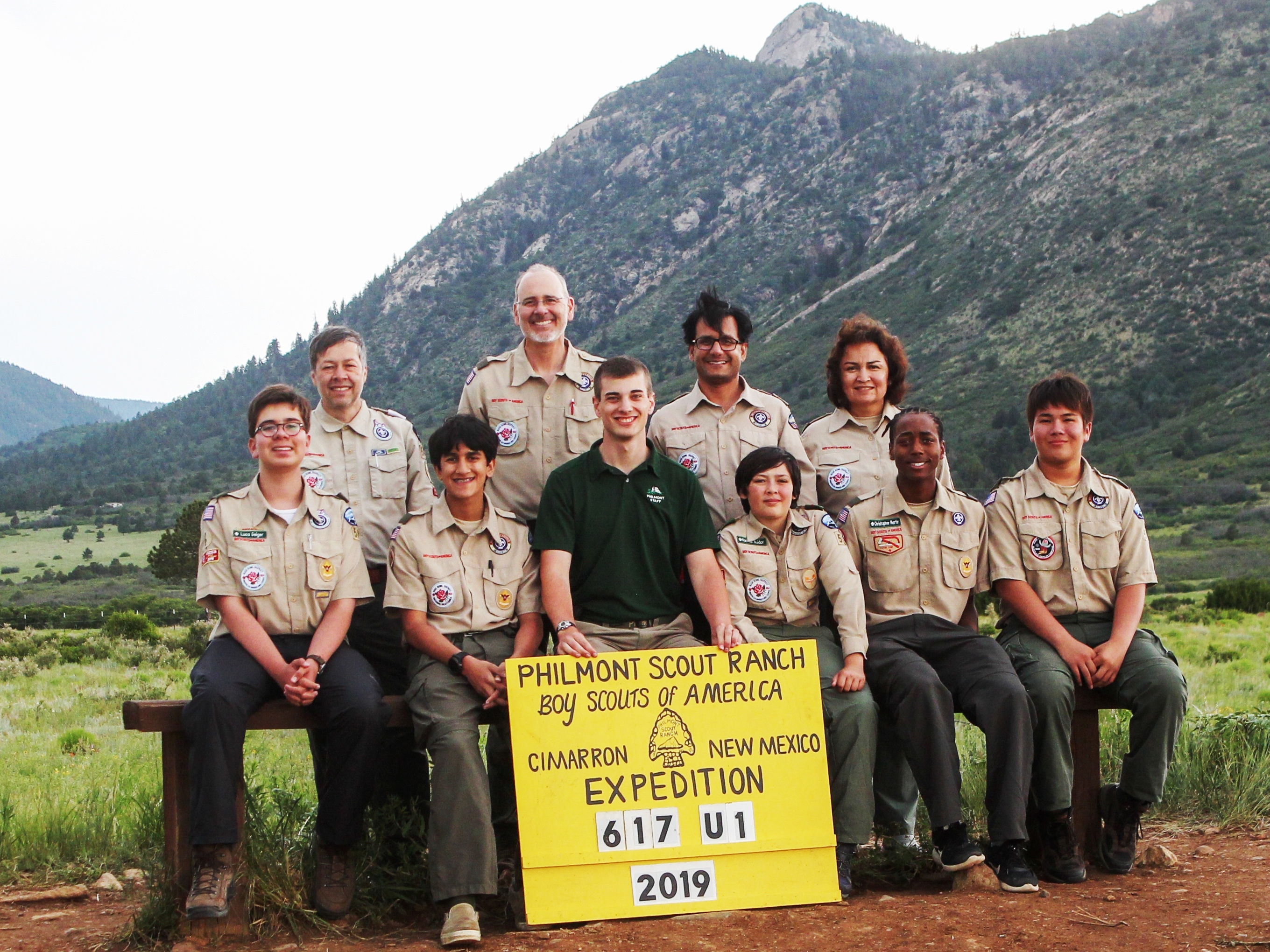
June Crew, Itinerary 5 front l-r: Luca Geiger, Michael Shaikh, ranger Bryan Ritchey, Hadrian Huidor, crew leader Christopher Martin, Ken Bray-Ali back l-r: Mr. Sergio Huidor, lead advisor Mr. John Geiger, Mr. Paul Shaikh, Mrs. Shazi Shaikh 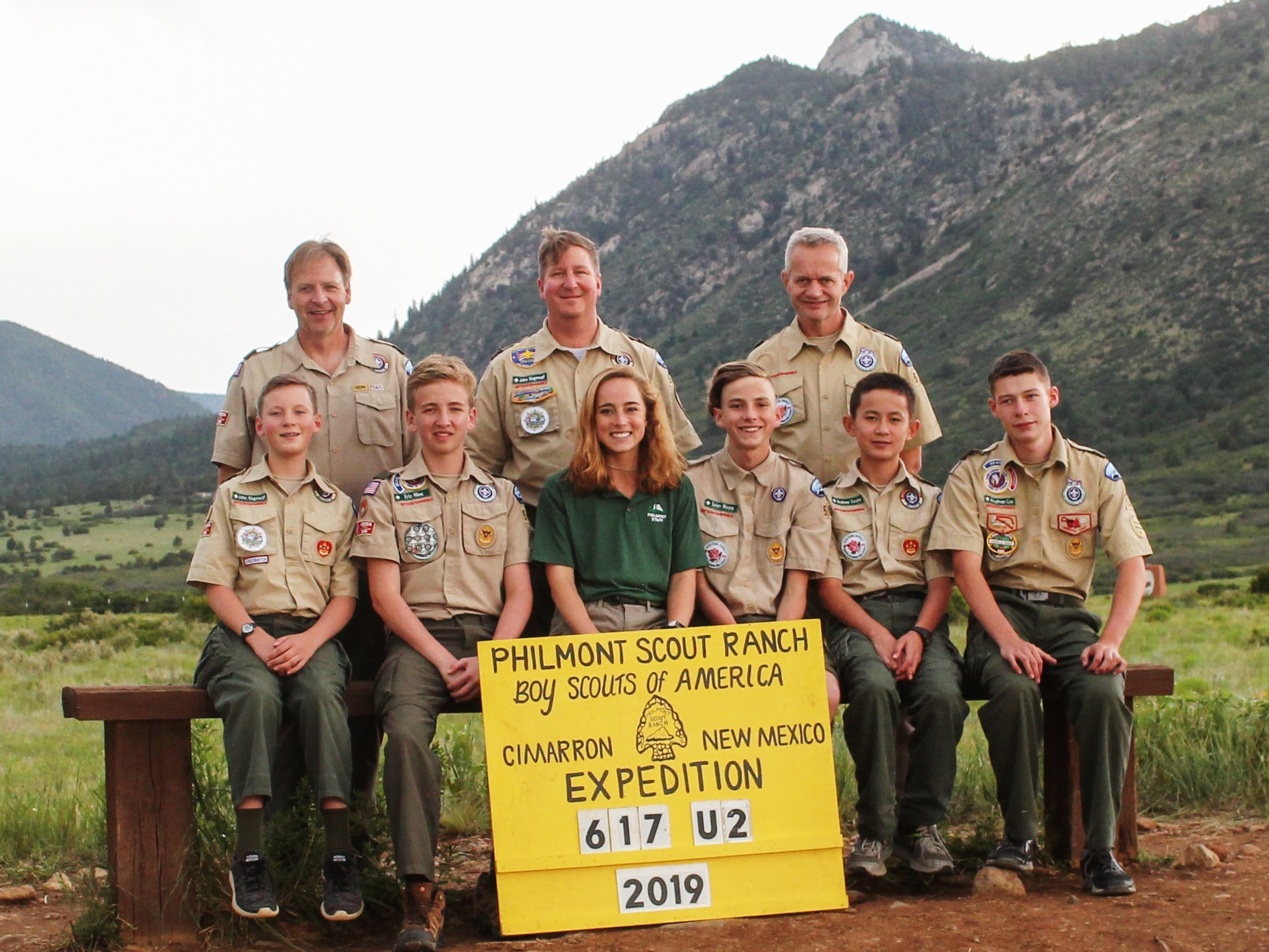
June Crew, Itinerary 30 front l-r: crew leader John Klapmust, Eric Miles, ranger Erin McCullagh, Dylan Moore, Andrew Forster, Jonathan Cox back l-r: Mr. Steve Miles, lead advisor Mr. John Klapmust, Mr. David Forster 
July Crew front l-r: Quentin Holmes, Nikitas Klapsis, Ryan King, ranger Dan Condra, crew leader Henri Gang, Sahith Cherumandanda, Allison King back l-r: Mrs. Karen King, Mr. Joe King, lead advisor Mr. Subbaiah Cherumandanda Jun. 15-30, 2019 We had two crews go in June, and one in July. All three took the train, leaving Union Station at 6 pm and arriving 22 hours later at 5 pm in Raton, NM. The train seats were wide with lots of legroom and pull-out foot rests for sleeping. The scouts spent much of the time playing cards and board games in the observation car. The July crew shared its train with crews from La Cañada Troop 502 and La Crescenta Crew 288. At Raton a Philmont bus picked us up and drove us 45 miles to Philmont's base camp at elevation 6,600'. We spent the night in platform tents (one scout slept in a duffel bag because he forgot his sleeping bag), then the next morning a ranger was assigned to each crew. The crews spent the rest of the day picking up tents, equipment and food and making other preparations. We also toured Villa Philmonte and the National Scouting Museum. We ate in the cafeteria and spent another night in platform tents. The next morning a Philmont bus took each crew to its trailhead. June Crew, Itinerary 5. Our trailhead was Lovers Leap. Our itinerary, no. 5, totaled 54 miles over 11 days with 11,918' elevation gain and was a clockwise loop through Philmont's south country, ending by hiking into base camp via Tooth of Time. The ranger stayed with us the first two days on the trail. Our campsites were Lovers Leap, North Fork Urraca, Beaubien (2 nights), Comanche Creek, Comanche Peak (dry, 11,100'), Sawmill, Lamberts Mine, Hunting Lodge and Shaefers Pass (dry). We picked up food at Phillips Junction and Sawmill. We summited Mt. Phillips (11,740'), Comanche Peak and Tooth of Time. Our activities included horseback riding, rifle shooting, black powder rifle, branding, mine tour, gold panning, cabin tours, campfire shows and chuckwagon dinner. Our conservation project was trail reconstruction near Cyphers Mine. We had almost no rain. One of our adults broke his ankle on day 7 near Comanche Peak and was evacuated to base camp where he waited for the crew to finish. After we lost him, we finished the trek with our sister crew from Troop 1363 in Woodbridge, VA. June Crew, Itinerary 30. Our trailhead was Lovers Leap. Our itinerary, no. 30, totaled 95 miles over 11 days with 14,780' elevation gain and was a clockwise loop through Philmont's south country, ending by hiking into base camp via Tooth of Time. The ranger stayed with us the first two days on the trail. Our campsites were Lovers Leap, Urraca, Abreu, Miners Park, Black Mountain, Bear Canyon, Crooked Creek, Mt. Phillips (dry), Cyphers Mine and Ponderosa Park (dry). We picked up food at Miners Park and Apache Springs. We summited Black Mtn., Mt. Phillips (11,740'), Comanche Peak and Tooth of Time. Our activities included spar pole climbing, rock climbing, horseback riding, challenge activities, black powder rifle, archery with 3-D targets, gold panning, branding, adobe brick making, mine tour, cabin tours, campfire shows, Mexican dinner and chuckwagon dinner. Our conservation project was constructing a new trail between Cyphers Mine and Whistle Punk. We had almost no rain. July Crew. Our trailhead was Six Mile Gate. Our itinerary, no. 23, totaled 64 miles over 11 days with 9,216' elevation gain and was a counterclockwise loop through Philmont's north country. The ranger stayed with us the first two days on the trail. Our campsites were Anasazi, Cook Canyon, Seally Canyon, Whiteman Vega, Iris Park, Upper Greenwood, Copper Park, Miranda, Pueblano and Ponil. We picked up food at Ring Place and Baldy Town. We summited the highest peak at Philmont, Baldy Mtn. (12,441'). We hiked for two days with a burro we named Pedro. Our activities included mountain biking, revolver, rifle, black powder rifle, shotgun, mountain ball, mine tour, gold panning, branding, campfire show, cantina show and chuckwagon dinner. Our conservation project was cutting logs to restore an unwanted mountain bike trail near Ring Place. On the last day a Philmont bus picked us up at the Ponil turnaround and brought us back to base camp. On many days we had afternoon or evening thundershowers. Two days we had to take lightning position and wait out the rain and lightning storm. At Pueblano, there was a bear attack on a camp next to ours and we had to move our tents to another camp site at 1 am. For all three crews, once back at base camp, we spent a final night in platform tents, then the next morning a Philmont bus took us to Raton for an 11 am train, and we arrived back at Union Station early the next day. A six-minute video about the trip can be seen HERE. The cost was $1,236 ($970 to Philmont, $188 for the train and bus, and $78 for the crew shirt, maps, fuel, patches and miscellaneous). The trip was organized by Mr. Haxton. |
Sea Base 2018 |
|---|
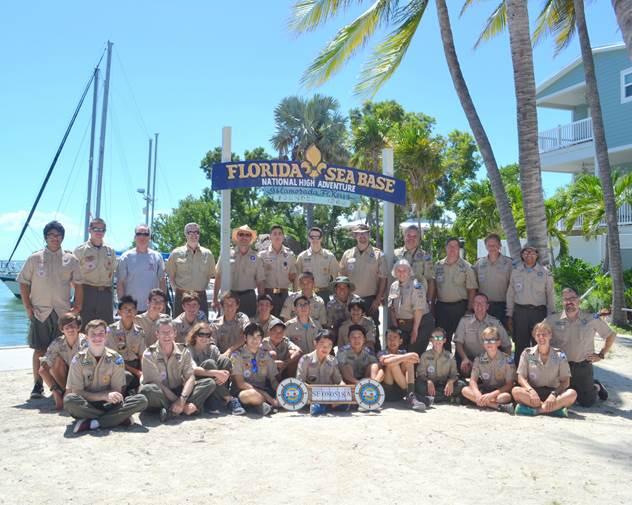
Bounty, Potemkin & Caine Crews front l-r: Jonathan Shiner, Mr. Max Shiner, Dylan Moore, Jean-Luc Lesaca, Sebastian Aviles-Maya, Albert Yan, Henri Gang, Benjamin Liu, John Klapmust, Eric Miles, Ms. Gayle Hagegard middle l-r: Daniel Hagegard, Luke Yang, Corwin Hill, Eric Hagegard, Stephen Badescu, Michael Gray, Tom Oghalai, Max Fan, Dylan Ghezzo, Michael Shaikh, Mrs. Sylvia Kast, Mr. Etienne Houseknecht, Mr. Jean-Claude Lesaca back l-r: Alexander Shaikh, Jack Andrews, Mr. Mircea Badescu, Mr. Mark Swain, Mr. Tom Andrews, Sebastian Houseknecht, Forrest Swain, Mr. Paul Ghezzo, Dr. Martin Kast, Mr. John Klapmust, Mr. Steve Miles, Mr. Paul Shaikh 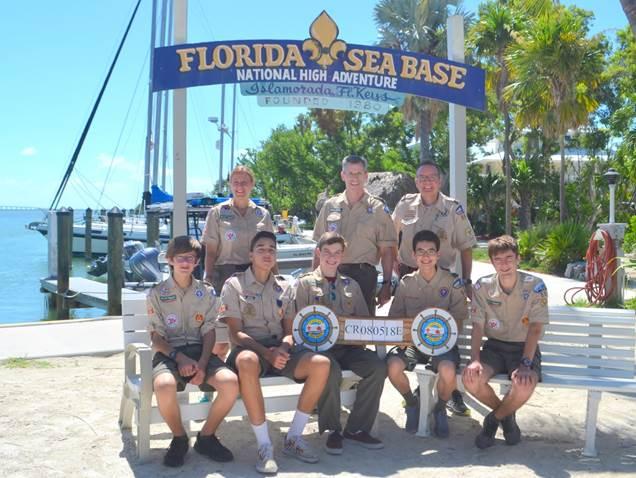
Potemkin front l-r: Daniel Hagegard, Sebastian Houseknecht, Jonathan Shiner, crew leader Corwin Hill, Eric Hagegard back l-r: Ms. Gayle Hagegard, Mr. Max Shiner, lead advisor Mr. Etienne Houseknecht 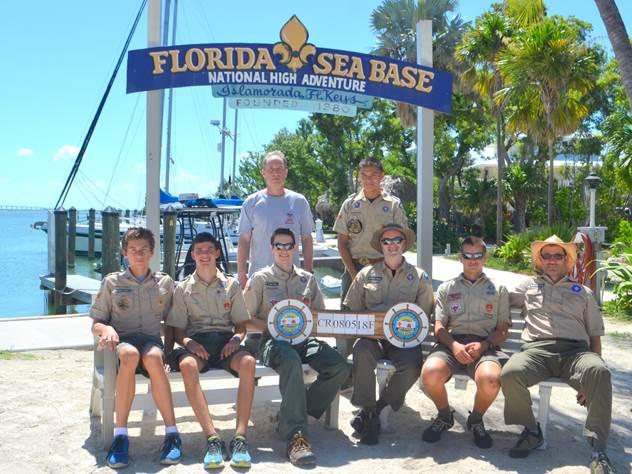
Caine front l-r: Stephan Badescu, Michael Gray, Forrest Swain, Mr. Mark Swain, crew leader Jack Andrews, Mr. Tom Andrews back l-r: lead advisor Mr. Mircea Badescu, Max Fan Aug. 4-12, 2018 We were 23 scouts and 13 adults in three crews. The Potemkin and Caine crews, each with 5 scouts and 3 adults, did the Coral Reef Sailing program, which is six nights on a 40' sailboat sailing out of Islamorada. The Bounty crew, with 13 scouts and 7 adults, did the Sea Exploring program, which is seven nights on a 80' schooner (tall ship) sailing out of Key West. We all took a red-eye together from LAX to Miami on American Airlines, leaving at 11 pm and arriving at 7:30 am. Charter vans drove us 45 minutes to Gator Park in Everglades National Park, where we explored the Everglades on airboats, watched a wildlife show and held an alligator. The vans then drove us two hours to Sea Base in Islamorada, about halfway down the Florida Keys, arriving at 2:30 pm for orientation and swim tests in Sea Base's pool. Potemkin & Caine crews. We set sail that first evening, Potemkin on Sweet Melissa and Caine on Escape, and spent the week swimming, snorkeling and fishing, in hot and humid weather with occasional thunderstorms. We cooked meals and slept on the boats, mostly on the deck where it was cooler. It was lobster season, so we also caught and ate lobster. Mid-week, we docked one night at John Pennekamp Coral Reef State Park, where we cleaned the boats, took showers, visited the local museum, ate pizza, watched a movie, and because of the swarms of mosquitoes on land, slept crammed below deck in air conditioning. Highlights of the trip included snorkeling in Molasses Reef, diving 20' to view the cannons and anchor of the 1733 shipwreck San Pedro, seeing reef sharks, nursing sharks, barracudas, a green sea turtle, and parties of lobsters, plus we had a conch shell blowing competition. At the end of the week the boats returned to Sea Base and we had a farewell luau with a limbo competition. After a night in dorms, we were picked up at 9:30 am by charter vans, stopped four miles away at Robbie's to feed the tarpons, and continued on to Miami airport for a 2:30 pm flight, which landed at LAX at 5 pm. Bounty crew. We spent the first night in dorms at Sea Base, and the next morning, after the flag ceremony and breakfast, filled coolers with food and ice and rode in vans nearly two hours to Key West, at the southern tip of the Florida Keys, to board the schooner Jolly II Rover. During the week we did a lot of swimming, snorkeling and fishing, made good use of the ship's rope swing and gang plank, climbed the ship's rigging, and fired the ship's cannon. We cooked meals and slept on the ship, most of us on the upper deck due to the heat and humidity. Mid-week, we docked one night at Key West, but our stay was longer than planned due to repairs that needed to be made to the ship's transmission. We filled the time by touring Truman's Little White House, the old lighthouse (where we could see into Ernest Hemingway's gardens), the Eco-Discovery Center, the Coast Guard cutter Ingham floating maritime museum, and the Mel Fisher maritime museum. We also had ice cream and Key lime pie, and walked to the official marker of the southernmost point of the continental U.S. Highlights of the trip included snorkeling at Cottrell Reef, Sand Key Reef and Western Dry Rocks Reef, night watch duty off Boca Grande Key, feeding sharks on the side of the ship at night, a movie night, finding a message in a bottle at Boca Grande Key, and catching and eating blackfin tuna. Most of us joined the 100 Fathom Club by swimming in 710' deep water. At the end of the week we returned to Key West, cleaned the ship, then took vans back to Islamorada where we had a farewell luau in monsoon-like rains, and spent the night in dorms. The next day at 9:30 am charter vans took us to Miami International, but local thunderstorms delayed us four hours so we didn't take off until 6:30 pm, landing at LAX at 9 pm. A 10-minute video about the trip can be seen HERE. The Potemkin crew sailed on Sweet Melissa with captain Mike "Smitty" Smith: crew leader Corwin Hill, Daniel Hagegard, Eric Hagegard, Sebastian Houseknecht, Jonathan Shiner, lead advisor Mr. Etienne Houseknecht, Ms. Gayle Hagegard, Mr. Max Shiner (adventure CR080518-E). The Caine crew sailed on Escape with captain Ron Kinkead: crew leader Jack Andrews, Stephan Badescu, Max Fan, Michael Gray, Forrest Swain, lead advisor Mr. Mircea Badescu, Mr. Tom Andrews, Mr. Mark Swain (adventure CR080518-F). The Bounty crew sailed on Jolly II Rover with captain Rhon Opiela, co-captain Patrick Barton, and guides Courtney Weaver and Julia Caramanico: crew leader Alexander Shaikh, Sebastian Aviles-Maya, Henri Gang, Dylan Ghezzo, John Klapmust, Jean-Luc Lesaca, Benjamin Liu, Eric Miles, Dylan Moore, Tom Oghalai, Michael Shaikh, Albert Yan, Luke Yang, lead advisor Mr. Steve Miles, Mr. Paul Ghezzo, Dr. Martin Kast, Mrs. Sylvia Kast, Mr. John Klapmust, Mr. Jean-Claude Lesaca, Mr. Paul Shaikh (adventure SE080518-A) The cost was $1,553 ($871 to Sea Base, $485 for plane, $57 for charter vans, $140 for crew shirt, duffel bag, sheet sleeping bag, travel comfort kit, gator park admission, crew photos, patches, sunscreen and captain tips). The trip was organized by Mr. Haxton. |
Mt. Whitney 2017 |
|---|
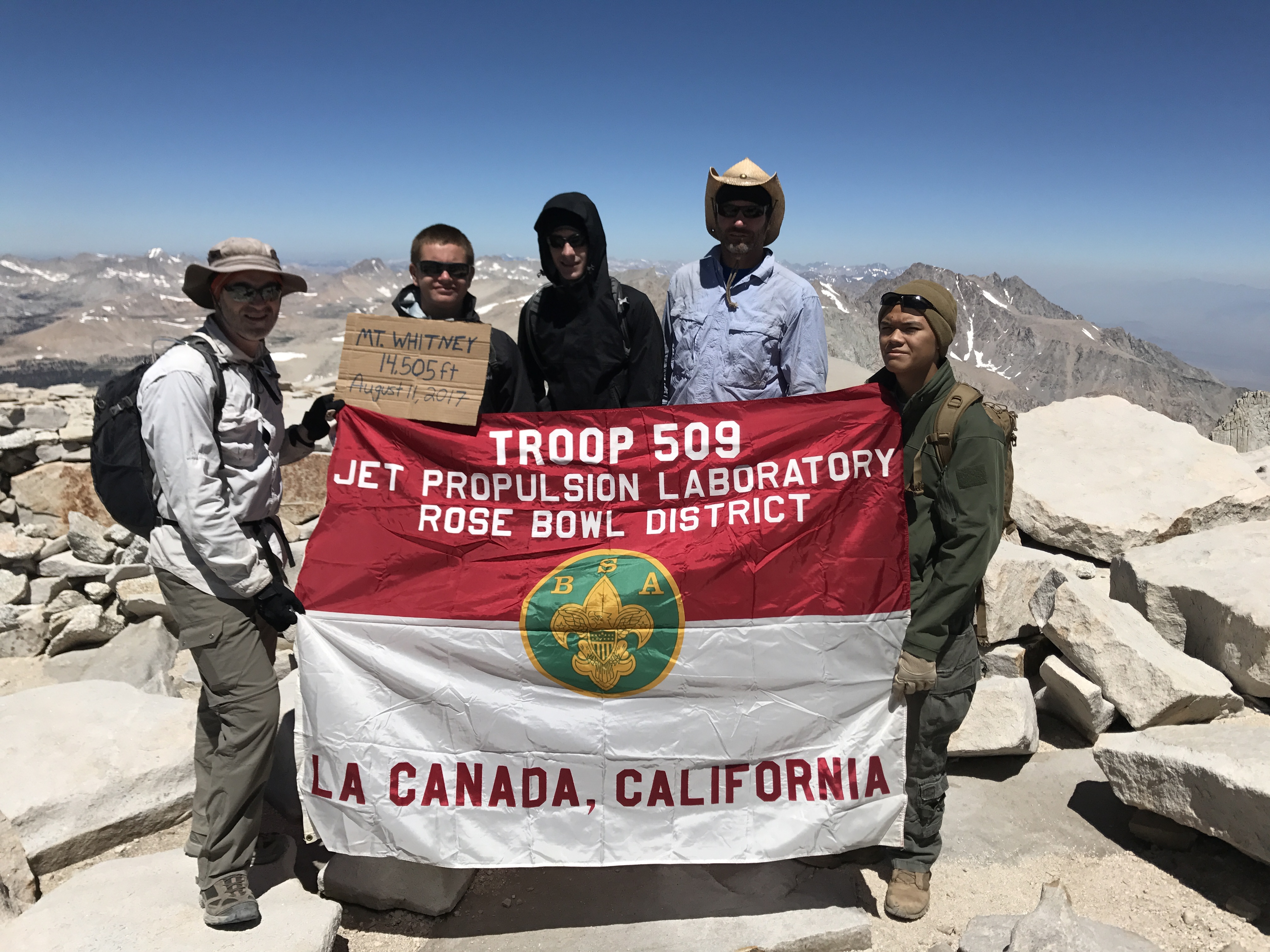
l-r: Mr. Mark Swain, Jack Andrews, Forrest Swain, Mr. Tom Andrews, Max Fan (not shown: Stefan Markarian & Mr. Greg Markarian, who also summited) Aug. 10-12, 2017 Of the 7 scouts and 5 adults who attempted to summit Mt. Whitney (14,508'), 4 scouts and 3 adults made it. One car left a day early and camped at Whitney Portal, 8,375', to acclimate to the altitude and get an early start hiking. The other cars left La Canada at 6:30 am and drove 3.5 hours, 220 miles, to Whitney Portal, stopping at the visitor center near Lone Pine to pick up the overnight permits we had secured in the spring in the annual permit lottery. Everyone hiked 6 miles on the Mt. Whitney Trail up to the barren and windy Trail Camp, 12,000', and pitched tents and cooked freeze-dried dinners. During the night, one of the scouts experienced significant altitude sickness and was unable to continue. The next morning he and the others in his car hiked back down to Whitney Portal and drove home. The other four scouts and three adults, with daypacks, hiked 5 miles to the summit of Mt. Whitney, then returned to Trail Camp. Because of the previous winter's high snowfall, the 99 switchbacks had only recently become passable and there were still snow patches between Trail Crest and the summit. One scout and one adult camped a second night at Trail Camp, but the other three scouts and two adults hiked down to Outpost Camp for its more pleasant meadow and waterfall. The next morning we all hiked back to Whitney Portal and drove home. The total distance was 11 miles up and 11 miles down. The cost was $50 ($17 for permit, $33 for gas), plus whatever each person spent on food. The trip was organized by Mr. Haxton. |
Philmont 2017 |
|---|
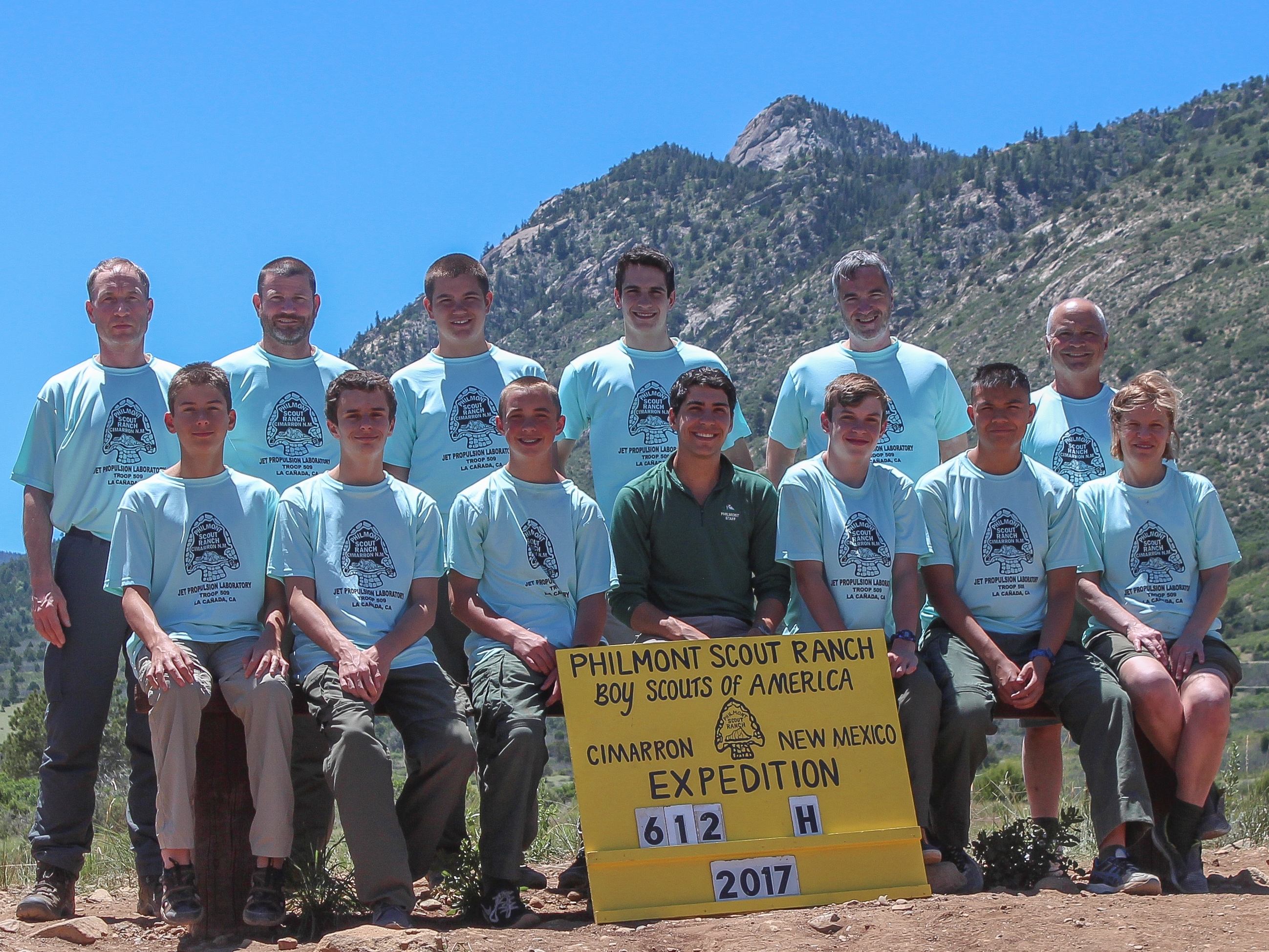
front l-r: Stephan Badescu, Gino Graziadio, Jack Olson, ranger Ethan Moss, Jonathan Shiner, crew leader Max Fan, Mrs. Libby Shiner back l-r: Mr. Mircea Badescu, Mr. Tom Andrews, Jack Andrews, Forrest Swain, lead advisor Mr. Mark Swain, Mr. George Olson Jun. 10-25, 2017 We left on the train at 7 pm from Union Station, and 23 hours later arrived one hour late at 7 pm in Raton, NM. The train seats were wide with lots of legroom and pull-out foot rests for sleeping. The scouts spent much of the time playing cards in the observation car. A Venturing crew from La Crescenta was on the train with us. At Raton a Philmont bus picked us up and drove us 45 miles to Philmont's base camp at elevation 6,600'. We spent the night in platform tents, then the next morning a ranger was assigned to our crew. We spent the rest of the day picking up tents, equipment and food and making other preparations. We also toured Villa Philmonte. We ate in the cafeteria and spent another night in platform tents. The next morning a Philmont bus took us to our trailhead at Six Mile Gate. We were on itinerary no. 33, which totaled 86 miles over 11 days, starting in the north country and ending by hiking into base camp via Tooth of Time (in reality, we hiked about 120 miles). The ranger stayed with us the first two days on the trail. Our campsites were Anasazi, Horse Canyon, Sioux, Pueblano, Maxwell (2 nights), Black Jacks, Harlan, Cimarroncito and Upper Clarks Fork (dry). We picked up food at Ponil, Baldy Town and Ute Gulch. We visited Indian Writings, Dan Beard, Miranda, Head of Dean, Hunting Lodge and Clarks Fork. We summited 12,441' Baldy Mountain (on Father's Day), Hart Peak and Tooth of Time. We hiked for two days with a burro we named Churro. Our activities included rock climbing, spar pole climbing, horseback riding, shotgun shooting, black powder rifle shooting, spear throwing, campfire show, T. rex track, petroglyphs and challenge activities. Our conservation project was trail construction near Harlan. We had hot, dry weather the entire trek, with the exception of a hail storm at Harlan and some lightning. After a pizza feast upon our return to base camp, we spent our final night in platform tents, then the next morning a Philmont bus took us back to Raton for an 11 am train, and we arrived back at Union Station three hours late at 11 am the next day. The La Canada Valley Sun wrote about the trip HERE. The cost was $1,225 ($895 to Philmont, $249 for the train and bus, and $81 for the crew shirt, maps, fuel, patches and miscellaneous). The trip was organized by Mr. Haxton. |
Northern Tier 2016 |
|---|
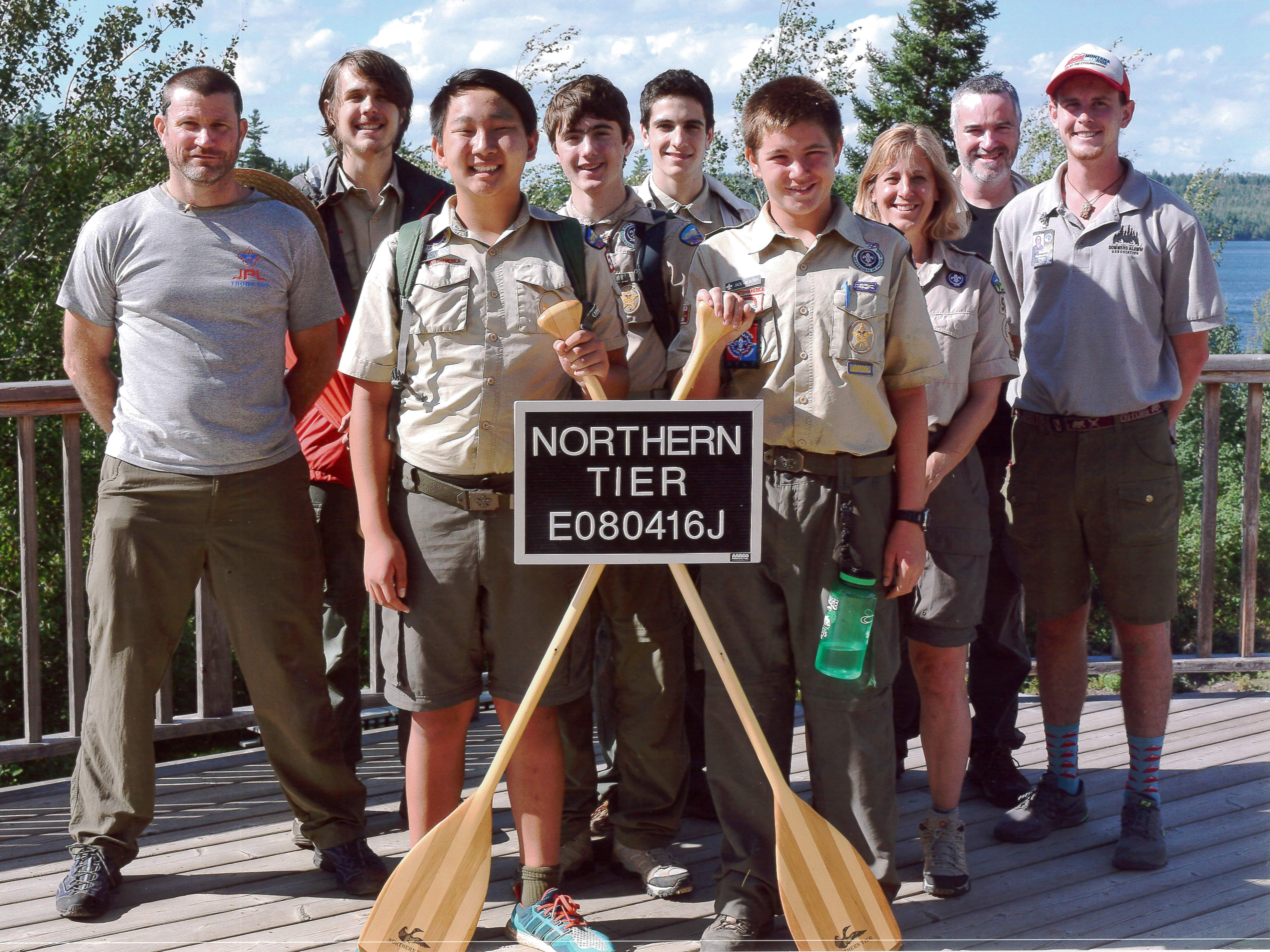
Juno l-r: Mr. Tom Andrews, crew leader Zach Nash, Lucas Oh, Eric Hagegard, Forrest Swain., Jack Andrews, lead advisor Ms. Gayle Hagegard, Mr. Mark Swain, interpreter Ben Rutherford 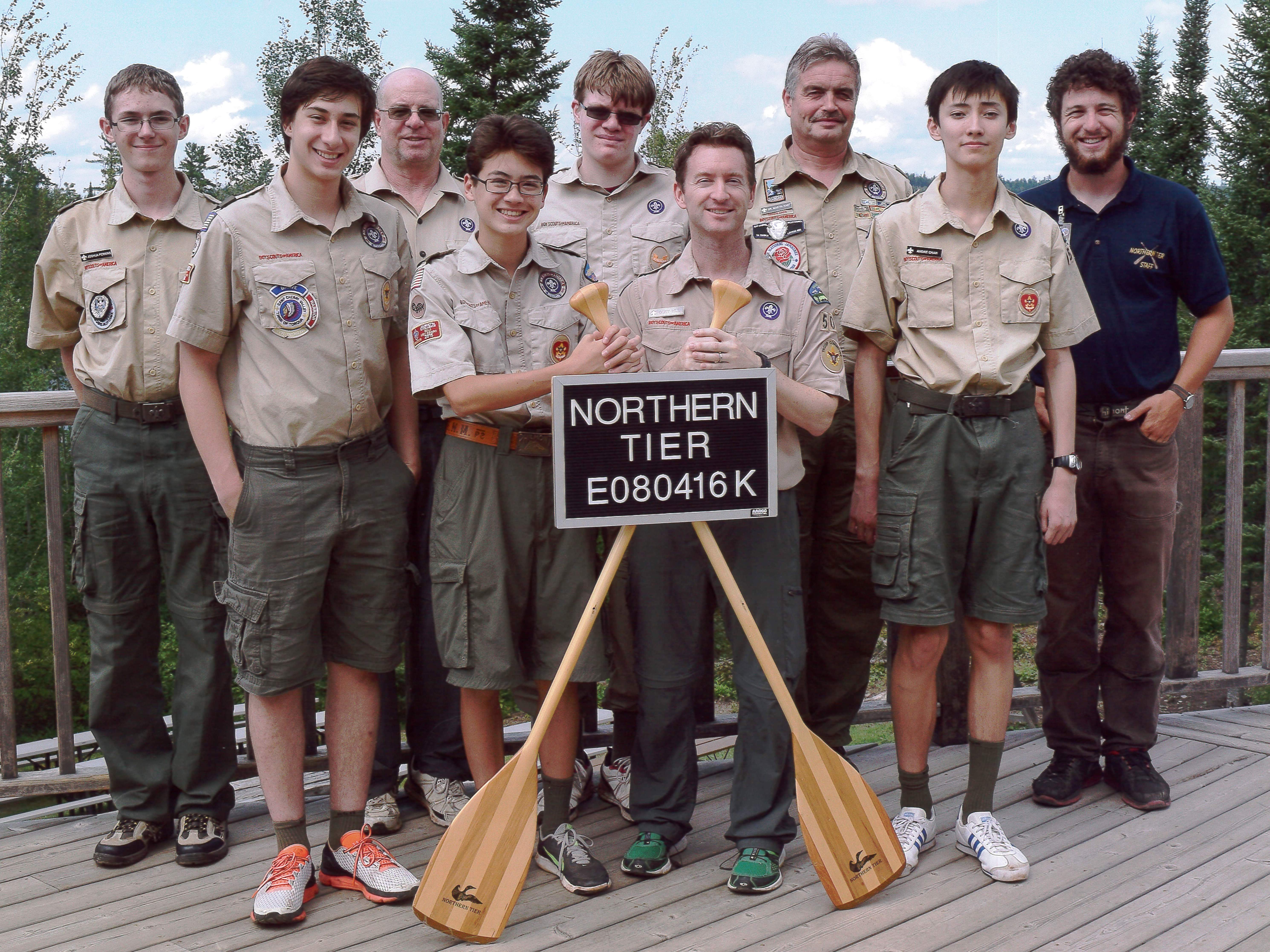
Cassini l-r: crew leader Josh Perkins, Andre Der Sarkissian, Mr. David Haxton, Corwin Hill, Miles Haxton, lead advisor Mr. Cory Hill, Dr. Martin Kast, Andre Galenchik-Chan, interpreter Josh Marks Aug. 3-12, 2016 We flew from Burbank to Minneapolis at 8 am on Southwest Airlines. Two charter vans with a trailer picked us up at the airport and drove us three and a quarter hours, 210 miles, to Biwabik, Minn., where we spent the night in our sleeping bags in a hostel. The next morning the vans drove us to the Soudan underground iron ore mine where we toured the mine and its physics lab, then the vans delivered us at 1 pm to Northern Tier near Ely, Minn. We spent 8 nights at Northern Tier, the first and last at base camp at Moose Lake, and the other 6 nights camping at a different lake every night. Each crew consisted of 3 canoes carrying 5 scouts, 3 adults and a Northern Tier interpreter (guide). The two crews followed the same route in the Boundary Waters Canoe Area Wilderness, but in opposite directions, and never saw each other. We traveled a total of 101 miles through 43 lakes with 42 portages and 4 walked rapids. Some of the lakes were on the international boundary between the U.S. and Canada, and a couple of the portages were on Canadian soil. The outing was two weeks after a big wind storm, making several portages difficult to cross because of the fallen trees. We paid extra for the lighter 45-lb Kevlar canoes, but they still seemed heavy. Those who fished caught walleye and smallmouth bass, but the fishing wasn't all that great. One canoe with three adults, while paddling in wind and whitecaps, took on too much water and sank. They started swimming to Canada, the nearest land, but were soon rescued by a water taxi. The crew's gear box, including cooking equipment, ended up on the bottom of the lake and for the rest of the trip the crew ate cold food. One scout was trying to avoid use of the latrines, so with his dad's permission some dish soap was slipped into his food and it worked. The morning of the last day the charter vans picked us up at Northern Tier and returned us to the Minneapolis airport, and we arrived in Burbank late that night. Northern Tier provided the tents, backpacks, cooking equipment and food. The La Canada Valley Sun wrote about the trip HERE. The cost was $1,287 ($700 to Northern Tier, $335 for plane, $144 for van, $25 for hostel and $83 for crew shirt, mine tour, maps, patches and other expenses). The trip was organized by Mr. Haxton. |
Mt. Whitney 2015 |
|---|

l-r: Miles Haxton, Mr. Cory Hill, Mr. Joe Kunkle, Ian Kunkle, Jack Andrews, Grant McComb, Osa Adler, Mr. Jerzy Grabiec, Annemarie Kunkle, Ms. Elizabeth Olejarczyk, Mr. Tom Andrews, Dr. Ying Lin, Eric Lin, Mr. David Haxton, Mr. Nan Yu, Corwin Hill Jul. 17-19, 2015 All 8 scouts and 8 adults made it to the summit of Mt. Whitney (14,508'). We left La Canada at 6:30 am and drove four hours, 220 miles, to Whitney Portal, stopping at the visitor center near Lone Pine to pick up the overnight permits we had secured in the spring in the annual permit lottery. After lunching on giant hamburgers at Whitney Portal Store (they also make giant pancakes for breakfast), and taking our time to acclimate to the altitude, 8,375', we hiked 6 miles on the Mt. Whitney Trail up to the barren and windy Trail Camp, 12,000', arriving at dusk, and pitched our tents and cooked our freeze-dried dinners. Early the next morning, with daypacks, we hiked 5 miles to the summit of Mt. Whitney. A thunderstorm was approaching so we had to hurry off the mountain, hiking 5 miles back down to our tents at Trail Camp. At the higher elevations it was cold enough that gloves were needed, and there were snow flurries that didn't stick. We had to keep all food in bear canisters due to the marmots, and most people found they brought too much food because they had no appetite at altitude. A few got altitude headaches, and one scout vomited but kept going. Human waste had to be packed out in disposal kits distributed at the visitor center. The next morning we hiked 6 miles back to Whitney Portal, ate another giant hamburger, and drove home, arriving mid-afternoon. The La Canada Valley Sun wrote about the trip HERE. The cost was $50 ($17 for permit, $33 for gas), plus whatever each person spent on food. The trip was organized by Mr. Haxton. |
Philmont 2015 |
|---|

Opportunity front l-r: Annemarie Kunkle, crew leader Ian Kunkle, Kacper Grabiec, ranger Darren Anderton, Nathan de Moura, Andrew Overing, Owen Serricchio back l-r: Mrs. Melora Larson (Nash), Zach Nash, Eric Lin, Mr. Jerzy Grabiec, lead advisor Mr. Fred Serricchio, Mr. Joe Kunkle 
Spirit front l-r: Brett Bell, Stefan Markarian, Josh Perkins, Andre Galenchik-Chan, ranger Ben Banavig, Sebastian Houseknecht, crew leader Miles Haxton, Corwin Hill back l-r: Mr. Cory Hill, Mr. Greg Markarian, lead advisor Mr. Darren Bell, Mr. Etienne Houseknecht, Mr. David Haxton Jun. 16-Jul. 1, 2015 We left on the train at 6 pm from Union Station, and 22 hours later arrived at 5 pm in Raton, NM. The train seats were wide with lots of legroom and pull-out foot rests for sleeping. The scouts spent much of the time playing cards in the observation car. A troop from Santa Cruz was on the train with us. At Raton a Philmont bus picked us up and drove us 45 miles to Philmont's base camp at elevation 6,600'. We spent the night in platform tents, then the next morning a ranger was assigned to each crew. The crews spent the rest of the day picking up tents, equipment and food and making other preparations. We also toured Villa Philmonte. We ate in the cafeteria and spent another night in platform tents. The next morning a Philmont bus took us to our trailhead at Turkey Creek. Both crews were on the same itinerary, no. 16, which totaled 73 miles over 11 days with 12,500' of elevation gain and was a counterclockwise three-quarter loop through Philmont's central and south countries, ending by hiking into base camp via Tooth of Time. The ranger stayed with us the first two days on the trail. Our campsites were Vaca, Deer Lake, Upper Sawmill, Comanche Peak (dry, 11,100'), Crooked Creek, Lost Cabin (dry), Beaubien (2 nights), Crater Lake and North Fork Urraca. We picked up food at Ute Gulch and Phillips Junction. We summited Comanche Peak, Mt. Phillips (11,740'), Bonito Peak, Trail Peak and Tooth of Time. Our activities included rock climbing, archery with 3-D targets, spar pole climbing, horseback riding, shotgun shooting, rifle shooting, tepee sauna, plane crash wreckage, fly tying, branding, campfire shows and chuckwagon dinner. Our conservation projects were trail reconstruction at Crater Lake and moving rocks at Beaubien. Our weather included a lengthy hailstorm that covered the trail and campsite with a thick layer of hail, and a long and hard overnight thunderstorm. Our final night was in a platform tent at base camp, then the next morning a Philmont bus took us back to Raton for an 11 am train, and we arrived back at Union Station one hour late at 9 am the next day. A 15-minute video about the trip can be seen HERE, and a one-minute trailer can be seen HERE. The La Canada Valley Sun wrote about the trip HERE. The cost was $1,168 ($855 to Philmont, $241 for the train and bus, and $72 for the crew shirt, maps, fuel, patches and miscellaneous). The trip was organized by Mr. Haxton. |
Sea Base 2014 |
|---|
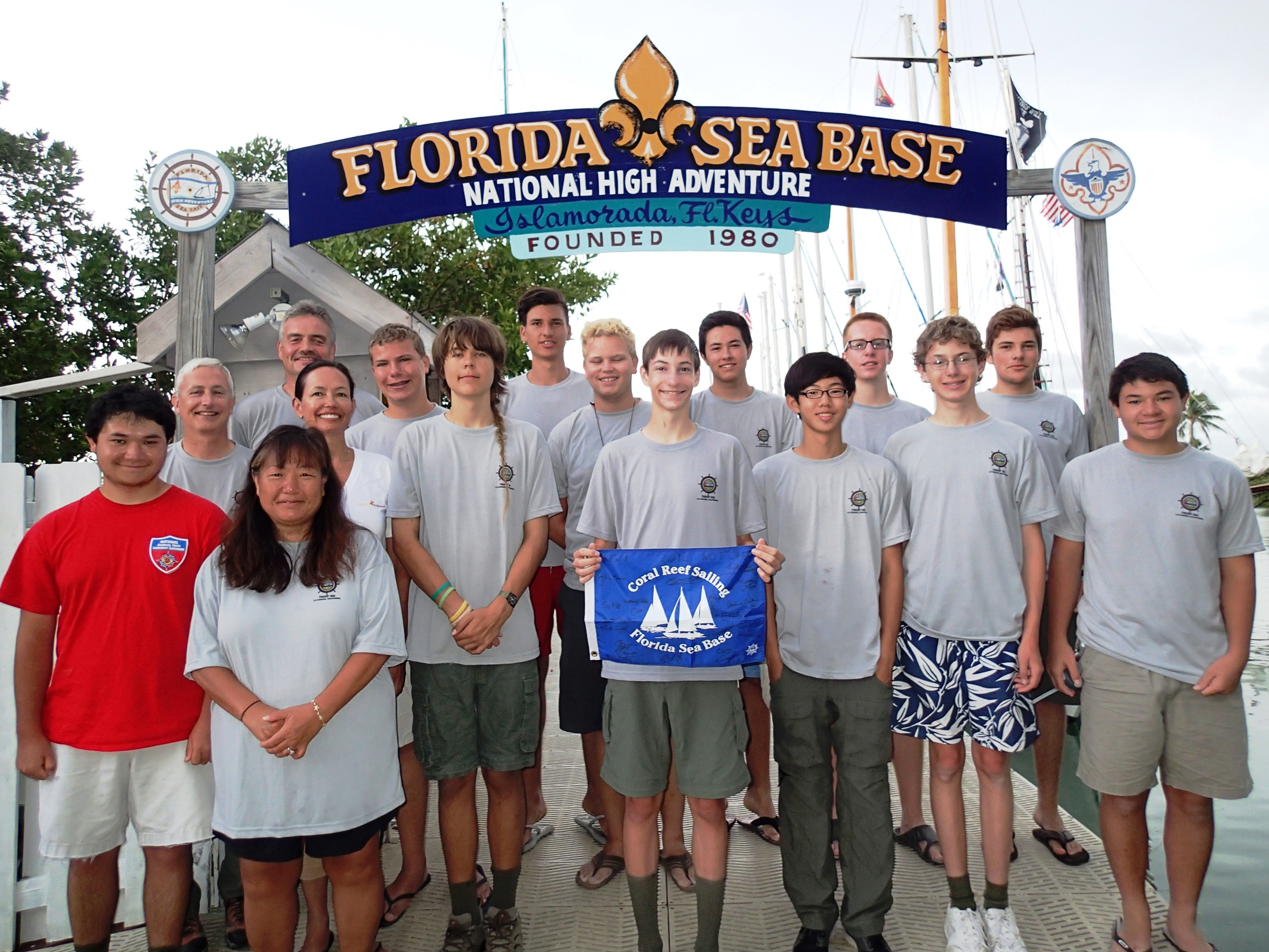
l-r: Billy Adler, Mr. Nigel Angold, Mrs. Suko Gotoh (Adler), Dr. Martin Kast, Dr. Linda Segal, Andrew Gray, Zach Nash, Grant McComb, Harold Kast, Ethan Angold, Sean Segal, Matthew Kim, Grant Haxton, Josh Perkins, Alex McComb, Osa Adler Jul. 31-Aug. 8, 2014 Crew 1 sailed on Spindrift with captain Joe Wischmeier: crew leader Ethan Angold, Andrew Gray, Harold Kast, Matthew Kim, Zach Nash, Josh Perkins, lead advisor Mr. Nigel Angold, Dr. Martin Kast (expedition CRS 080214-A). Crew 2 sailed on Dutch Love with captain Harman Harkema: Billy Adler, Osa Adler, Grant Haxton, Alex McComb, crew leader Grant McComb, Sean Segal, lead advisor Mrs. Suko Gotoh, Dr. Linda Segal (expedition CRS 080214-B). We met at the Ralphs parking lot at 3:30 am and carpooled to LAX for a 6 am flight on American Airlines to Miami, arriving at 2:15 pm. We had two rental minivans from Budget and drove to Staybridge Suites in Plantation, near Ft. Lauderdale. The rest of the day we spent time on the beach and swam in the hotel pool. The next day we went to Gator Park for an airboat tour, then to Everglades National Park via the Shark Valley entrance to hike and ride bikes. After a second night in the hotel, we spent the morning at John Pennekamp Coral Reef State Park, and then arrived at Sea Base, midway down the Keys and 90 miles from Miami, at 1 pm. Both crews did the Coral Reef Sailing program, in which the crew spends six nights on a 40' sailboat owned by the boat's captain. We spent a lot of time swimming and snorkeling, and since our last two days on the water was the start of lobster season, we also caught and ate lobsters. One of the nights mid-week was spent in a dormitory at Sea Base, where we had access to small sailboats and other watercraft. We left Sea Base at 8 am in the rented minivans, made some stops on our way to the Miami airport for our 3:30 pm flight, and arrived back to LAX at 6 pm. The cost was $1,590 ($900 to Sea Base, $488 for plane, $147 for hotel, ground transportation and non-Sea Base activities, and $25 for the crew shirt). The trip was organized by Mrs. Gotoh (Adler). |
Philmont 2012 |
|---|
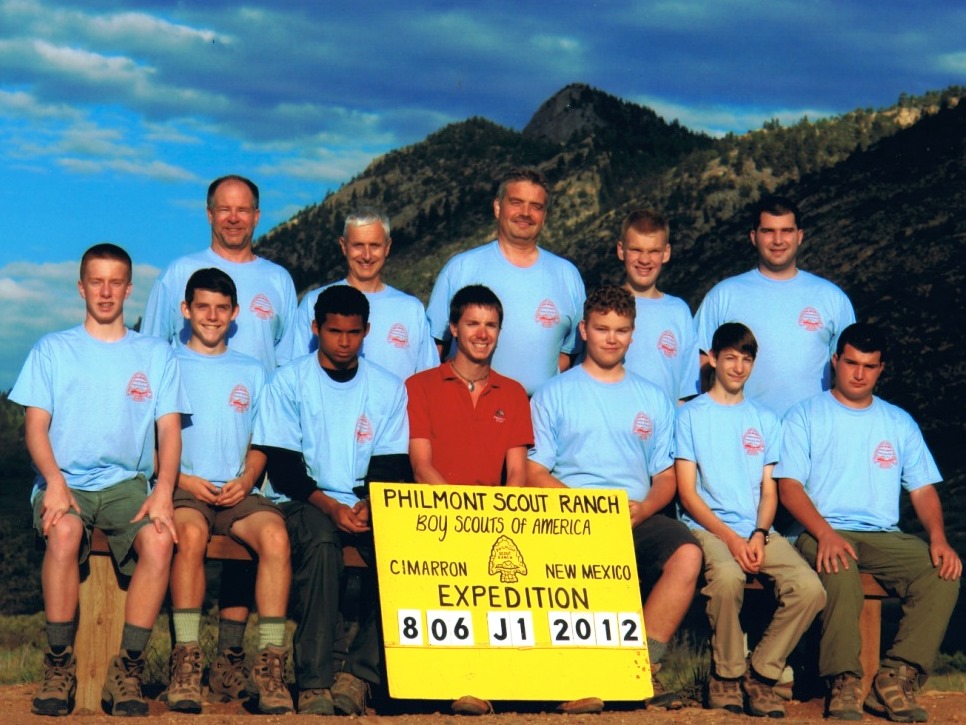
Super Crew front l-r: Grant Haxton, Sean Cutler, Noah Goldstein, ranger, crew leader Harold Kast, Ethan Angold, Daniel Layton back l-r: Mr. David Haxton, lead advisor Mr. Nigel Angold, Dr. Martin Kast, Ian de Moura, Mr. Joe Layton 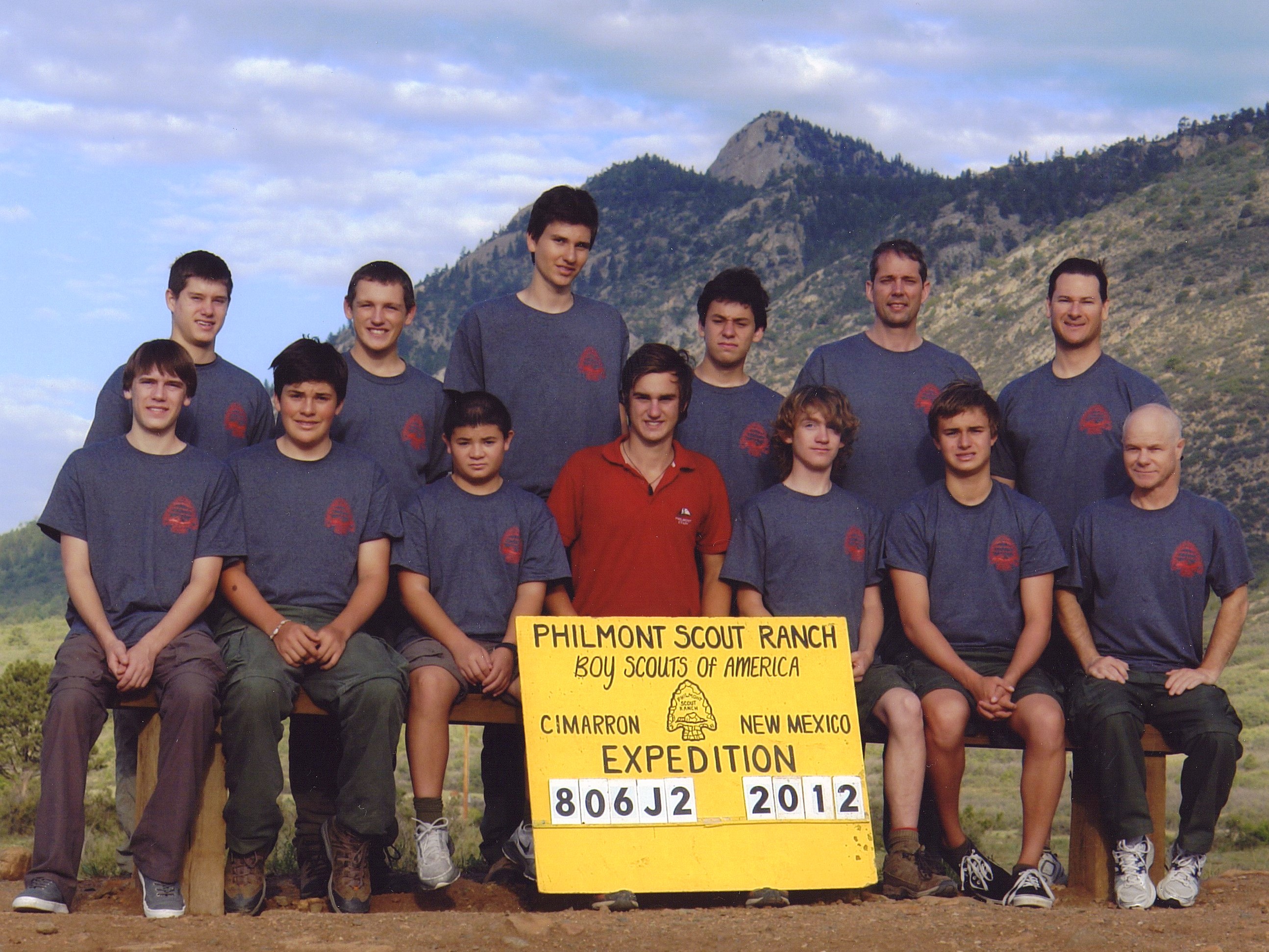
Monster Crew front l-r: Max Williams, Alex McComb, Osa Adler, ranger, Jack Lowe, Nick Bell, Mr. William Adler back l-r: Graham Miketta, crew leader Nathan Spindle, Grant McComb, Nick Mayer, lead advisor Mr. Paul Mayer, Mr. Darren Bell Aug. 6-18, 2012 We met at the Ralphs parking lot at 4:30 am to carpool to LAX for a 7 am flight on Southwest Airlines to Albuquerque, where a charter bus picked us up and drove us 3.5 hours, 220 miles, to Philmont, arriving around 1:30 pm. A ranger was assigned to each crew, and the crews spent the rest of the day picking up tents, equipment and food and making other preparations. We ate in the cafeteria and spent the night in platform tents. Super Crew hiked itinerary no. 21, which totaled 73 miles over 11 days and went from Philmont's south to central to north country. A Philmont bus took us to our trailhead at the Rayado turnaround, and later picked us up at the Ponil turnaround. Our ranger stayed with us the first two days on the trail. Our campsites were Rayado River, Bear Caves, Shaefers Pass (dry), Hunting Lodge, Visto Grande, Head of Dean, Miranda (2 nights), Pueblano and Ponil. We picked up food in Miners Park, Ute Gulch and Baldy Town. We summited Tooth of Time and Baldy Mountain (12,441'). We hiked with two burros for two days. Our activities included rock climbing, spar pole climbing, horseback riding, black powder rifle shooting, revolver shooting, challenge activities, adobe bricks, goat milking, cantina show, mountain ball, campfire shows and chuckwagon dinner. We toured Kit Carson Museum. Our conservation project was clearing and sawing downed trees at Miranda. Monster Crew hiked itinerary no. 24, which totaled 75 miles over 11 days in a counterclockwise loop in Philmont's north country, and also in Valle Vidal. A Philmont bus took us to our trailhead at Six Mile Gate, and later picked us up at the Bear Canyon turnaround. Our campsites were Anasazi, Old Camp, Seally Canyon, McCrystal Creek, Dan Beard, Ponil, Pueblano, Miranda (2 nights) and Santa Claus. We picked up food in Ring Place, Ponil and Baldy Town. We summited Baldy Mountain (12,441'). We hiked with two burros for two days. Our activities included spar pole climbing, horseback riding, black powder rifle shooting, revolver shooting, challenge activities, mountain biking, T. rex track, petroglyphs, search & rescue, cantina show, mountain ball, campfire show and chuckwagon dinner. Our conservation project was trail restoration at Seally Canyon. The two crews crossed once, when camping at Miranda. An adult sprained an ankle and couldn't continue, a scout was taken off trail for a day with stomach issues, and another scout broke his foot on one of the last days. Back at base camp we toured Villa Philmonte, then spent our final night in a platform tent. The next morning we left Philmont by charter bus and returned to the Albuquerque airport, finally arriving at LAX at 7:30 pm. The cost was $1,230 ($740 to Philmont, $300 for plane, $150 for bus, and $40 for crew shirt, maps, fuel, patches and miscellaneous). The trip was organized by Mr. Mayer. |
Mt. Whitney 2011 |
|---|

l-r: Jack Lowe, Mr. Paul Mayer, Connor Ryken, Sean Cutler, Mr. Kevin Lowe, Nick Mayer, Mr. Cory Ryken, Grant Haxton Aug. 2-5, 2011 All 5 scouts and 3 adults made it to the summit of Mt. Whitney (14,508'). We drove three and a half hours, 205 miles, to Lone Pine where we ate lunch at a restaurant. After lunch we drove to Horseshoe Meadow campground (10,000') and camped there for the night. The next morning we drove to Whitney Portal (8,375') and started hiking on the Mt. Whitney Trail. We hiked 6 miles to Trail Camp (12,000') and spent the night there. Early the next morning we hiked 5 miles to the summit of Mt. Whitney with daypacks, then returned 5 miles to our tents at Trail Camp and spent the night. The next morning we hiked 6 miles back to Whitney Portal and drove home, arriving mid-afternoon. The trip was organized by Mr. Ryken. |
Havasupai 2010 |
|---|

l-r: Mr. David Haxton, Mrs. Rebecca Drooks (Shur), Harold Kast, Sean Cutler, Nick Mayer, Keenan Shur, Ty Burnham, Grant Haxton, Tyler Adams, Mr. Paul Mayer, Nick Bell, Mr. Darren Bell, Dr. Walter Burnham, Sean Estes, Dr. Martin Kast, Mr. Marshall Adams not shown: Aaron Burnham, Miles Haxton, Mr. Chip Cutler April 3-6, 2010 Havasupai is an Indian Reservation in the Grand Canyon. The Havasupai Tribe issues permits for visitors to hike and camp on their land, which includes spectacular blue-green waterfalls framed by red canyon walls. On Sat. we drove eight hours, 435 miles, on I-40, Route 66 and Indian Hwy 18 to Hualupai Hilltop on the canyon rim and spent a cold and windy night in the parking lot sleeping in our cars or in tents. On Sun. we hiked 8 miles down switchbacks to the floor of Hualupai Canyon and through that canyon to the tribe's village, Supai, then 2 more miles through Havasu Canyon to the campground, just below Havasu Falls. Some of us paid for mules to carry our gear to the campsite. On Mon. we swam and played in the travertine pools below Havasu Falls, and hiked a mile further down the canyon where some of us descended to the bottom of 196'-tall Mooney Falls through caves and steps carved into the nearly vertical canyon wall. On Tue. we hiked 10 miles back to our cars parked on the canyon rim, except one dad who rode on a horse, and two families whose dads were in a hurry to get back to work and took a helicopter to the cars. We then made the long drive back to La Canada, except for one family who overnighted at Laughlin. The trip was organized by Mr. Mayer. |
Philmont 2009 |
|---|
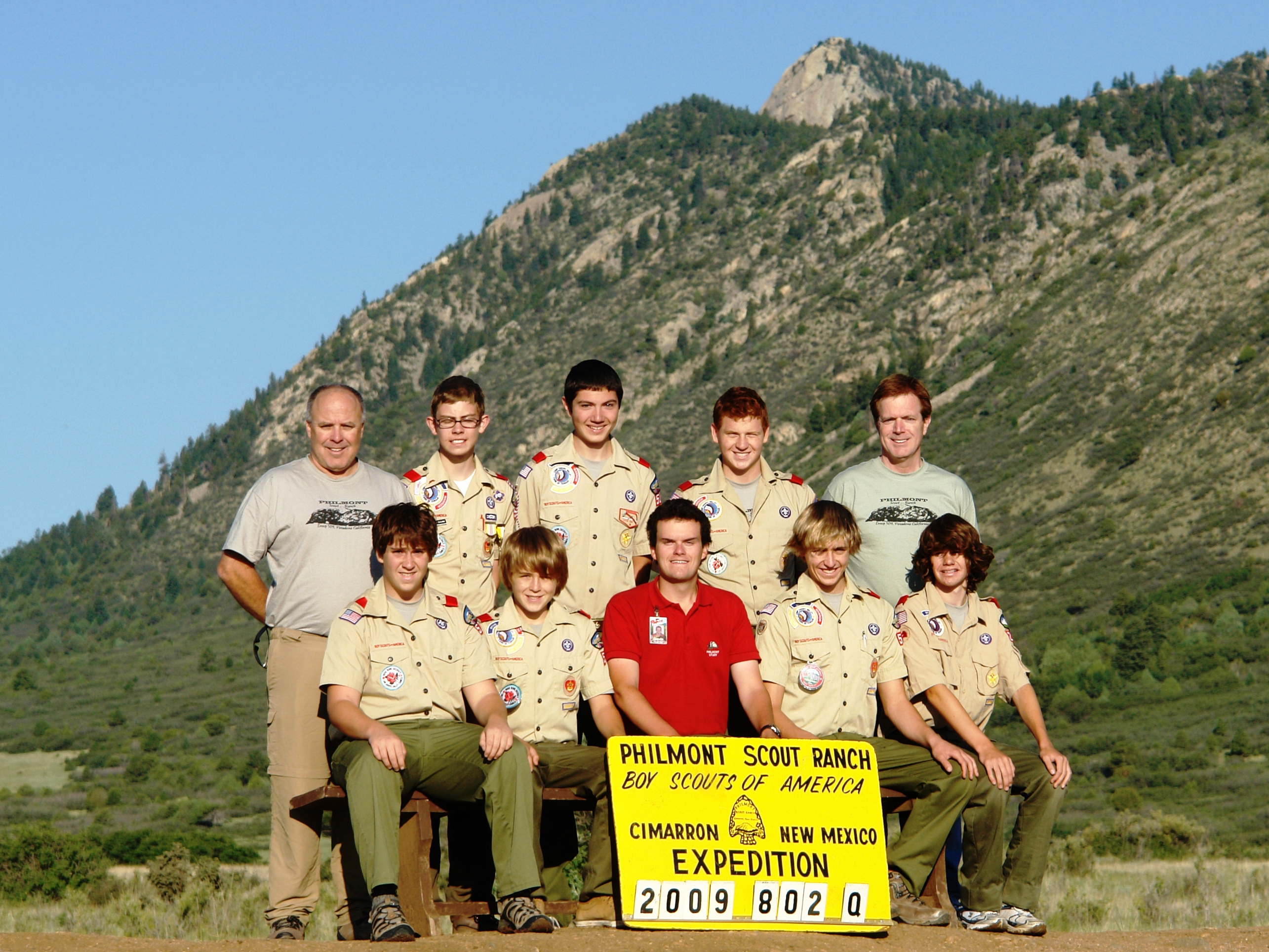
front l-r: Adam de Lucia, Ryan Wallace, ranger, Adam Wallace, Kevin Kussro back l-r: lead advisor Mr. Roger Wallace, crew leader Matthew Susank, Kevin O'Toole, Connor Chavarria, Dr. Martin O'Toole Aug. 2-14, 2009 We drove two cars with trailers to Philmont. We hiked itinerary no. 17, which totaled 65 miles over 11 days and was a clockwise loop through Philmont's south and central countries, ending by hiking into base camp via Tooth of Time. A Philmont bus took us to our trailhead at the Lovers Leap turnaround. Our ranger stayed with us the first two days on the trail. Our campsites were Lovers Leap, Urraca, Crater Lake, Beaubien (2 nights), Crooked Creek, Clear Creek, Thunder Ridge, Cathedral Rock and Tooth Ridge. We picked up food in Phillips Junction and Ute Gulch. We summited Trail Peak (10,250') and Tooth of Time. Our activities included rock climbing, spar pole climbing, horseback riding, black powder rifle, challenge events, gold mining, mine tour, blacksmithing, Stomp show, campfires and chuckwagon dinner. Our conservation project was at Beaubien. The Crescenta Valley Weekly wrote about the trip HERE. The trip was organized by Mr. Wallace. |
Forsee Creek Trail 2009 |
|---|
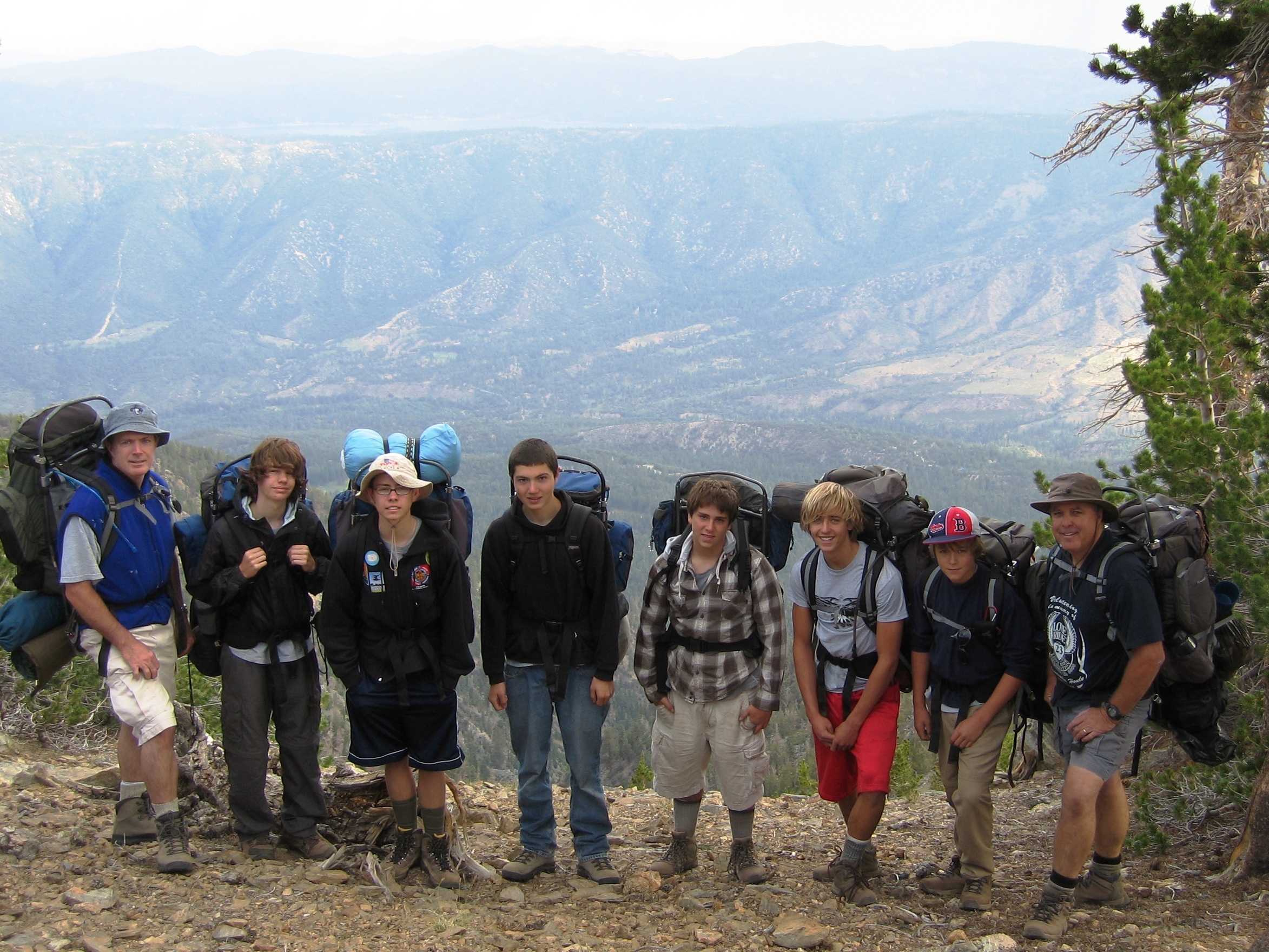
l-r: Dr. Martin O'Toole, Kevin Kussro, Matthew Susank, Kevin O'Toole, Adam de Lucia, Adam Wallace, Ryan Wallace, Mr. Roger Wallace not shown: Mr. Richard Key Jul. 18-19, 2009 Forsee Creek Trail is in the San Gorgonio Wilderness Area of the San Bernardino Mountains. Early Sat. we drove 100 miles to the Forsee Creek trailhead, which is east of Redlands traveling on CA-38 past Angelus Oaks and off Jenks Lake Rd. Starting at 9 am when the temperature was nearly 100 degrees, we hiked 7 miles with an elevation gain of 4,400' to Anderson Flat trail camp (10,500'), where the temperature was 75 degrees. Our only water source was a half-mile before the trail camp, at Trail Fork Springs. About half of us experienced symptoms of altitude sickness. After dinner we took a short twilight hike to Anderson Peak (10,840'), then returned and went to bed exhausted. We awoke early Sun. to a golden sunrise and made good time hiking down to the trailhead, arriving at 10:30 am. The trip was organized by Mr. Key. |
Mt. Lowe Snow Camping 2008 |
|---|
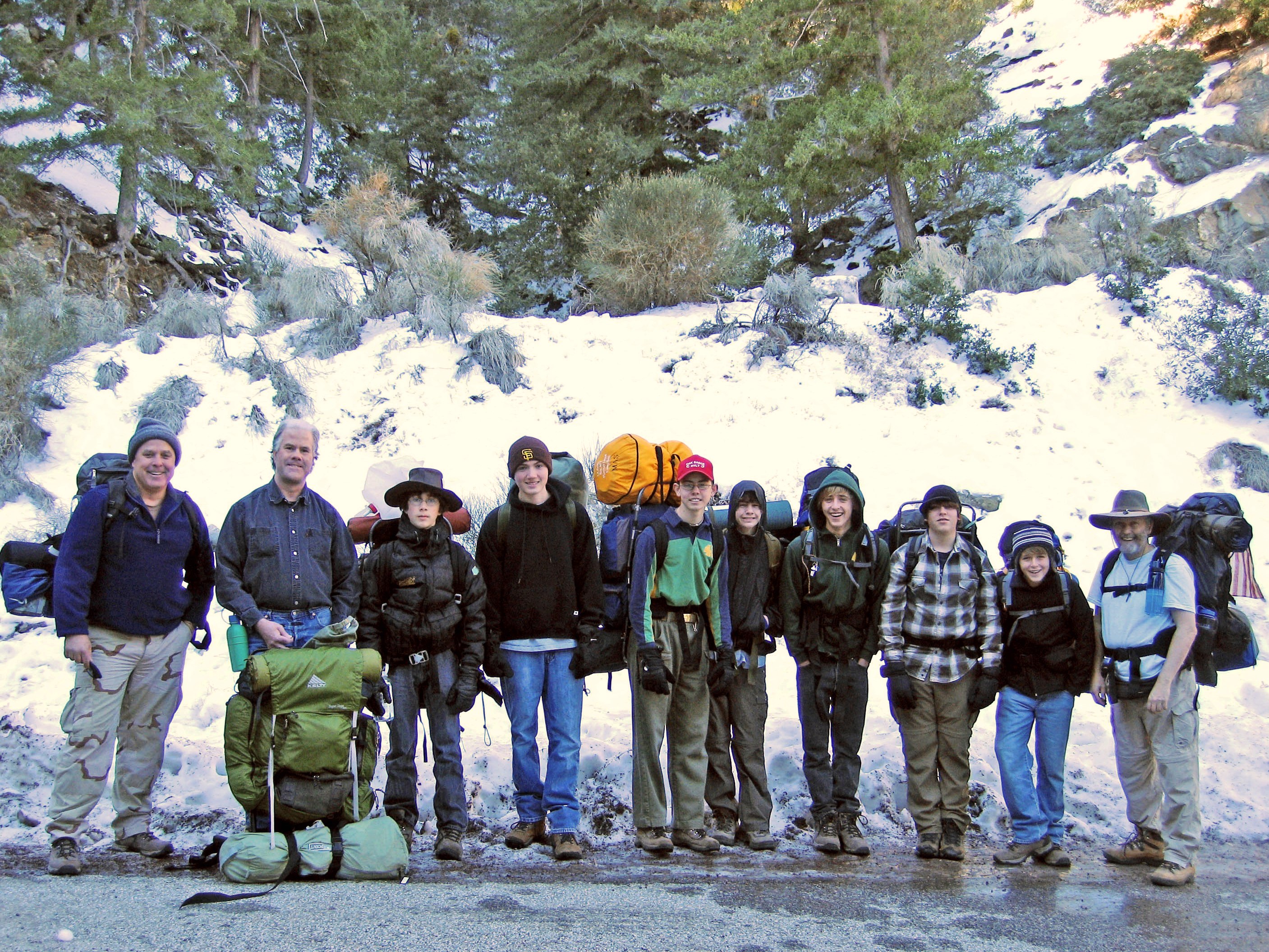
l-r: Mr. Roger Wallace, Mr. Donald Cole, Donny Cole, Kevin O'Toole, Matthew Susank, Kevin Kussro, Adam Wallace, Adam de Lucia, Ryan Wallace, Mr. Richard Key Dec. 29-30, 2008 We were dropped off at the trailhead, on Mt. Wilson Rd. a half-mile up from Red Box. We were unable to find the trail because it was covered in snow from recent snowfalls, so we instead hiked beside the fire road. The icy conditions made it difficult to get a good footing so our progress was slow. One scout suffered a concussion and black eye when he slipped and hit a rock. We called his parents and arranged to meet them on Mt. Wilson Rd. at the Mt. Lowe turnout. After 3 miles we reached the abandoned Nike missile site on top of Mt. Disappointment (5,963'), where we ate lunch and the scouts had a snowball fight. Shortly after, we made a wrong turn on the snow-covered trail and wound up on top of San Gabriel Peak (6,161'). We turned around, descended, and eventually found the right trail to get us to Markham Saddle, where a couple of us escorted the injured scout down the fire road to his parents waiting on Mt. Wilson Rd. From Markham Saddle it was a 2-mile descent to Mt. Lowe trail camp (4,418'), where there was little snow, a letdown since we had looked forward to snow camping. Our total distance for the day was 7 miles, 6 of them in snow. The next morning we awoke to much warmer temperatures, and after a breakfast of eggs, bacon and French toast, we hiked a half-mile to Inspiration Point, where we had a view of the Los Angeles basin out to the Pacific. We then hiked 2 miles down Castle Canyon trail to Echo Mountain, and 3 miles down the Sam Merrill trail to the top of Lake St. in Altadena, where we were picked up. The trip was organized by Mr. Key. |
Philmont 2007 |
|---|
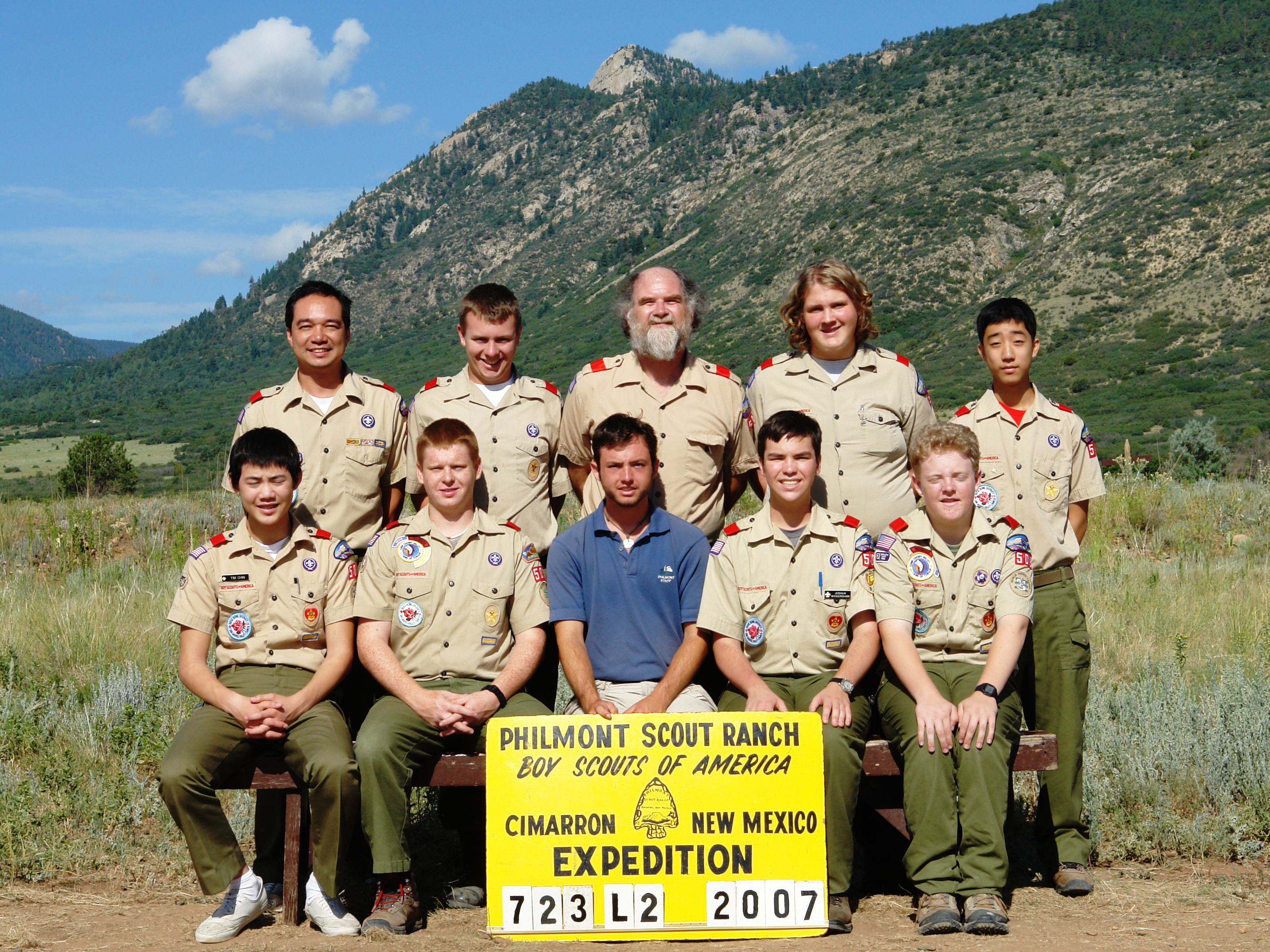
front l-r: Timothy Chin, Chase Chavarria, ranger, Joshua Wickersham, crew leader Kevin Kraft back l-r: Mr. Greg Chin, Brad Blackmon, lead advisor Mr. Ken Chafin, Chris Chafin, Paul Lee Jul. 23-Aug. 4, 2007 We flew to Albuquerque and took a charter bus to Philmont. We hiked itinerary no. 22, which totaled 73 miles over 11 days and was a clockwise loop through Philmont's south and central countries, ending by hiking into base camp via Tooth of Time. A Philmont bus took us to our trailhead at the Lovers Leap turnaround. Our ranger stayed with us the first two days on the trail. Our campsites were Lovers Leap, Crater Lake, Black Mountain, Lookout Meadow, Buck Creek, Mt. Phillips, Upper Sawmill, Cimarroncito (2 nights) and Tooth Ridge. We picked up food in Miners Park, Phillips Junction and Ute Gulch. We summited Mt. Phillips (11,650') and Tooth of Time. Our activities included rock climbing, spar pole climbing, rifle shooting, black powder rifle, blacksmithing, fly tying, campfires and chuckwagon dinner. Our conservation project was at Hunting Lodge. The trip was organized by Mr. Chafin. |
Golden Trout Wilderness 2006 |
|---|
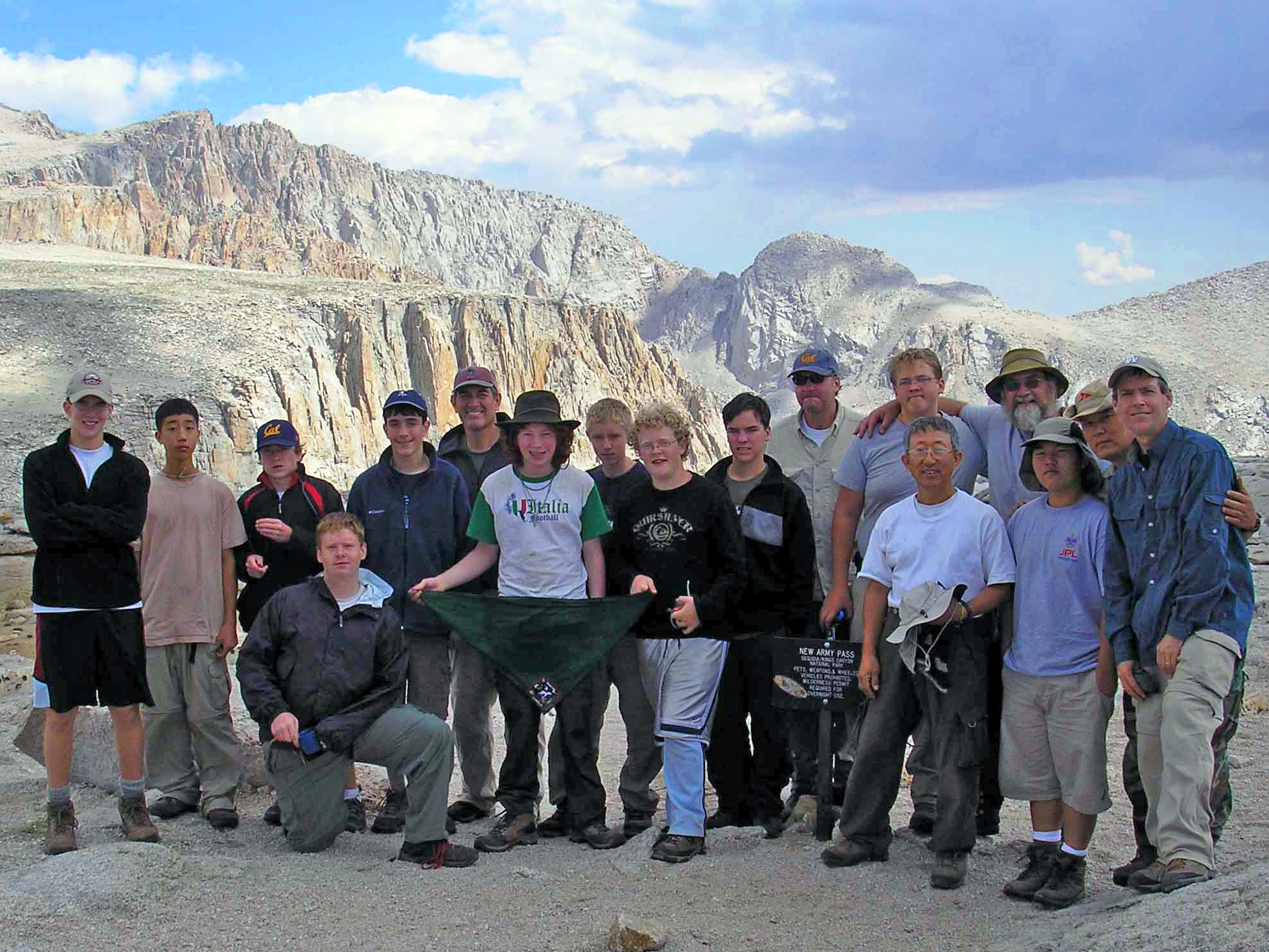
l-r: Erik Shaw, Paul Lee, Kevin Hoffman, Chase Chavarria, Sean Stathatos, Mr. Steve Stathatos, Bo Sagal, David Bliss, Kevin Kraft, Joshua Wickersham, Mr. David Sagal, Chris Chafin, Mr. Chang Lee, Mr. Ken Chafin, Eric Yun, Mr. Yong Kyu Yun, Mr. Scott Kraft Aug. 2006 This 33-mile hike in the Golden Trout Wilderness of the Eastern Sierra was a counterclockwise loop from Horseshoe Meadow over New Army Pass and then back via Siberian and Cottonwood passes. We drove four hours, 230 miles, to Horseshoe Meadow campground (9,940') and spent the night. The next day we hiked 6.5 miles and camped at Long Lake. The third day we hiked 4.5 miles over New Army Pass (12,300') and camped at Lower Soldier Lake. The fourth day we hiked 6 miles and camped at Lower Rock Creek Crossing (9,640'). The fifth day we hiked 7 miles over Siberian Pass (10,990') and camped at Big Whitney Meadow. The sixth day we hiked 4 miles and camped at Chicken Spring Lake. The seventh day we hiked 5 miles over Cottonwood Pass (11,140') and back to Horseshoe Meadow, then drove home. We had good success fishing for golden trout, which is the state fish and native only to this area. The La Canada Valley Sun wrote about the trip HERE. The trip was organized by Mr. Sagal. |
Philmont 2004 |
|---|
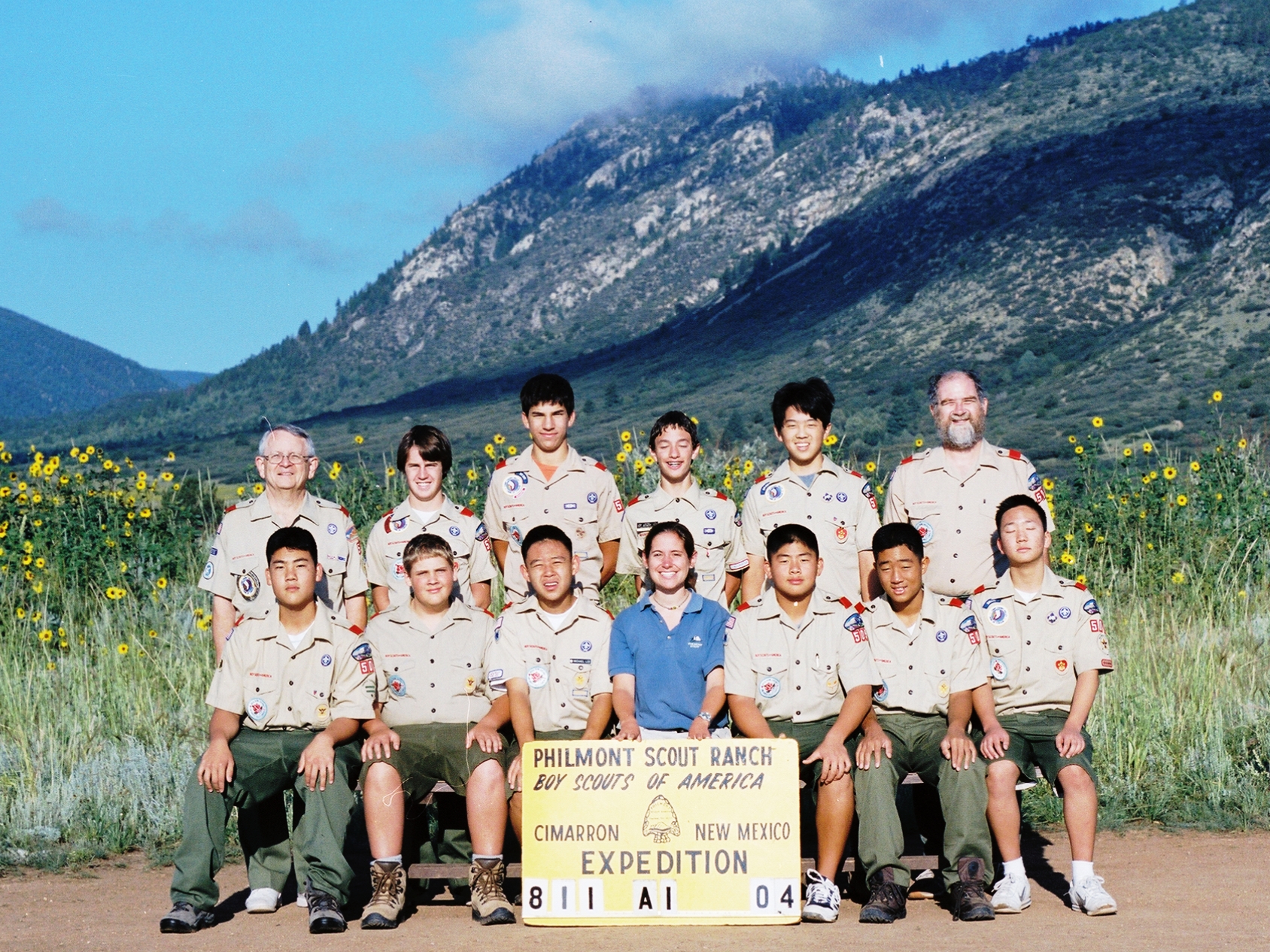
front l-r: William Kim, Chris Chafin, Michael Lee, ranger Angela, Daniel Lee, Paul Chung, John Choi back l-r: Mr. Ken Broomfield, Charles Crandon, Alex Harstrick, crew leader Alon Atkins, Luke Rhee, lead advisor Mr. Ken Chafin 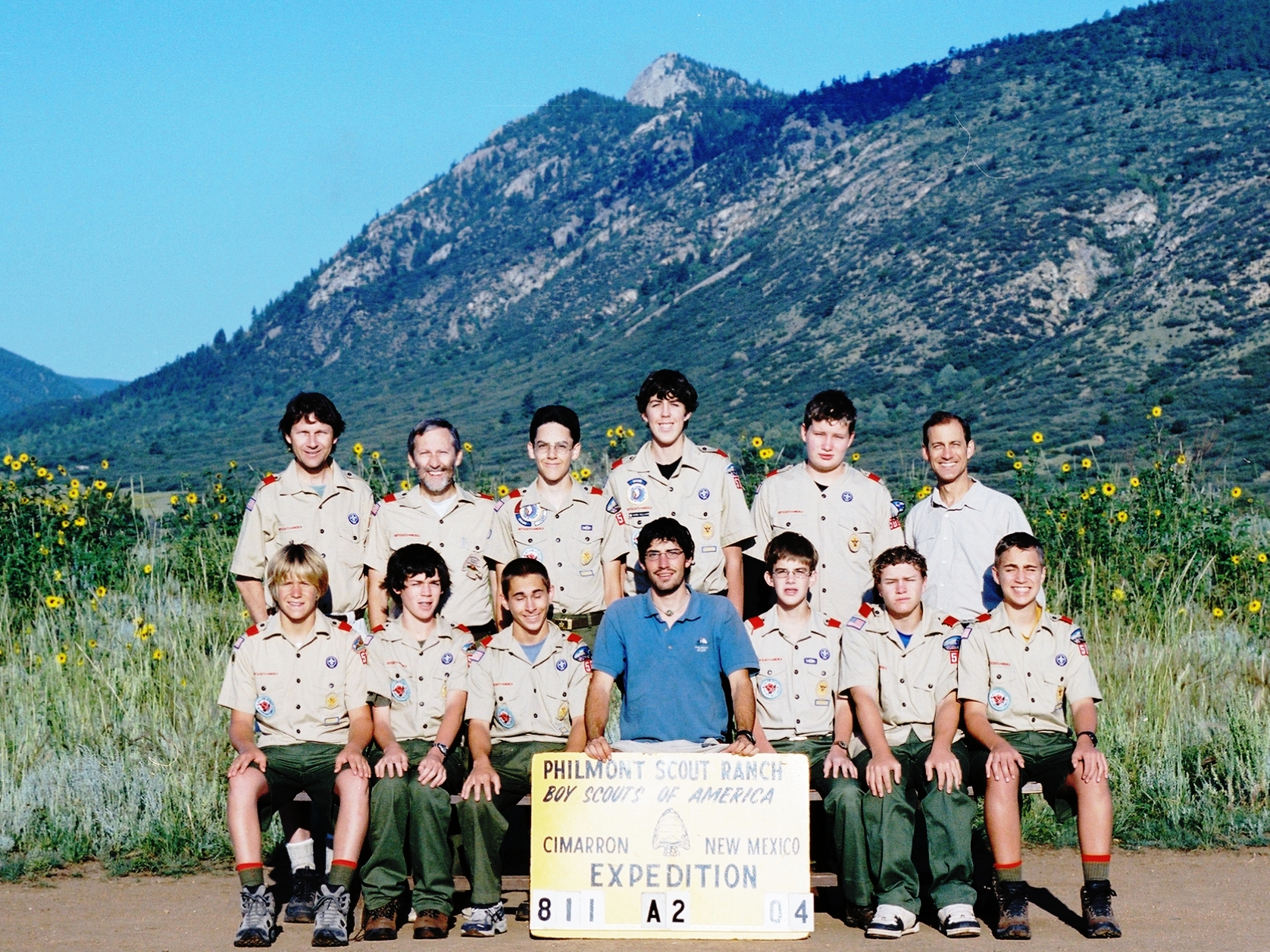
front l-r: Evan Edwards, Philip Hall-Partyka, Keith Male, ranger Mike Byrum, Erik Shaw, Stephen Volk, Matt Upton back l-r: Mr. Randy Hall, lead advisor Mr. Richard Key, crew leader Evan Key, Chris Sullivan, Lucas Struycken, Mr. Mike Upton Aug. 11-20, 2004 We flew to Albuquerque and took a charter bus to Philmont. Both crews hiked the same itinerary, totaling 50+ miles over 8 days in a clockwise loop through Philmont's south country, ending by hiking into base camp via Tooth of Time. A Philmont bus took us to our trailhead at the Lovers Leap turnaround. Our ranger stayed with us the first two days on the trail. Our campsites were Lovers Leap, Urraca, Abreu, Fish Camp, Beaubien, Black Mountain and Shaefers Pass. We picked up food in Phillips Junction. We summited Tooth of Time (9,003'), and one day hiked an extra 6 miles because we missed a switchback and followed a deer trail until we found ourselves at a cliff. Our activities included rock climbing, black powder rifle, blacksmithing, fly tying, challenge events, goat milking, chicken racing, branding, plane crash wreckage, cantina, Mexican dinner and chuckwagon dinner. Our conservation project was clearing the forest for a new trail on Bonito Peak, which we had to hike to twice because we arrived late the first time. We toured the Kit Carson Museum and Villa Philmonte. The trip was organized by Mr. Chafin. |
Mt. Whitney 2004 |
|---|

l-r: Mr. Richard Key, Keith Male, Charles Crandon, Sam Wegner, Mattieu Beyssat, Daryl Key, Mr. Russ Sugimura, Evan Key, Matt Upton, Mr. Mike Upton Jul. 16-18, 2004 7 scouts and 3 adults made it to the summit of Mt. Whitney (14,508'). Fri. afternoon we drove four hours, 230 miles, and spent the night at Horseshoe Meadow campground (10,000'). On Sat. we planned to fish for golden trout in the Cottonwood Lakes but it was raining hard, so we drove down to Lone Pine where it was dry and picked up our trail permit, did some practice hiking, and ate an early high-energy dinner of buffalo burgers. We returned to Horseshoe Meadow campground for a second night, but this time with an early bedtime. We awoke Sun. at 1 am and drove to the trailhead at Whitney Portal (8,375'). We started hiking on the Mt. Whitney Trail at 3 am using headlamps. We hiked the 11 miles to the summit in 9 hours, arriving at noon. The last few miles were over snow-covered rocks, and on the summit it was 39 degrees. We ate lunch, it started to snow, and we headed back down the mountain, arriving at Whitney Portal at 7:30 pm. We then drove four hours back to La Canada. One scout, Erik Shaw, experienced altitude sickness and at Trail Crest (13,645') he and his dad, Bill, turned back. One of the scouts who summited, Mattieu Beyssat, was a French exchange student living with the Key family. The trip was organized by Mr. Key. |
San Bernardino Peak 2004 |
|---|
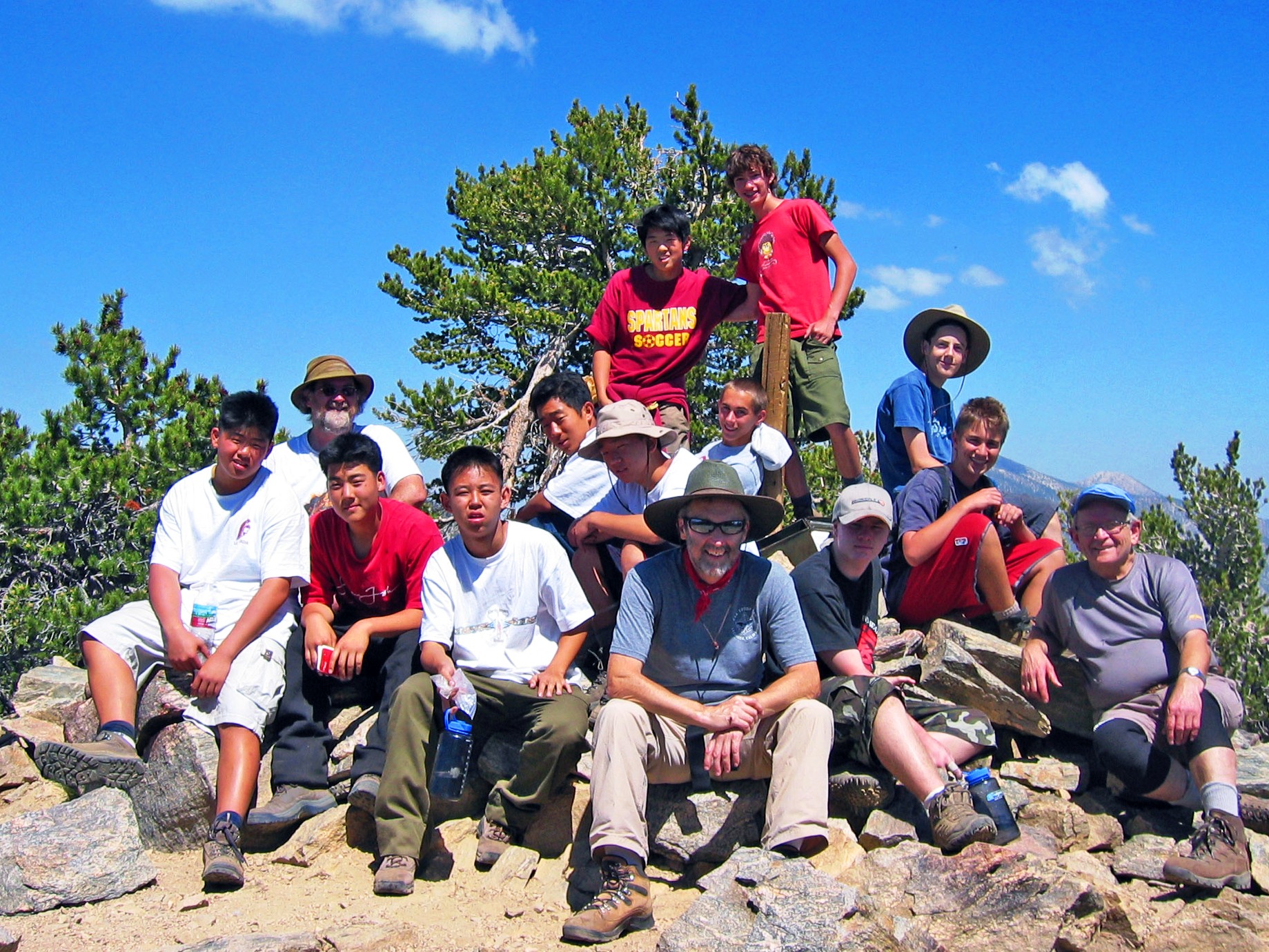
front l-r: Daniel Lee, William Kim, Michael Lee, Mr. Richard Key, Stephen Volk, Mr. Ken Broomfield middle l-r: Mr. Ken Chafin, Paul Chung, John Choi, Keith Male, Matt Upton back l-r: Josh Rhee, Alon Atkins, Evan Key not shown: Chris Chafin Jun. 18-20, 2004 The trail to the summit of San Bernardino Peak (10,649') is steady uphill for 8 miles with an elevation gain of 4,700'. We drove 90 miles to the trailhead in Angelus Oaks, which is east of Redlands on CA-38. The first day we hiked 5 miles to Columbine Camp and spent the night. The next day we hiked 2 miles to Limber Pine Camp, set up camp and filtered water from a spring, then hiked with daypacks 1 mile to the summit and returned to Limber Pine Camp. The third day we hiked 6 miles back to the trailhead and drove home. The trip was organized by Mr. Key. |
Klondike Chilkoot Trail 2003 |
|---|
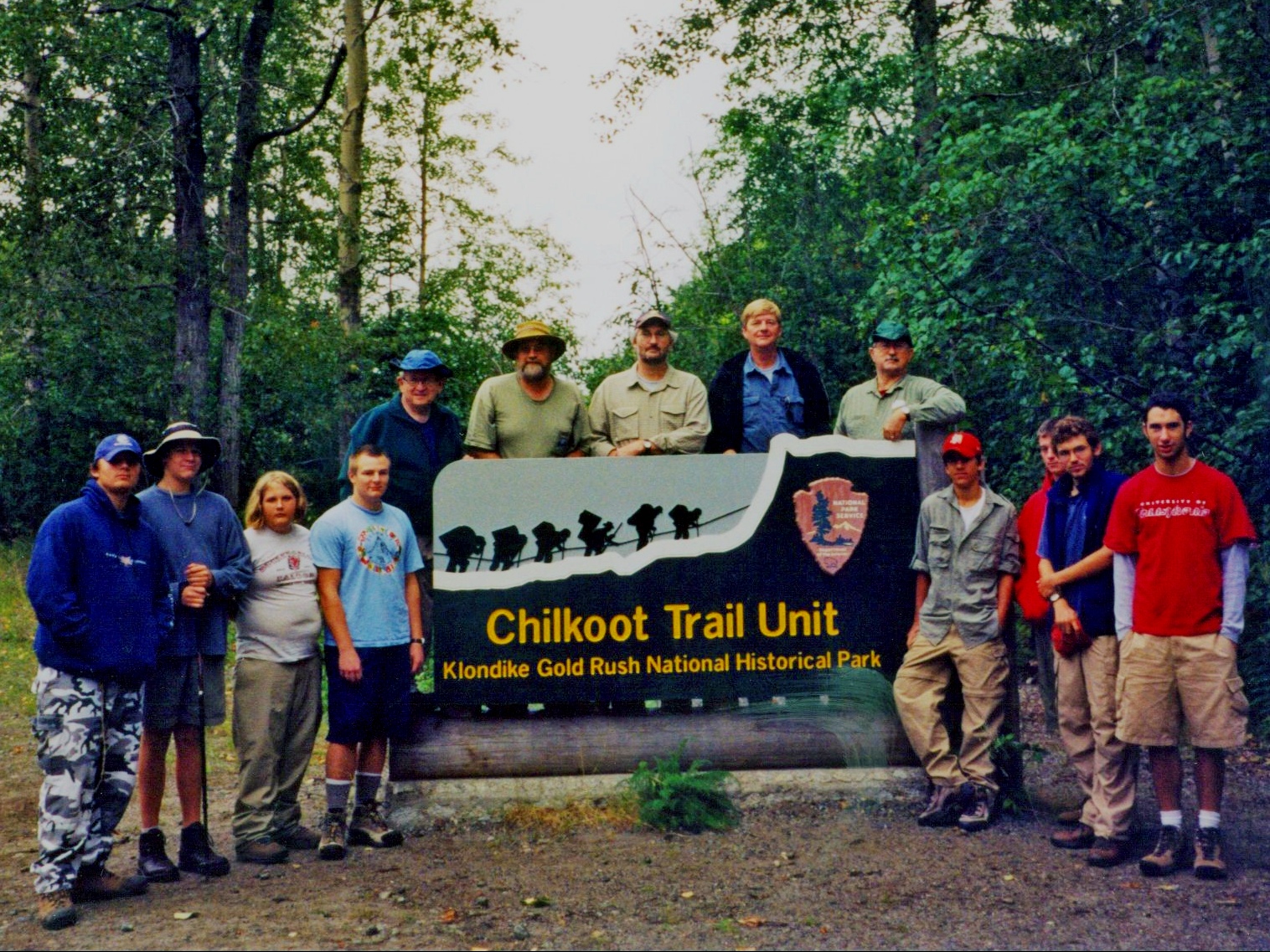
l-r: Nick Harstrick, Gates Winkler, Chris Chafin, Sven Haukkson, Mr. Ken Broomfield, Mr. Ken Chafin, Mr. Jay Winkler, Mr. Michael Harstrick, Mr. Ernie Messner, Alex Harstrick, David Messner, Brady Blasco, Daniel Fishman Aug. 13-19, 2003 We hiked the 33-mile Chilkoot Trail, which goes from Dyea, Alaska, to the headwaters of the Yukon River at Lake Bennett, British Columbia. During the Klondike Gold Rush this was the most popular route to the Yukon. The trail starts in coastal forest, transitions to high alpine, and ends in boreal forest. We flew from Burbank to Juneau, took a ferry 100 miles through the Inside Passage to Skagway, then rode vans 9 miles to Dyea. That first night we camped near the trailhead at the Dyea campground. The second day we hiked 7.5 miles in the rain to Canyon City campground and explored the nearby ruins of the abandoned gold rush town. The third day it was again raining, and we hiked 4.3 miles to Sheep Camp and prepared ourselves for the following day, which was going to be our most challenging. On day four we hiked 8.7 miles with an elevation gain of 2,500' up and over Chilkoot Pass, to Happy Camp, through rain, sleet, wind and fog. The ascent to the pass, starting at Scales, was an icy 30-degree slope that ended with a steep field of boulders called Golden Stairs. Chilkoot Pass is the boundary between the U.S. and Canada. The descent from the pass was equally steep, then we crossed a snow field and traversed the sheer side of Crater Lake. Happy Camp often has severe weather and the name is sarcastic, with a sign in the warming shelter saying, "Happy Camp - where happiness goes to die!" The fifth day, finally dry, we hiked 5.5 miles to Lindeman City campground and held a polar bear swim competition in Lindeman Lake. On day six we hiked 7 miles to the end of the trail at Bennett. The day after we started, the Chilkoot Trail was closed at Dyea for three days due to the rain, flooding and forecasted more rain. We had brought with us plenty of fire starter, which made us a big hit with other backpackers due to our ability to make a fire with wet wood. On day seven we took the train from Bennett back to Skagway, and a charter plane back to Juneau, and flew back to Burbank. The trip was organized by Mr. Broomfield. |
San Gabriel Mountains Traverse 2003 |
|---|

l-r: Brady Blasco, James Blanton, Daryl Key, Keith Male, Steven Volk, Philip Hall-Partyka, Evan Key, Lucas Struycken, Timothy Chin, Mr. Tom Blanton not shown: Chris Chafin, Mr. Ken Chafin, Mr. Richard Key Jul. 19-20, 2003 We crossed the middle of the San Gabriel Mountains going from north to south. Our trailhead was Vincent Gap (6,593'), about 50 miles up Angeles Crest Highway, near Wrightwood. Our plan for the first day. was to follow Vincent Gulch to the Upper East Fork of the San Gabriel River and spend the night at Fish Fork trail camp, a distance of 8 miles. We knew we would be getting wet so we each had two pairs of footwear: hiking boots for land, and water sandals for water. After the first half-mile on rock-strewn dry riverbed, we started hiking in the river with our water sandals as there was no trail. Our progress was slow, the rocks were slippery and it was tiring. Due to our slow pace, a late start, and a little too much playing in the water, we made only 7 miles that day and ended up camping on a ridge above the river, without a fire ring or flat clearings for our tents. The next morning we got an early start and continued hiking in the river, including through the Narrows, the deepest gorge in Southern California, where at one point the east wall soars nearly a mile straight up Iron Mountain. We switched to our hiking boots shortly before crossing the "Bridge to Nowhere" (built in 1936 but the road washed away two years later and was never rebuilt), but soon after switched back to our water sandals and wore them until the end of our hike, at the East Fork trailhead (2,028') at the terminus of East Fork Rd. above Azusa. We had hiked a total of 15 miles, nearly all of them in water. The trip was organized by Mr. Key. |
Jennie Lakes Wilderness 2003 |
|---|
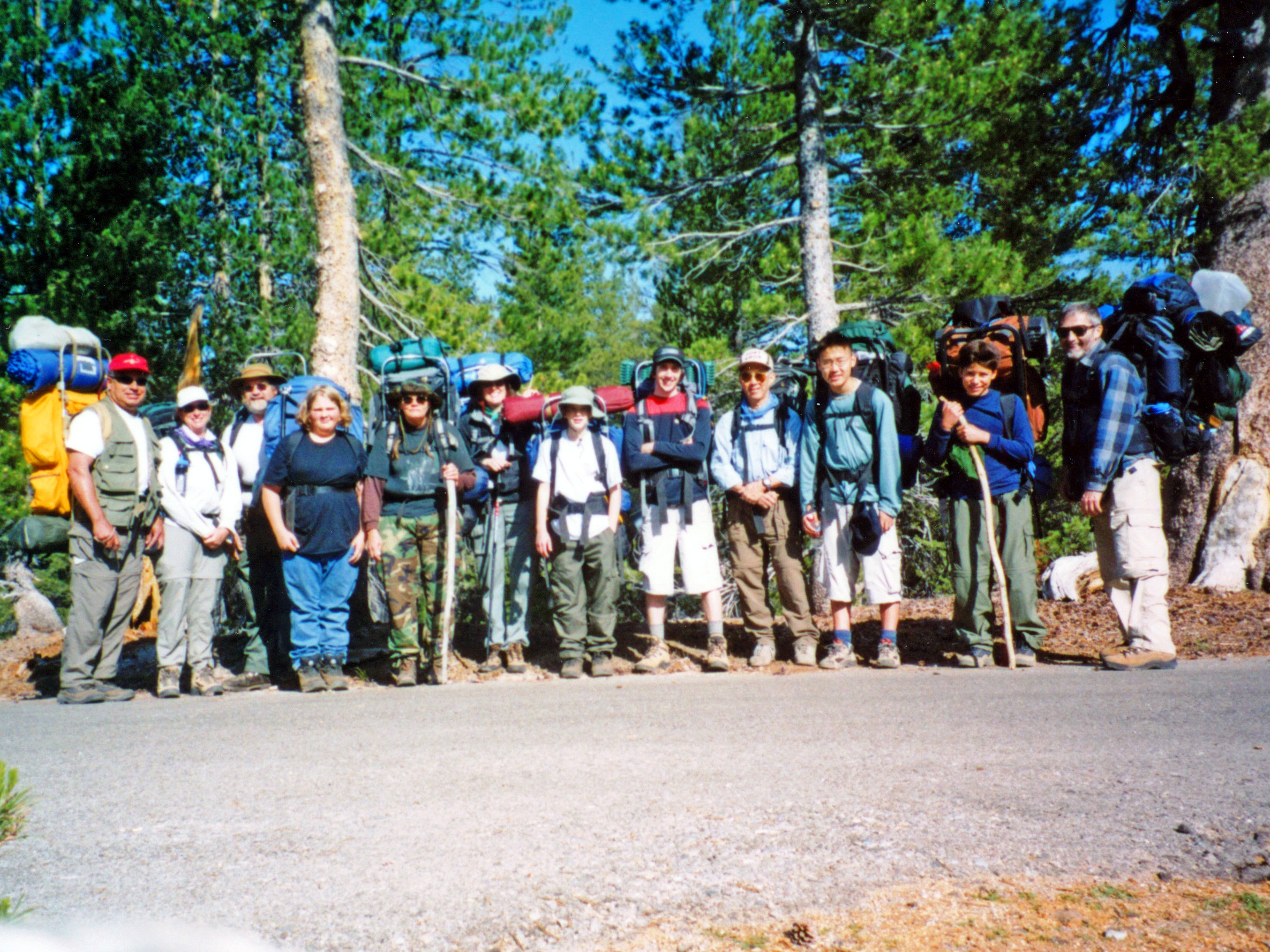
l-r: Mr. Daniel Winterhalter, Mrs. Muriel Winterhalter, Mr. Ken Chafin, Chris Chafin, Mrs. Kim Chafin, Dr. Ileana Shaw, Erik Shaw, Daryl Key, Mr. Russ Sugimura, Andy Choi, Tristan Winterhalter, Mr. Richard Key Jun. 19-22, 2003 Jennie Lakes Wilderness in Sequoia National Forest is a mixture of lakes, meadows and streams in forests of fir and pine. We drove up CA-99 to Visalia, then took CA-198 through Sequoia National Park on our way to Big Meadows campground (7,600'), a total of 5 hours, 250 miles. The next morning we started by fording knee-deep Big Meadows Creek, then hiked through Fox Meadow and Poison Meadow and crossed Stony Creek. We climbed the flanks of Shell Mountain, with a view of Kaweah Divide, and climbed to Poop Out Pass (9,170'). We then descended to Jennie Lake (9,000'), where we spent the night after having hiked 7 miles that day. The next day our goal was Weaver Lake. We first climbed five switchbacks up to Jo Pass (9,410'), with a great view of Mt. Silliman. We then followed the Weaver Lake Trail, which dropped precipitously into Boulder Creek Canyon, where we forded Boulder Creek several times. After climbing Shell Mountain we arrived at Weaver Lake (8,707') shortly before nightfall, a total of 8 miles that day. The fishing at Weaver Lake was good, with several of us eating rainbow trout for dinner. The next morning we hiked 4 miles back across Fox Meadow and forded Big Meadows Creek to return to our cars, having hiked 19 miles over three days. The trip was organized by Mr. Key. |
Philmont 2002 |
|---|
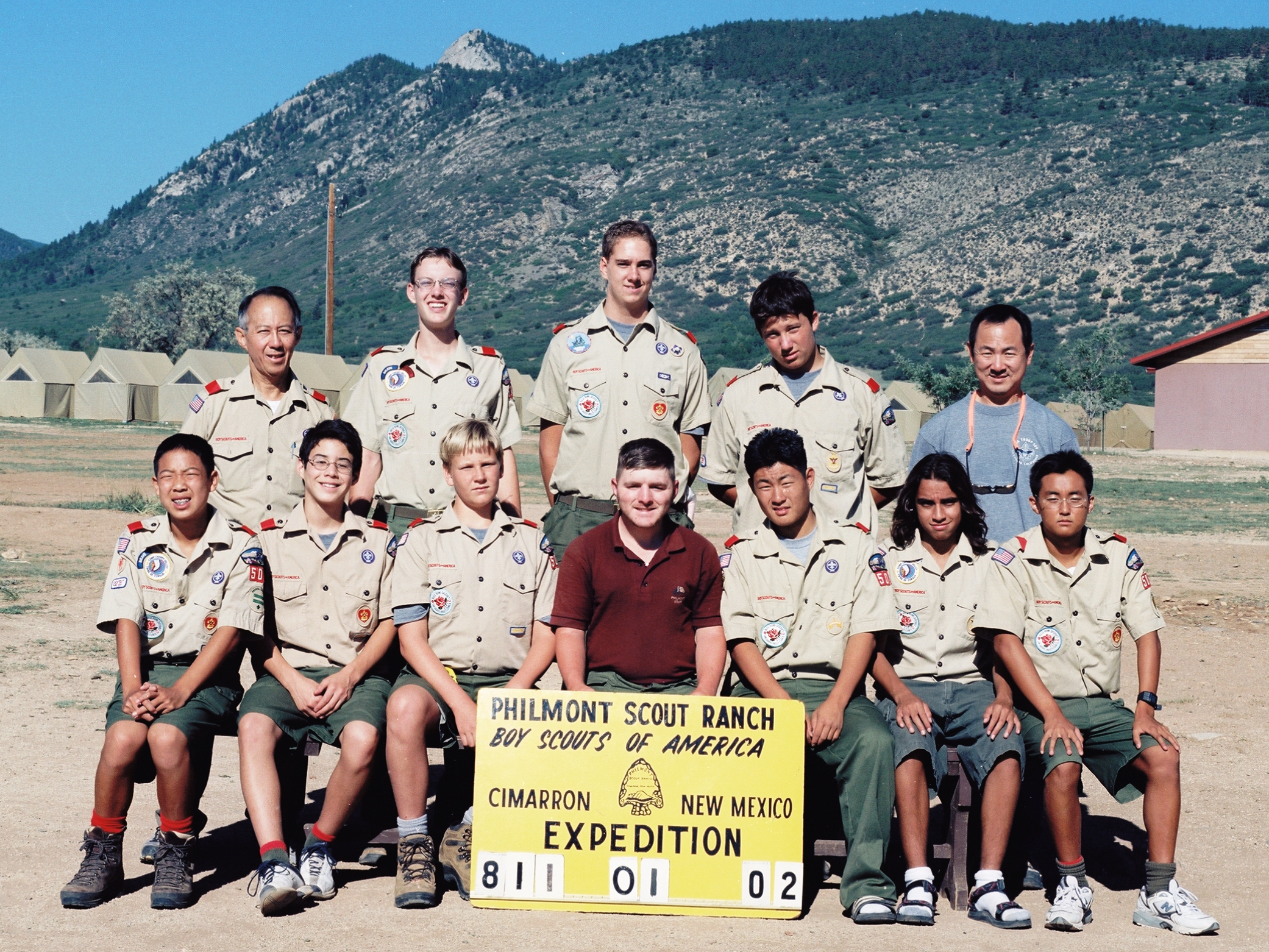
front l-r: Jeff Pih, Kenny Sugimura, Gates Winkler, ranger Travis, Douglas An, Michael Brady, Thomas Lee back l-r: lead advisor Mr. Russ Sugimura, Brett Shaw, crew leader Sam Wegner, Nick Harstrick, Mr. Will Pih 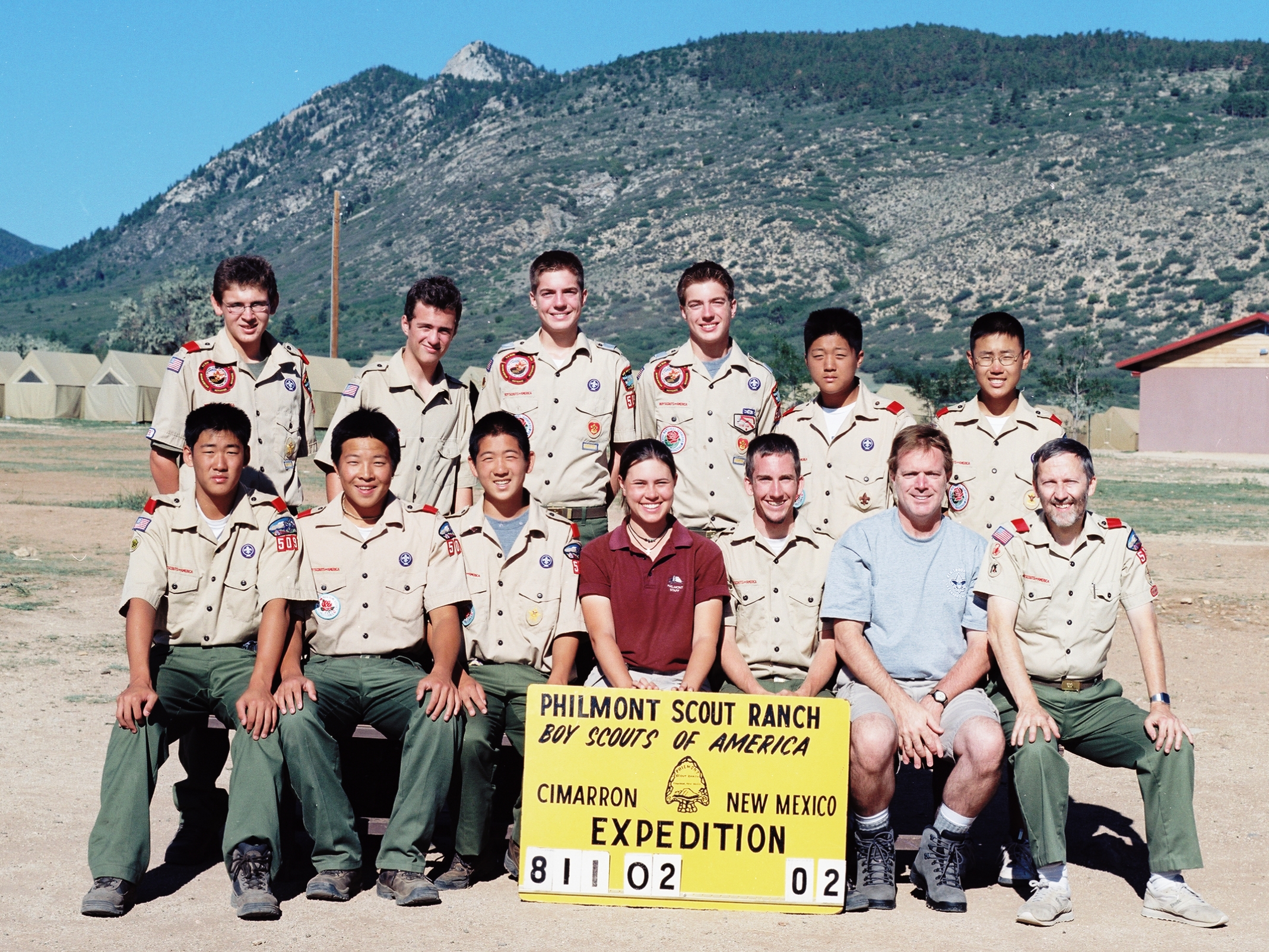
front l-r: David Song, David Kwon, Josh Rhee, ranger Emily Smith, crew leader Daryl Key, Dr. Martin O'Toole, lead advisor Mr. Richard Key back l-r: Brady Blasco, Chaz Sosa, Adam O'Toole, Brian O'Toole, Justin Yun, Andrew Choi Aug. 11-20, 2002 We flew to Albuquerque and took a charter bus to Philmont. Both crews hiked the same itinerary, totaling 50+ miles over 8 days in a counterclockwise loop through Philmont's south country. A Philmont bus took us to our trailhead at the Zastrow turnaround and later picked us up there. Our ranger stayed with us the first two days on the trail. Our campsites were Rayado River, Uracca, Miners Park, Black Mountain, Beaubien, Agua Fria, Crags and Zastrow. We picked up food in Phillips Junction. We summited Black Mountain (10,889'), and when we left our pots at Beaubien some of the scouts went back 6 miles to retrieve them. Our activities included rock climbing, black powder rifle, fly tying, challenge events, horseback riding, mountain biking, archery with 3-D targets, plane crash wreckage, branding, campfire and chuckwagon dinner. Our conservation project was at Fish Camp. We toured the Kit Carson Museum and Villa Philmonte. The trip was organized by Mr. Ken Broomfield, who at the last minute was unable to go. |
Mt. Whitney 2002 |
|---|

front l-r: Michael Collins, Daryl Key back l-r: Mr. Richard Key, Alex Harstrick, Nick Harstrick, Mr. Jay Winkler, Gates Winkler, Jeff Pih, Mr. Michael Harstrick, Andrew Choi, Mr. Will Pih, Brett Shaw, Mr. Bill Shaw Jul. 19-21, 2002 All 8 scouts and 5 adults made it to the summit of Mt. Whitney (14,508'). Fri. afternoon we drove four hours, 230 miles, and spent the night at Horseshoe Meadow campground (10,000'). Sat. morning we moved our camp to Whitney Portal (8,375') and did some fishing and hiking, then mid-afternoon drove down to Lone Pine and picked up our trail permit and ate a high-energy dinner of buffalo burgers. We returned to Whitney Portal and went to bed at dusk. After a few hours of sleep we awoke Sun. at 2 am and shortly after 3 am started hiking on the Mt. Whitney Trail using headlamps. We hiked the 11 miles to the summit, arriving shortly before noon, took photos and ate lunch, then hiked 11 miles back to Whitney Portal, arriving at 8 pm. We saw a shooting star, we crossed a snowfield near the summit, and at the summit it was 43 degrees and sunny with no wind. We got back to La Canada around midnight. The trip was organized by Mr. Key. |
Havasupai 2001 |
|---|

l-r: Dr. Ileana Shaw, Mr. Sung Choi, Peter Blanton, Jeff Pih, Brett Shaw, David Kwon, Erik Shaw, Daryl Key, Daniel Lee, Mr. Bill Shaw, Chris Toon, Michael Lee, Justin Yun, John Choi, Doug An, Greg Wannier, Kenny Sugimura, Keith Sugimura, Josh Rhee, William Kim, Mr. Geoff Toon, Evan Key, Luke Rhee, Mr. Chang Lee, Mr. Ken Broomfield not shown: Mrs. Shirley Chung, Mr. Richard Key, Mrs. Leasa Sugimura, Mr. Russ Sugimura April 8-13, 2001 On Sun. we drove eight hours, 435 miles, to Hualupai Hilltop on the rim of the Grand Canyon and spent a cold, snowy night sleeping in the parking lot. On Mon. we hiked 8 miles down switchbacks to the floor of Hualupai Canyon and through that canyon to the Havasupai Tribe's village, Supai, then 2 more miles through Havasu Canyon to the campground, just below Havasu Falls. Some of us paid for mules to carry our gear to the campsite. On Tue., Wed. and Thu. we explored Havasu Creek and the many side canyons, we hiked to 196'-high Mooney Falls a mile away, we played volleyball and other games, and we swam and played in the travertine blue-green pools below Havasu and Mooney falls and their red rock walls. The tribe's chief also gave a talk to the troop. Reaching the bottom of Mooney Falls required a scary decent down a nearly vertical canyon wall through caves and steps carved into the rock. On Wed. a group of us attempted to hike the 16-mile round-trip down the canyon to the Colorado River, but only a few made it due to the difficulty of having to hike mostly in the water and overcoming the many small waterfalls and other obstacles. On Fri. we ate an early breakfast and at 7 am started the 10-mile hike back to our cars on the canyon rim, and then made the long drive home. The trip was organized by Mr. Key. |
Philmont 2000 |
|---|

front l-r: Andrew Stein, Michael Collins, ranger, David Chew, Kyle Kawakami back l-r: Mr. Ernie Messner, crew leader David Chafin, David Messner, lead advisor Mr. Ken Chafin 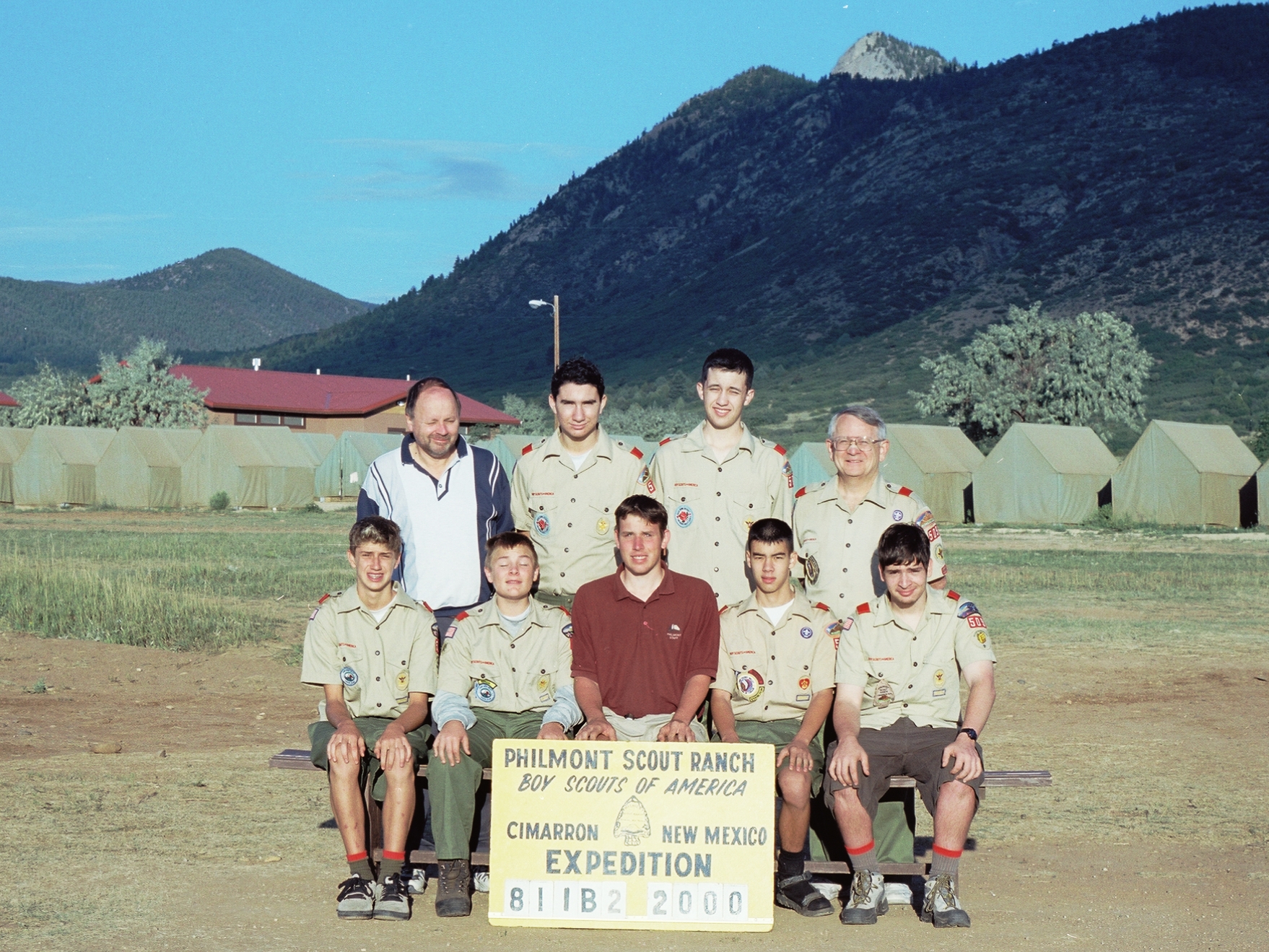
front l-r: Timothy Harker, Sven Hauksson, ranger, crew leader Wes Chew, Ian Meadows back l-r: Mr. Egill Hauksson, Daniel Fishman, Brian Sparks, lead advisor Mr. Ken Broomfield 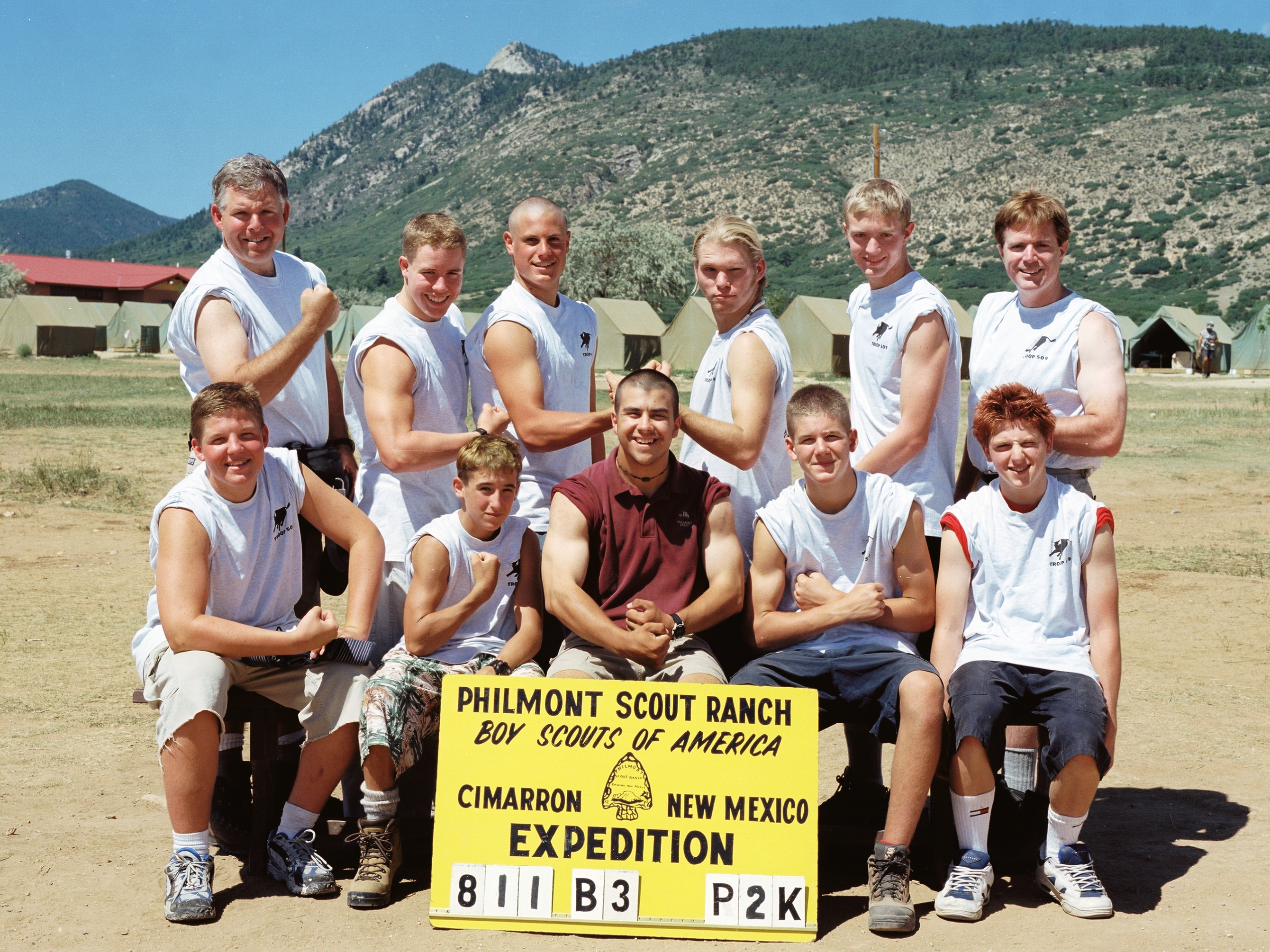
front l-r: crew leader Jonathan Caswell, Robby Whyte, ranger, Michael Caswell, Tyler Bockman back l-r: lead advisor Mr. Bill Caswell, Peter Blanton, Mark Essen, Hans Ludwig, Andrew O'Toole, Dr. Martin O'Toole Aug. 11-20, 2000 We flew to Albuquerque and took a charter bus to Philmont. The trip was organized by Mr Chafin. |
Buckhorn Snow Camping 2000 |
|---|
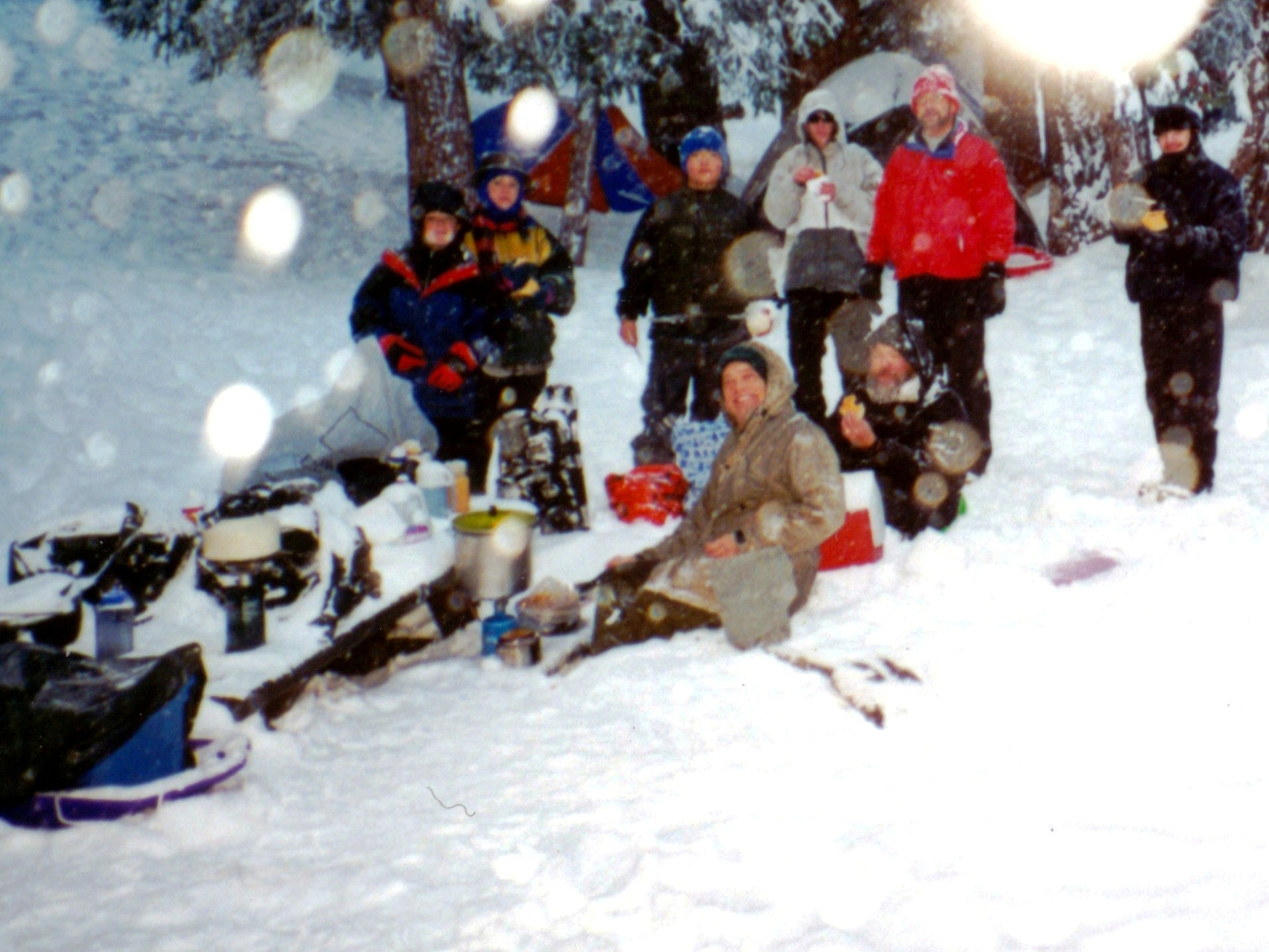
campers were Alon Atkins, Daryl Key, Evan Key, William Kim, Michael Lee, Sam MacKinney, Ian Meadows, Willy Morong, Eric Stone, Mr. Richard Key, Mr. Loren MacKinney, Mr. Paul Meadows, Mr. David Morong, Mr. Kris Smith, Mr. Henry Stone Feb. 12-13, 2000 Sat. morning we drove 35 miles up Angeles Crest Hwy. to Buckhorn campground (6,625'), not far from the Mt. Waterman ski lift. Road conditions required us to stop at Red Box to put chains on our tires. Snow was falling as we hiked the half-mile from the cars to the campground. We pulled two sleds loaded with firewood, a Dutch oven and a snow shovel. Snow covered everything, making it difficult to locate the campground, but we finally found a buried picnic table and dug it out enough to use for cooking. All day heavy snow fell. It was difficult to pitch our tents because as soon as something like a tent pole was laid on the ground, it was quickly covered by snow. Once tents were up, the scouts made a snow cave and went sledding. Dinner was beef stew in sourdough bowls, with a Dutch oven peach cobbler. We went to bed early, as soon as it got dark, to get out of the falling snow. Temperatures at night dropped to the single digits, and when we awoke Sun. it had stopped snowing but our camp was an icicle. We used hot water to free boots frozen to the ground. After a hot breakfast of oatmeal, we packed up and made our way back to the cars, with difficulty because of the deep snow. The road was icy and snow-covered, so the chains remained on until Red Box. The trip was organized by Mr. Key. |
Philmont 1998 |
|---|
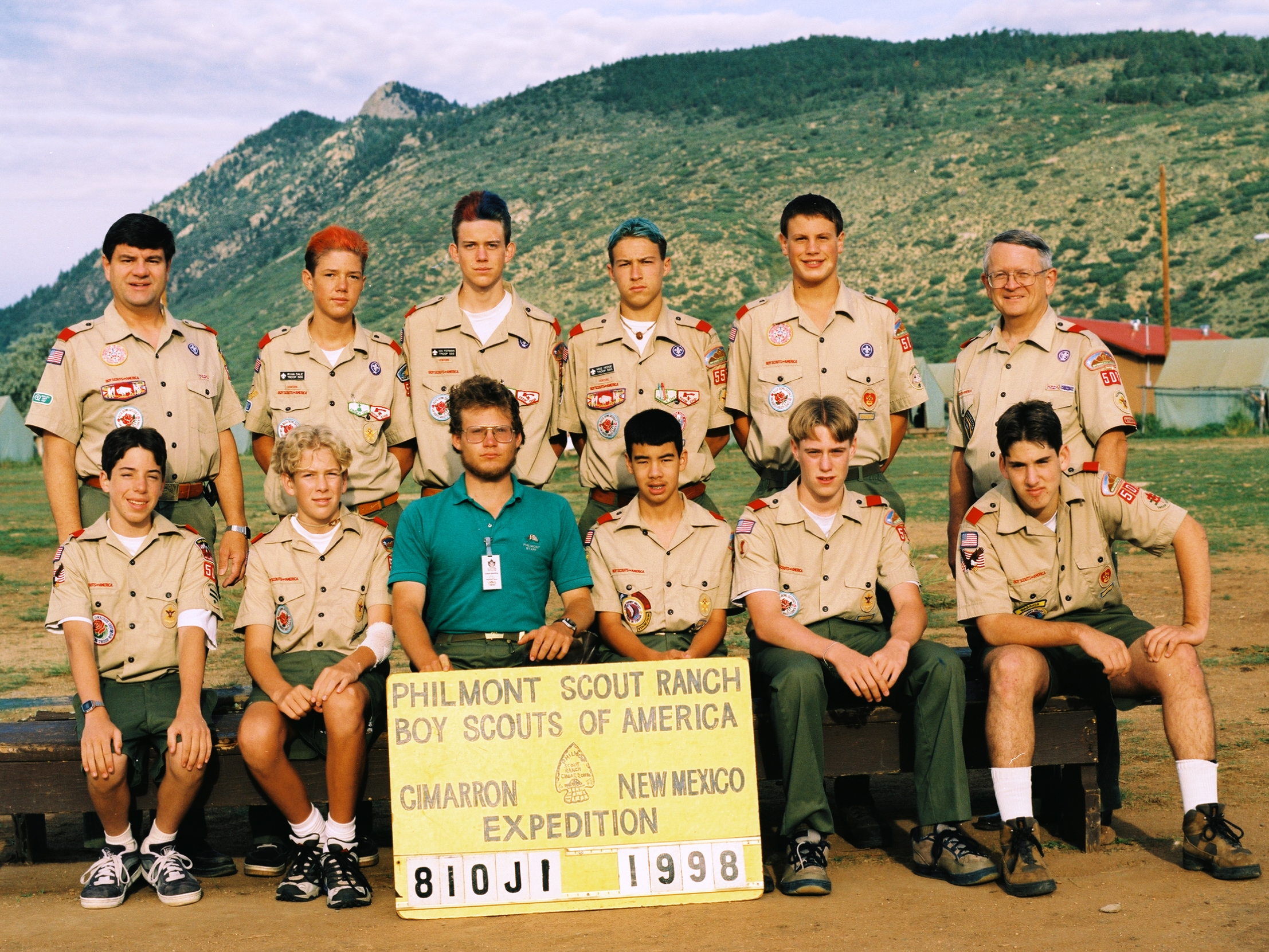
front l-r: Timothy Wannier, Jon Essen, ranger, Wes Chew, Patrick Rappleye, Paul Cohen back l-r: adult & 3 scouts from another troop, Daniel Braun, lead advisor Mr. Ken Broomfield 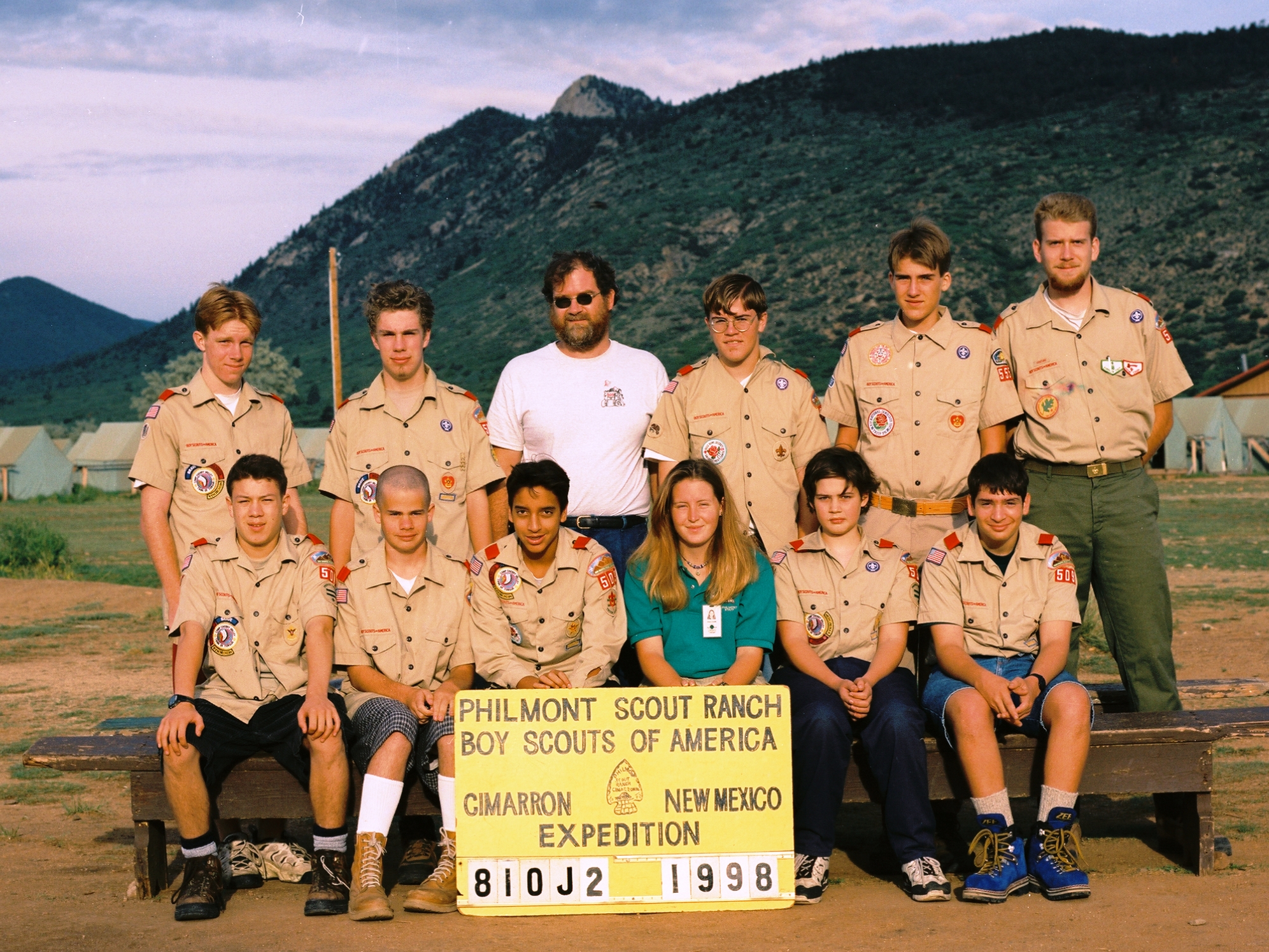
front l-r: Nathan Lam, ____, Daniel Brady, ranger, David Chafin, Ian Meadows back l-r: James Pickett, Andrew Smith, Mr. Ken Chafin, Brian Smith, scout & adult from another troop Aug. 10-21, 1998 The trip was organized by Mr. Broomfield. |
Philmont 1996 |
|---|
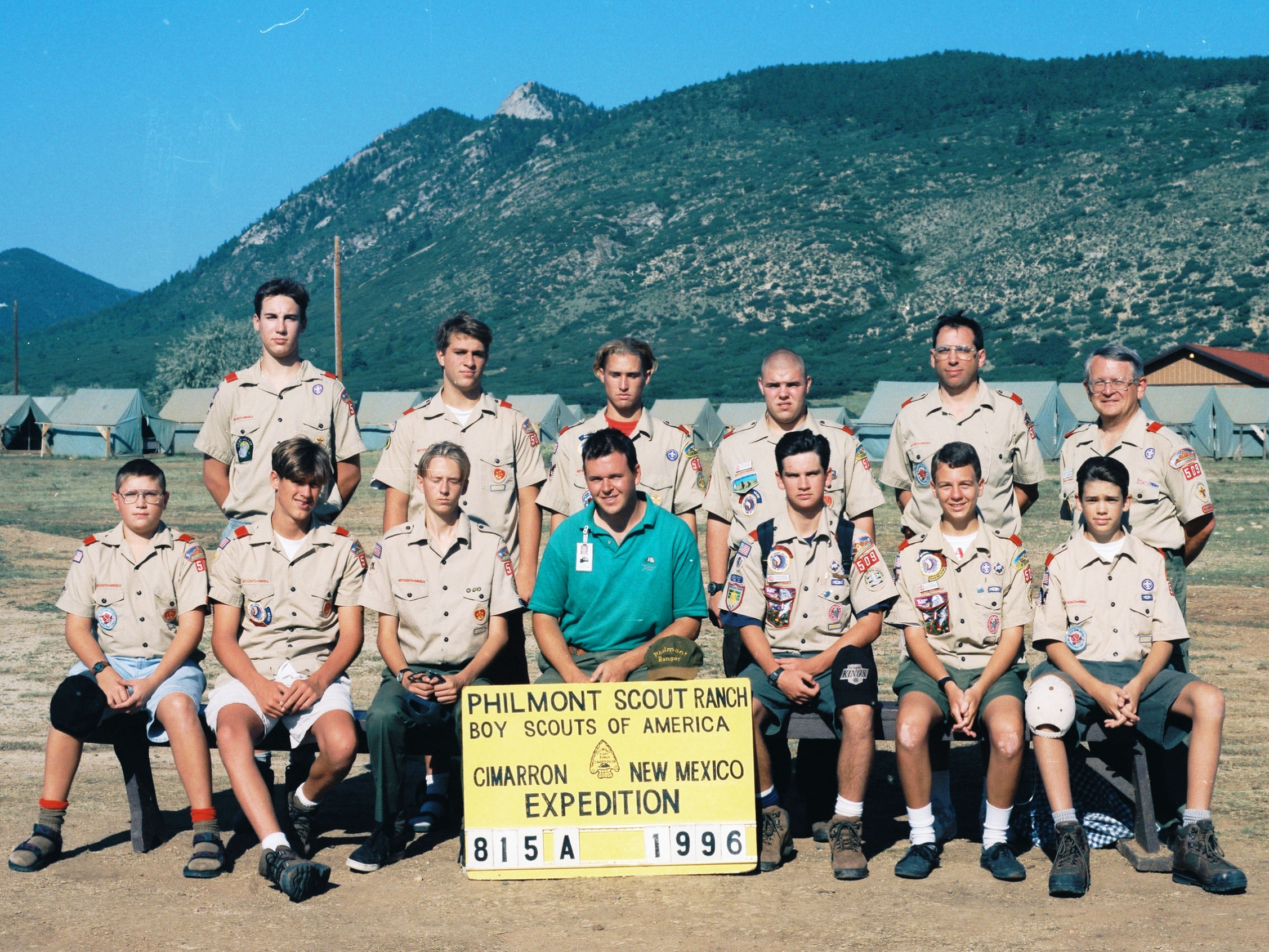
front l-r: Doug Shepherd, Tristan Nyby, Aaron Walizer, ranger Mike Bell (T509 alumnus), Jon Broomfield, J.J. Hintz, ____ back l-r: Austin Leach, Ben Bahrami, ____, Jon Shirley, Mr. Joe Shepherd, Mr. Ken Broomfield Aug. 15-22, 1996 |
Philmont 1991 |
|---|

front l-r: Brian Collins, Brandon Bailo, Ryan Levenick, Keith Miller middle l-r: David Tinkham, Mr. Terry Tinkham, Mr. Alan Harris, ranger, ranger, lead advisor Mr. John Wellman, lead advisor Mr. Andy Collins back l-r: Adam Bahrami, Ben Wellman, Darrell Tinkham, Chris Levenick, Donny Harris, Ryan Woods, David Harris, Mike Mandell Aug. 15-22, 1991 We flew to Albuquerque and took a charter bus to Philmont. Both crews hiked the same itinerary, totaling 40+ miles over 6 days in a clockwise loop through Philmont's south and central countries, ending by hiking into base camp via Tooth of Time. A Philmont bus took us to our trailhead at Zastrow turnaround. Our rangers (they called themselves rangerettes) stayed with us the first two days on the trail. Our campsites were Abreu, Fish Camp, Buck Creek, Clear Creek, Cyphers Mine and Clarks Fork. We picked up food in Phillips Junction. We summited Tooth of Time (9,003'). Our activities included blackpowder rifle shooting, blacksmithing, mine tour, fly tying, Stomp show, cantina, campfire, Mexican dinner and chuckwagon dinner. It rained most afternoons, making it a challenge to light a fire. On our second night we heard cat sounds (mountain lion?) throughout the night. A few scouts got the intestinal parasite Giardia. The trip was organized by Mr. Wellman. |
Philmont 1982 |
|---|
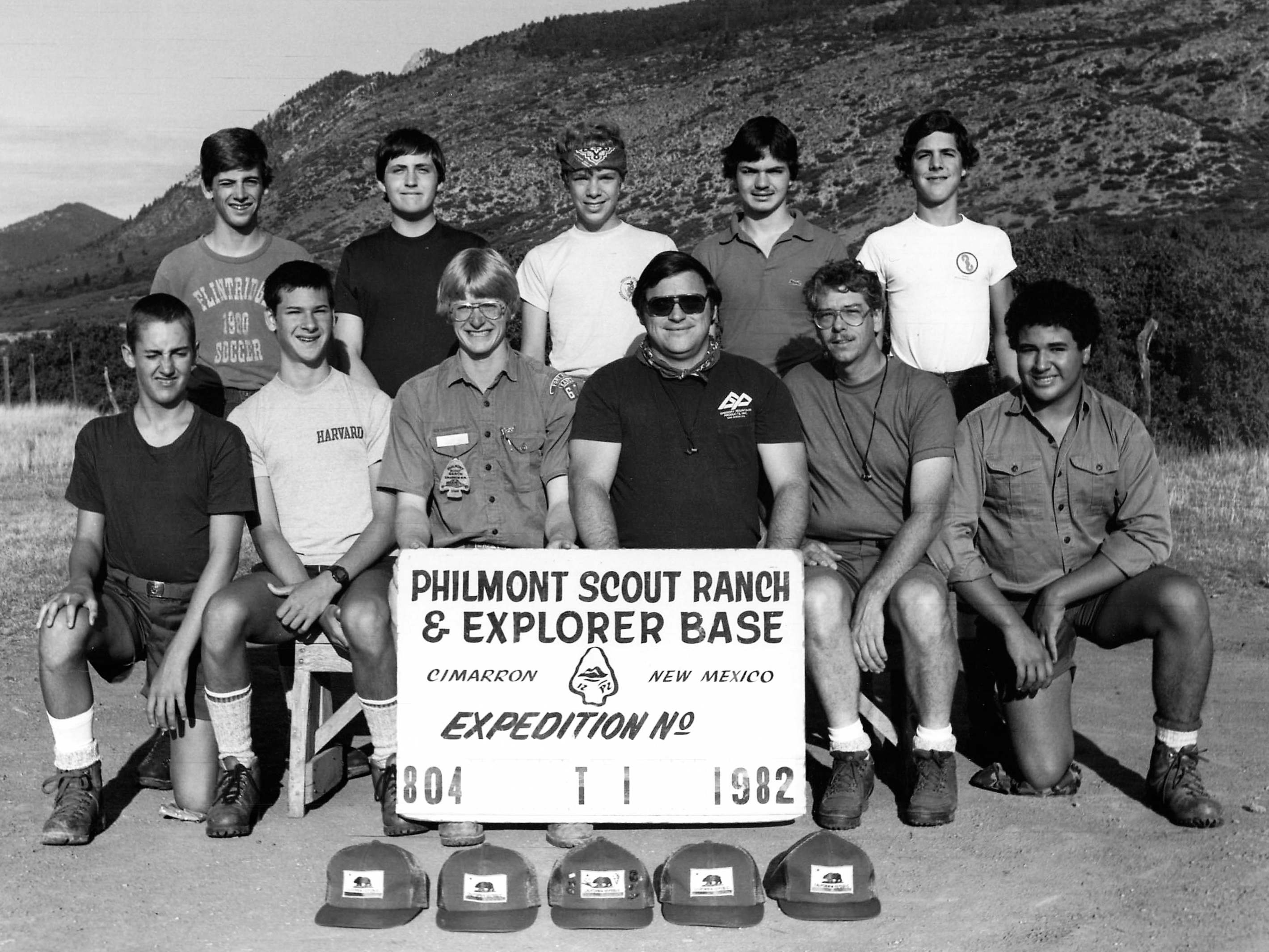
front l-r: scout from another troop, Darren Bell, ranger, 3 scouts from another troop back l-r: Bradley Craig, Doug Breckinridge, 3 scouts from another troop Aug. 4-11, 1982 We took the train to Philmont. |
Maine 1982 |
|---|
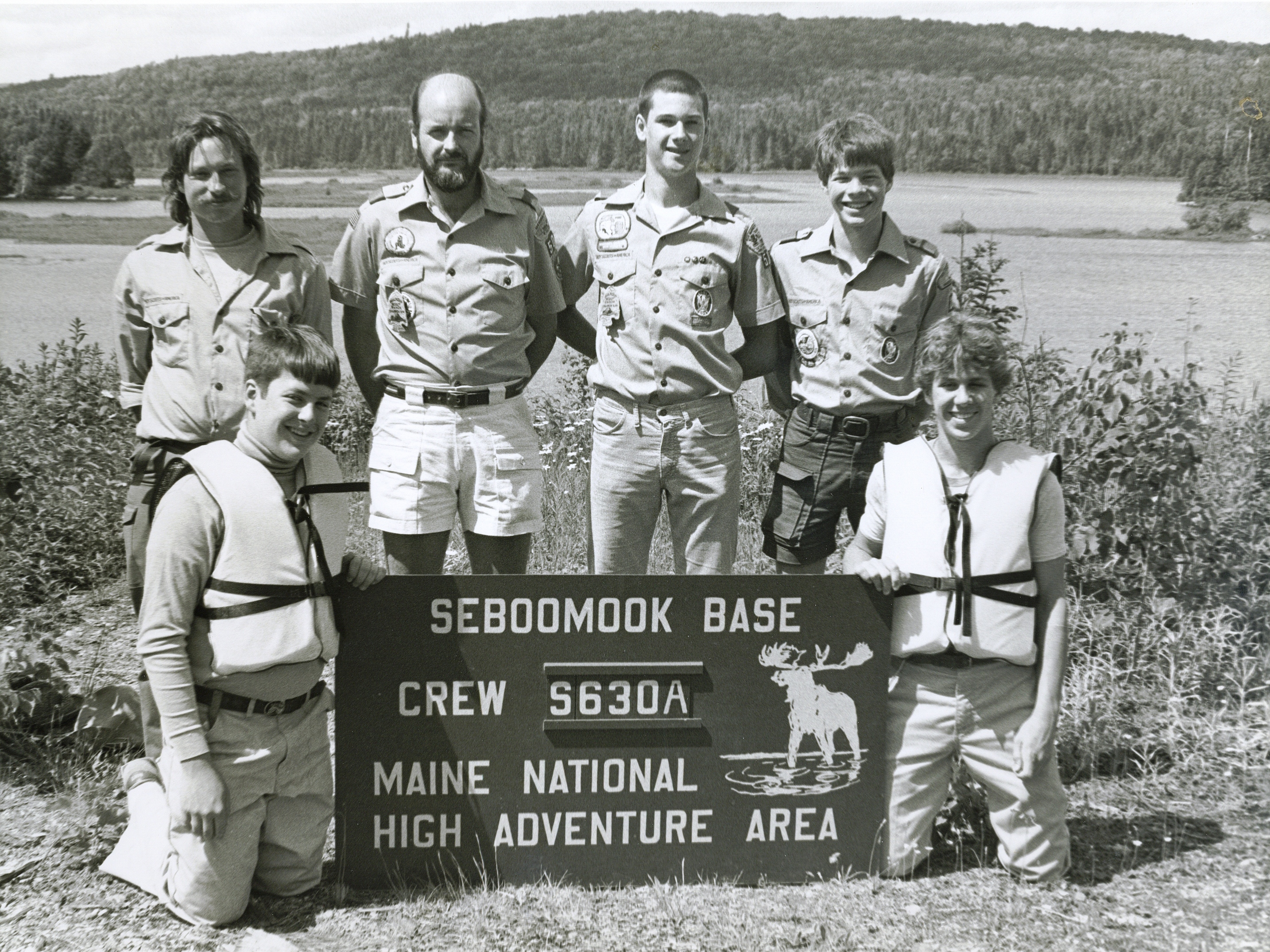
front l-r: __, __ back l-r: __, Mr. Mike Bell, Darren Bell, __ Jun. 30-Jul. 9, 1982 We flew and rented a car. We saw several moose and got eaten alive by bugs. |
Philmont 1981 |
|---|
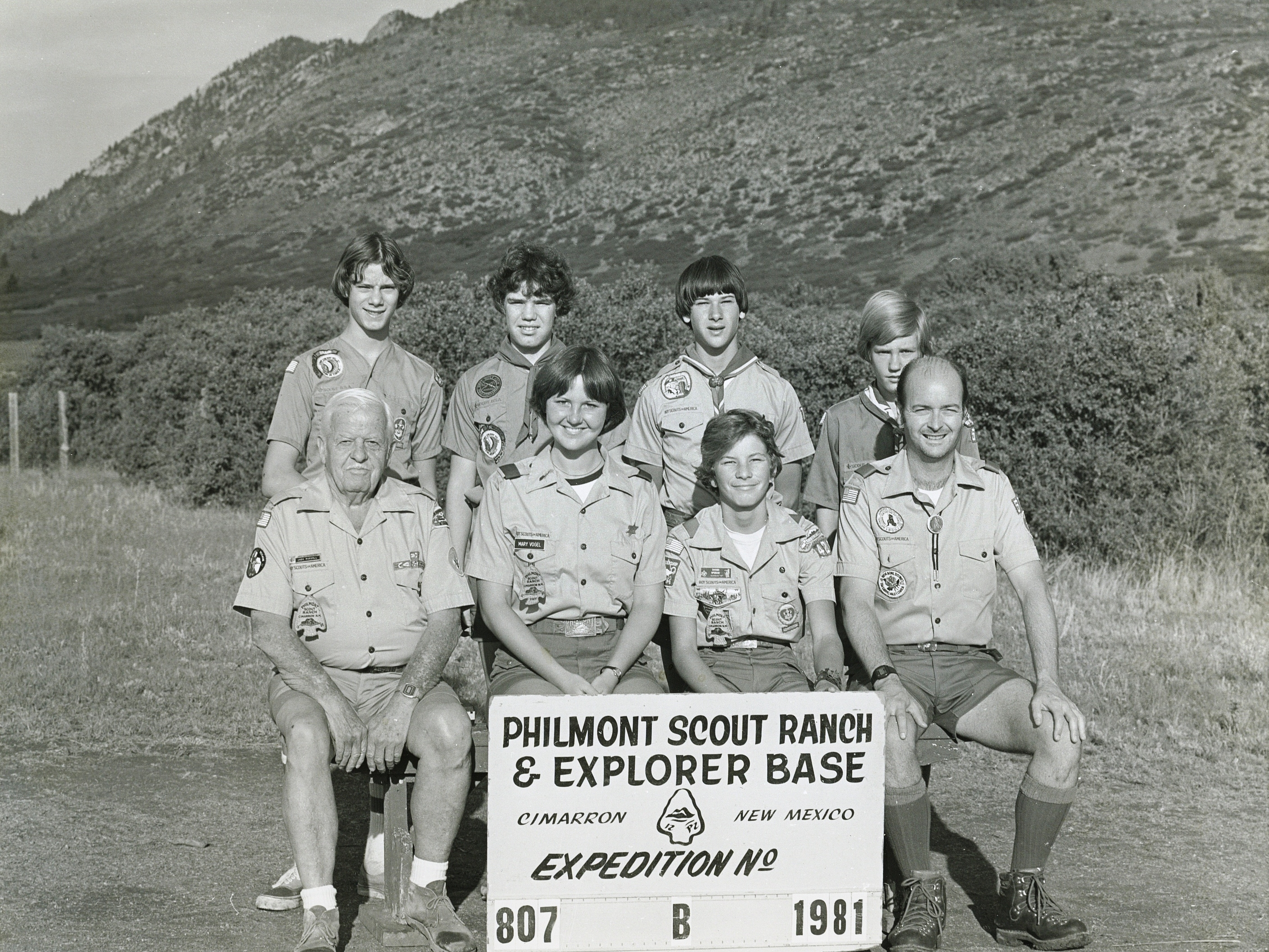
front l-r: Mr. Jack Russell, ranger Mary Vogel, scout from another troop, Mr. Mike Bell back l-r: Shawn Crowley, Dale Ryken, Darren Bell, Kevin Stanford 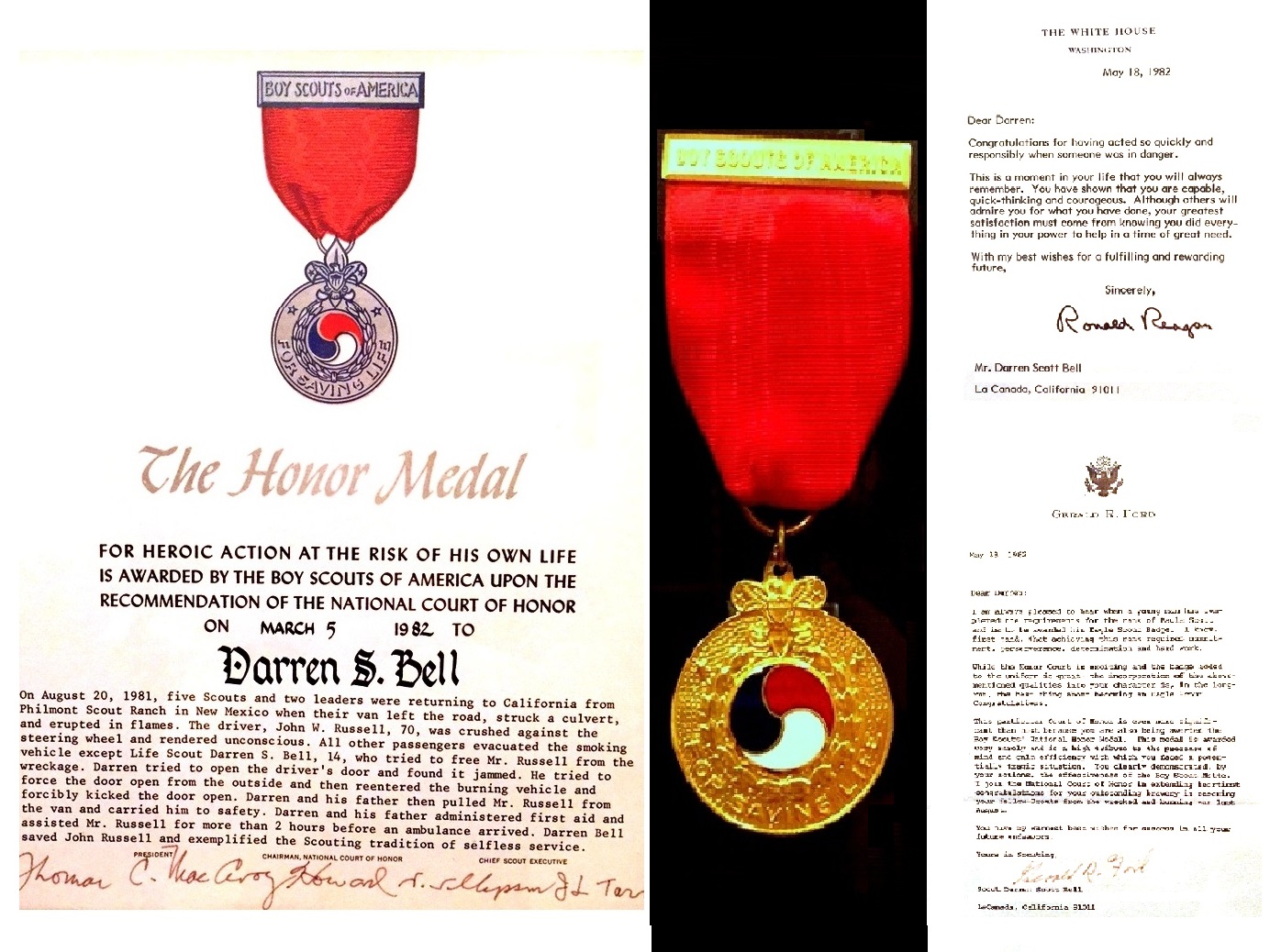
Aug. 5-20, 1981 We drove a van to Philmont. On the way back, on Hwy 66 outside Needles after lunch, the van left the road, struck a culvert and erupted in flames. The 70-year-old driver was unconscious and crushed against the steering wheel. The passengers evacuated the vehicle, except for 14-year-old Darren Bell, who first tried to free the driver by pulling on the jammed driver's door from the outside, then by re-entering the vehicle and successfully kicking the door open from the inside. Darren and his dad then pulled the driver from the van and carried him to safety, administered first aid and assisted him for two hours while awaiting an ambulance. The highway was shut down so a CHP plane could land to provide assistance. The five scouts and two adults were taken to Barstow Hospital. The driver had a badly broken leg and multiple facial fractures, Darren's dad had two fractured vertebrae, and the scouts were bruised and battered, including Darren's bloody nose and bloody mouth cut by his braces. All the van's contents were lost in the fire, except for their Philmont medical records which somehow blew to safety from a folder in the center console. BSA's National Court of Honor later awarded Darren its Honor Medal, for scouts who "demonstrated unusual heroism and skill or resourcefulness in saving or attempting to save life at considerable risk to self." Darren also received letters of commendation from President Reagan and former President Ford. |

